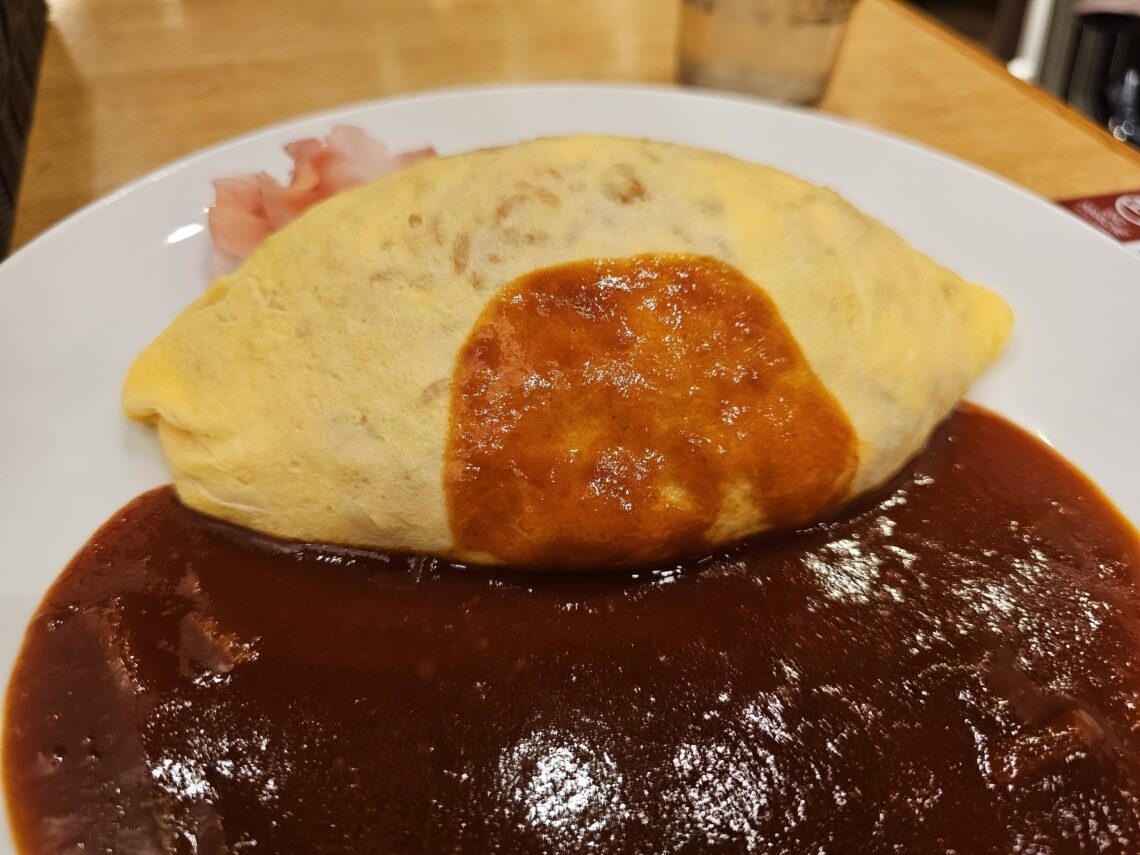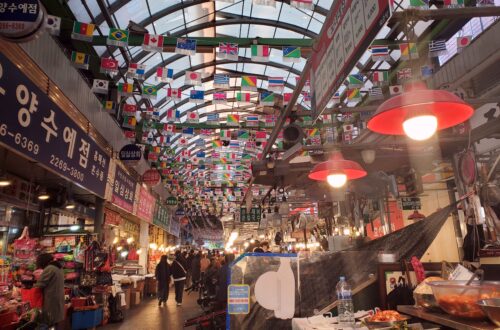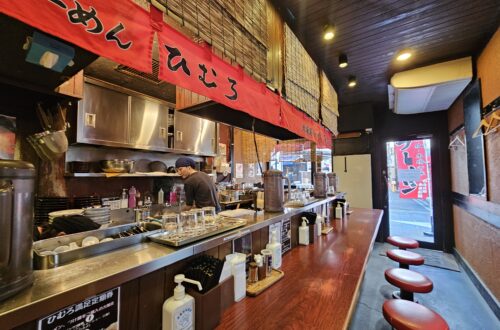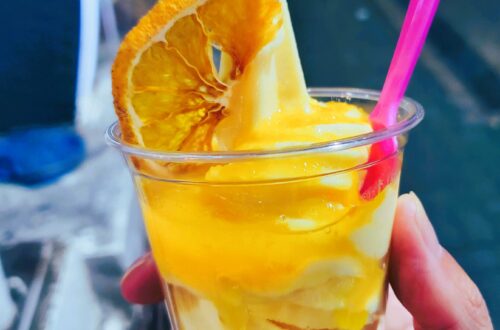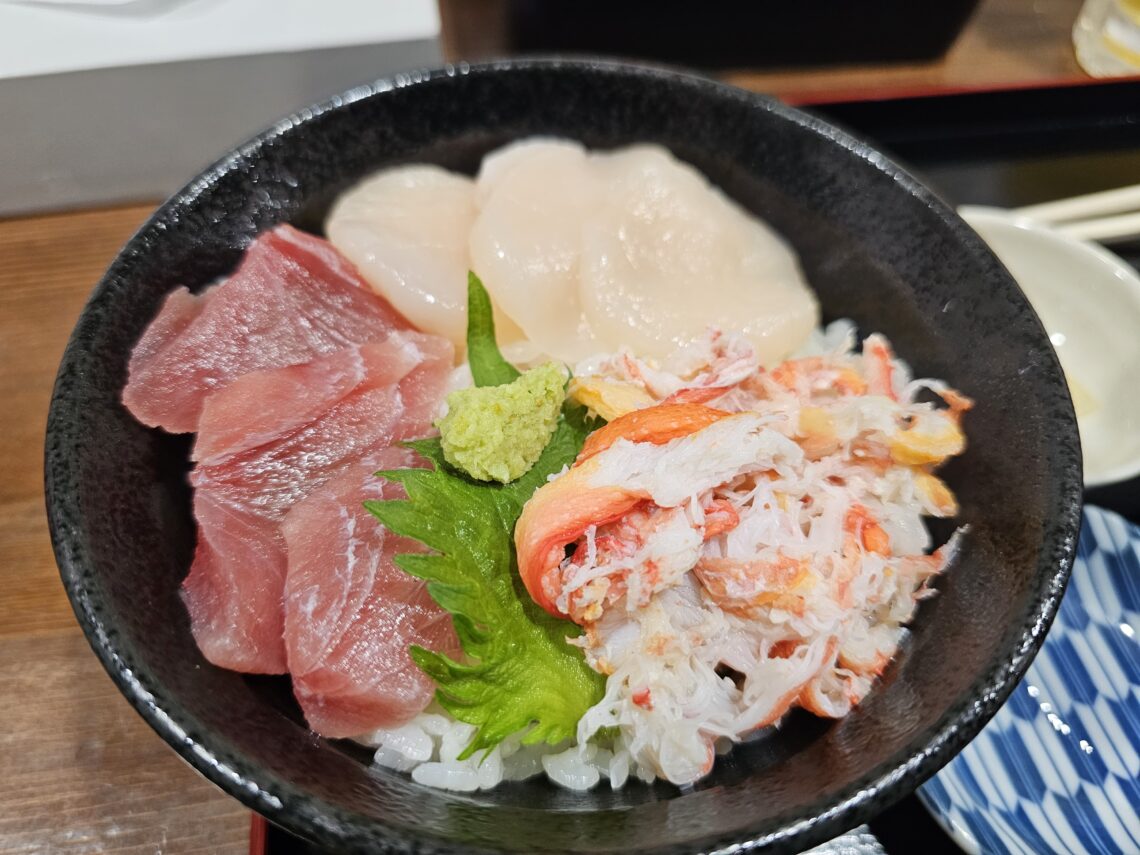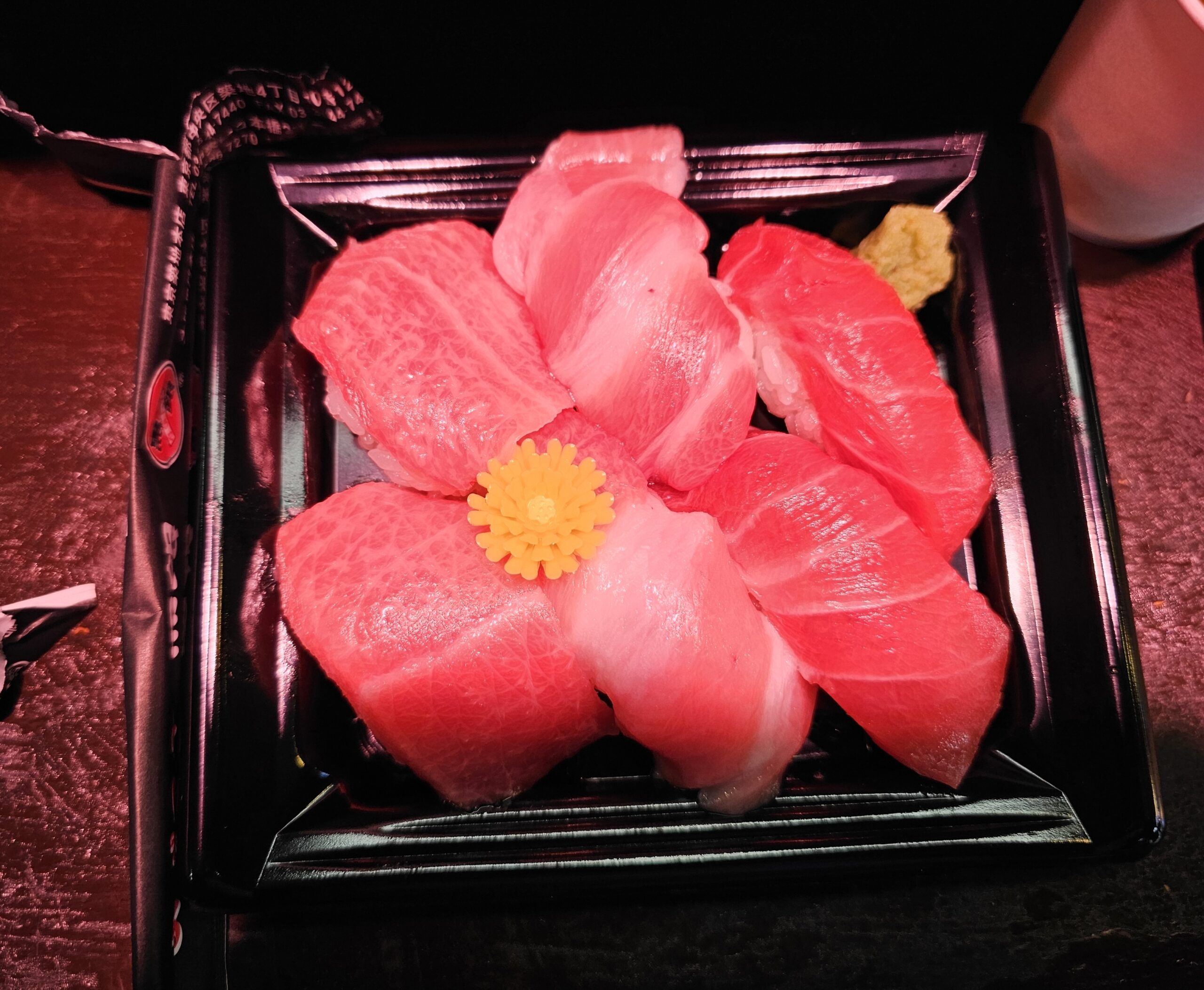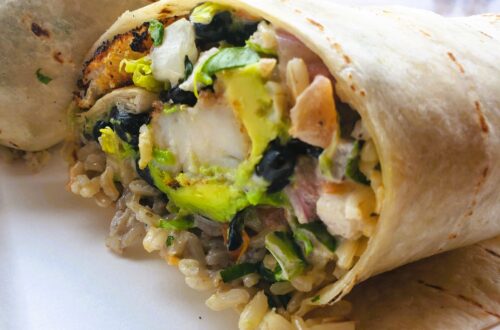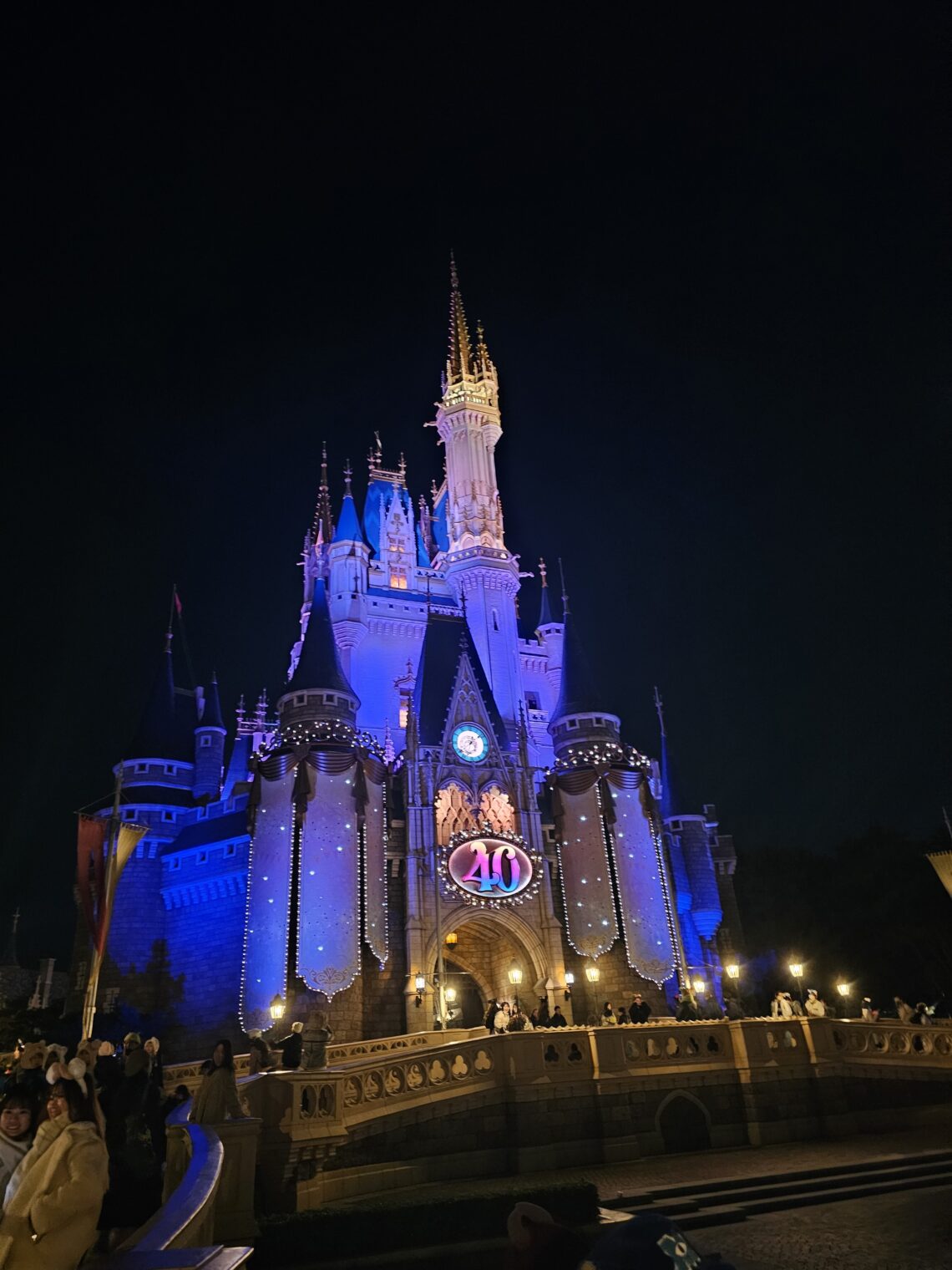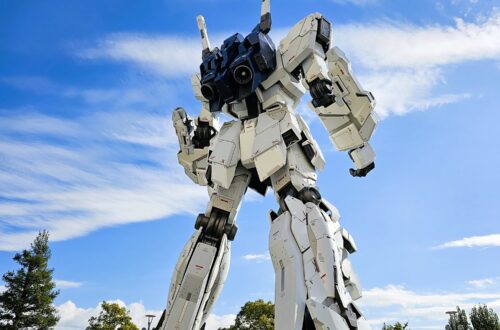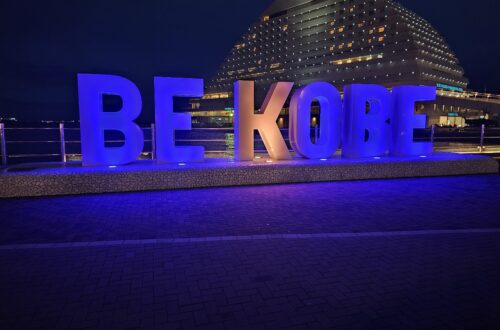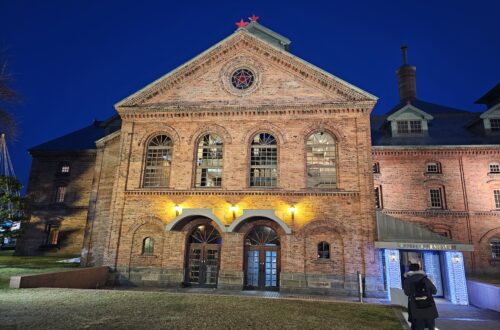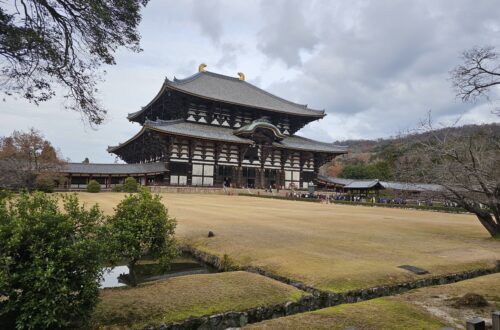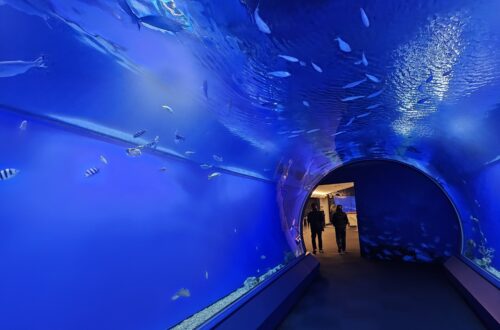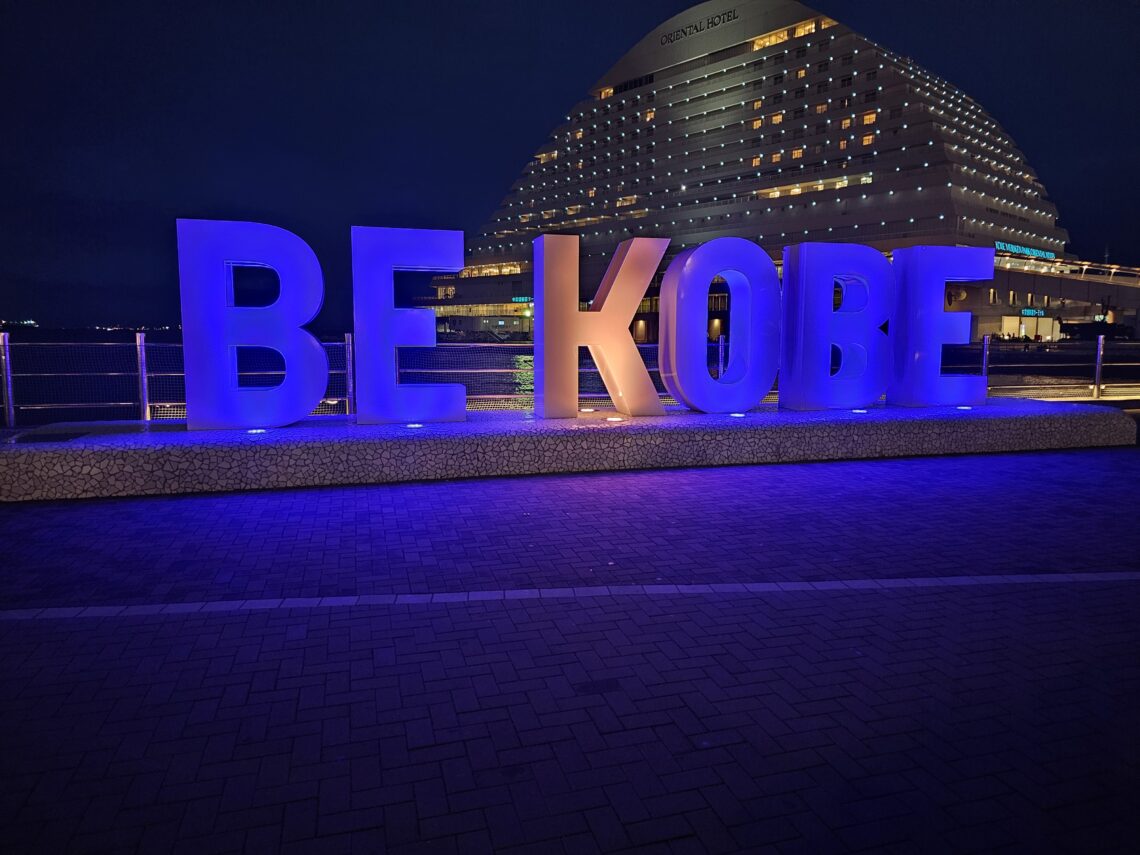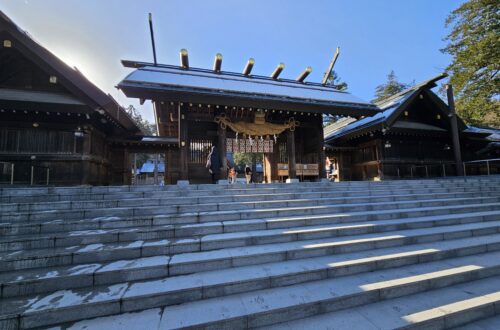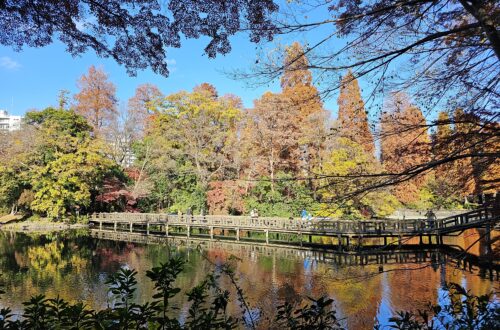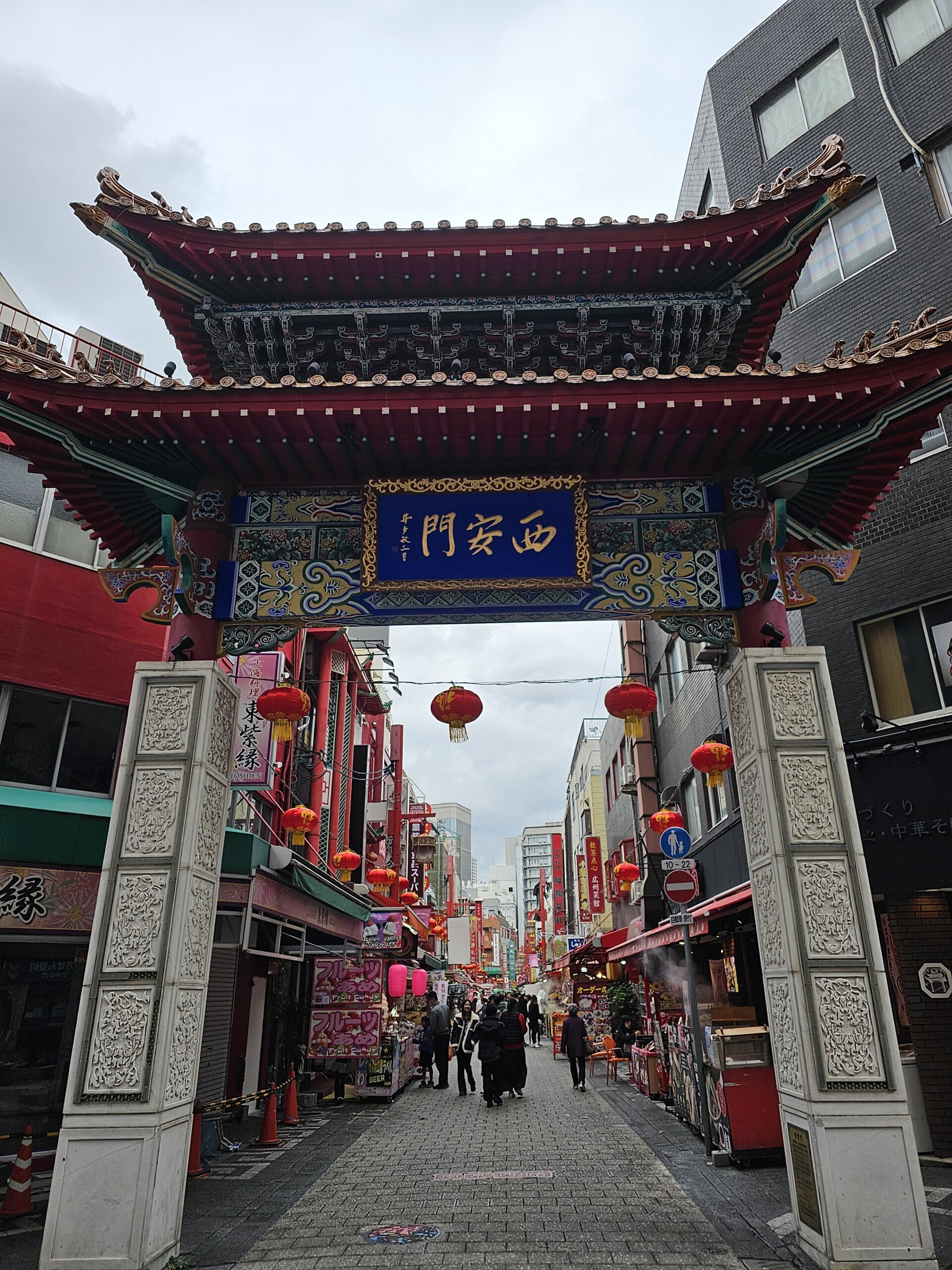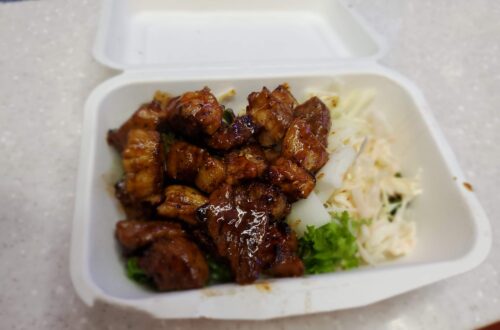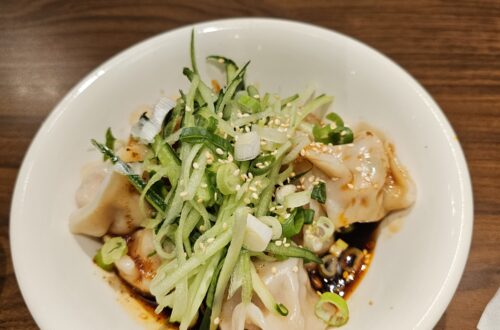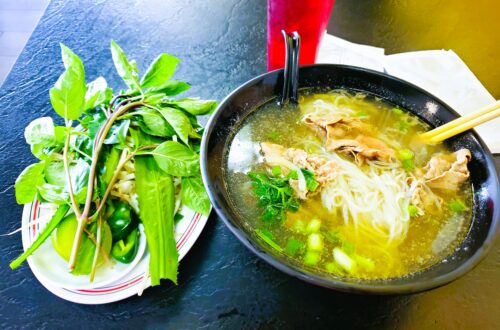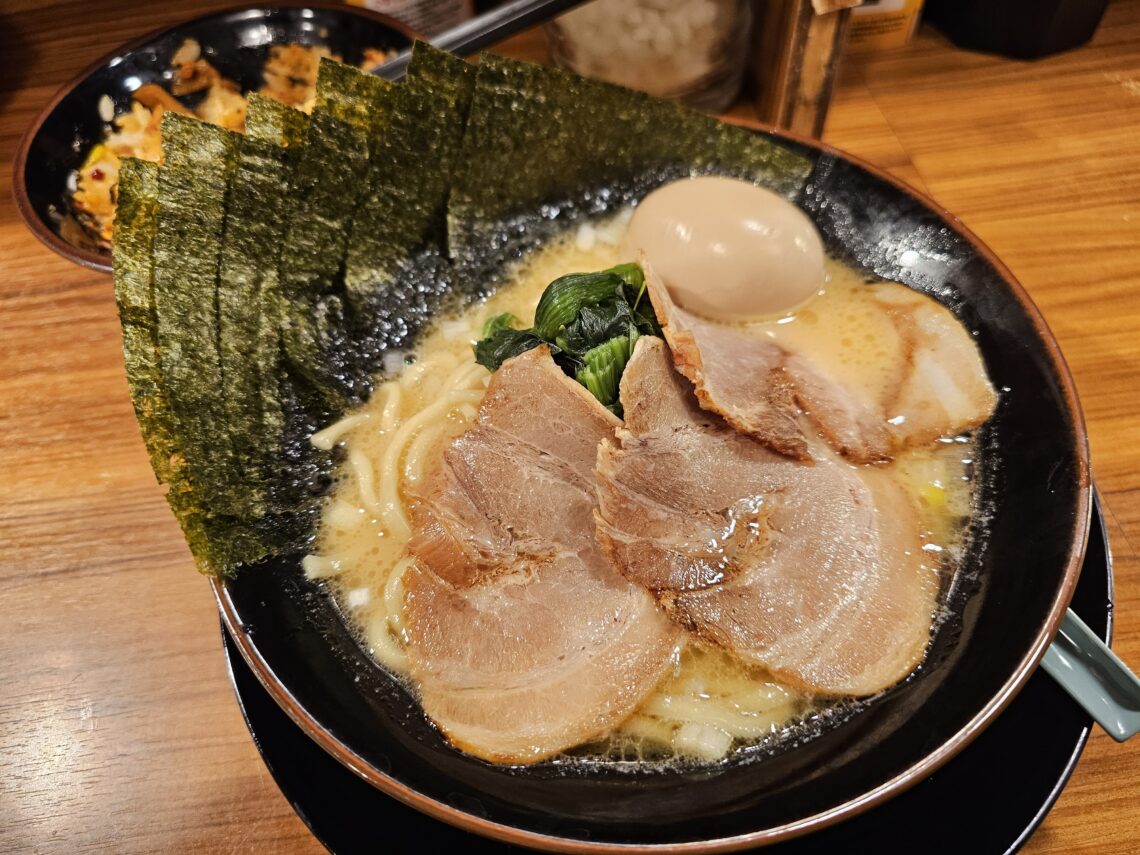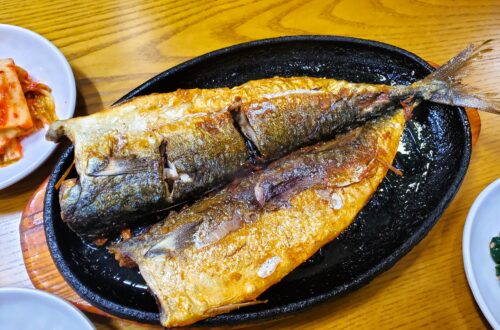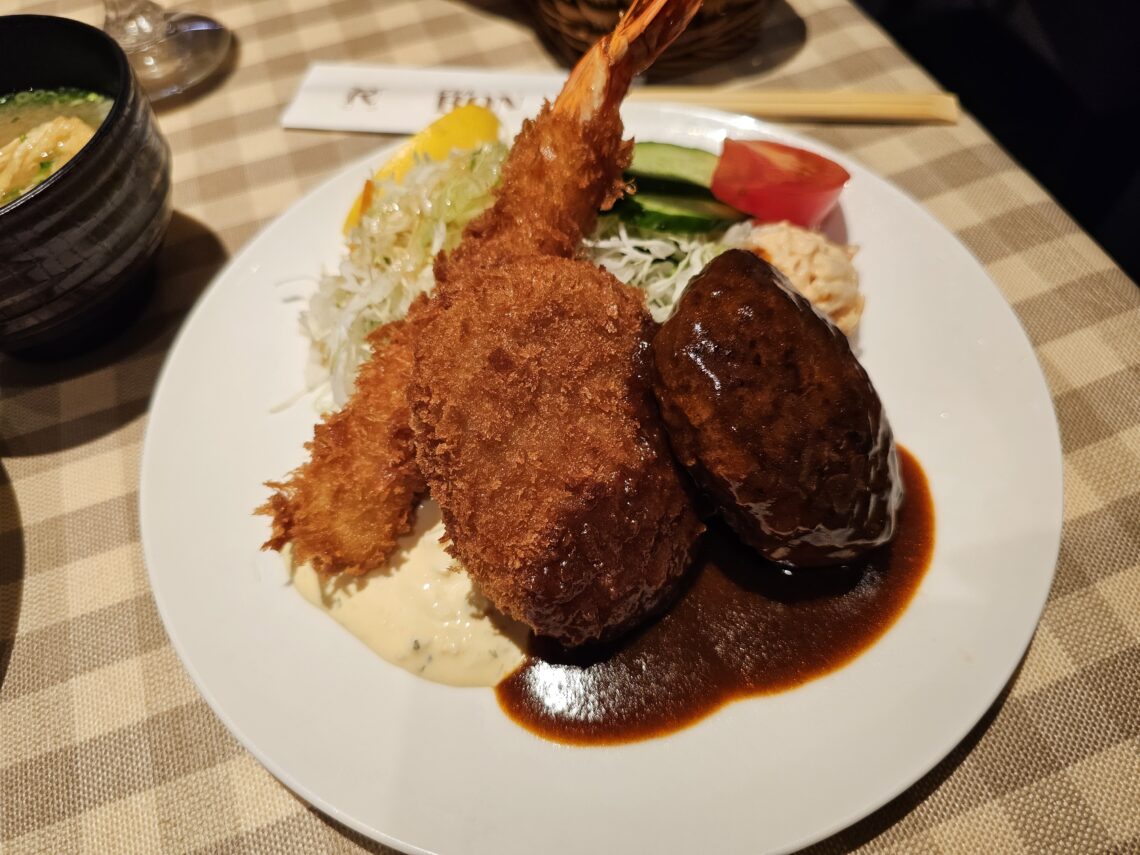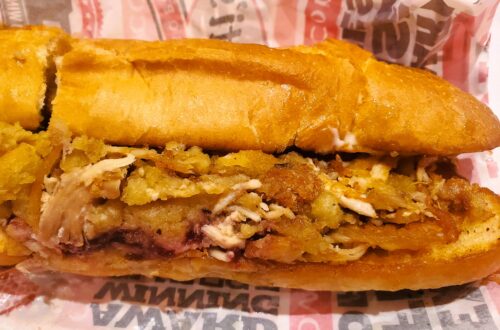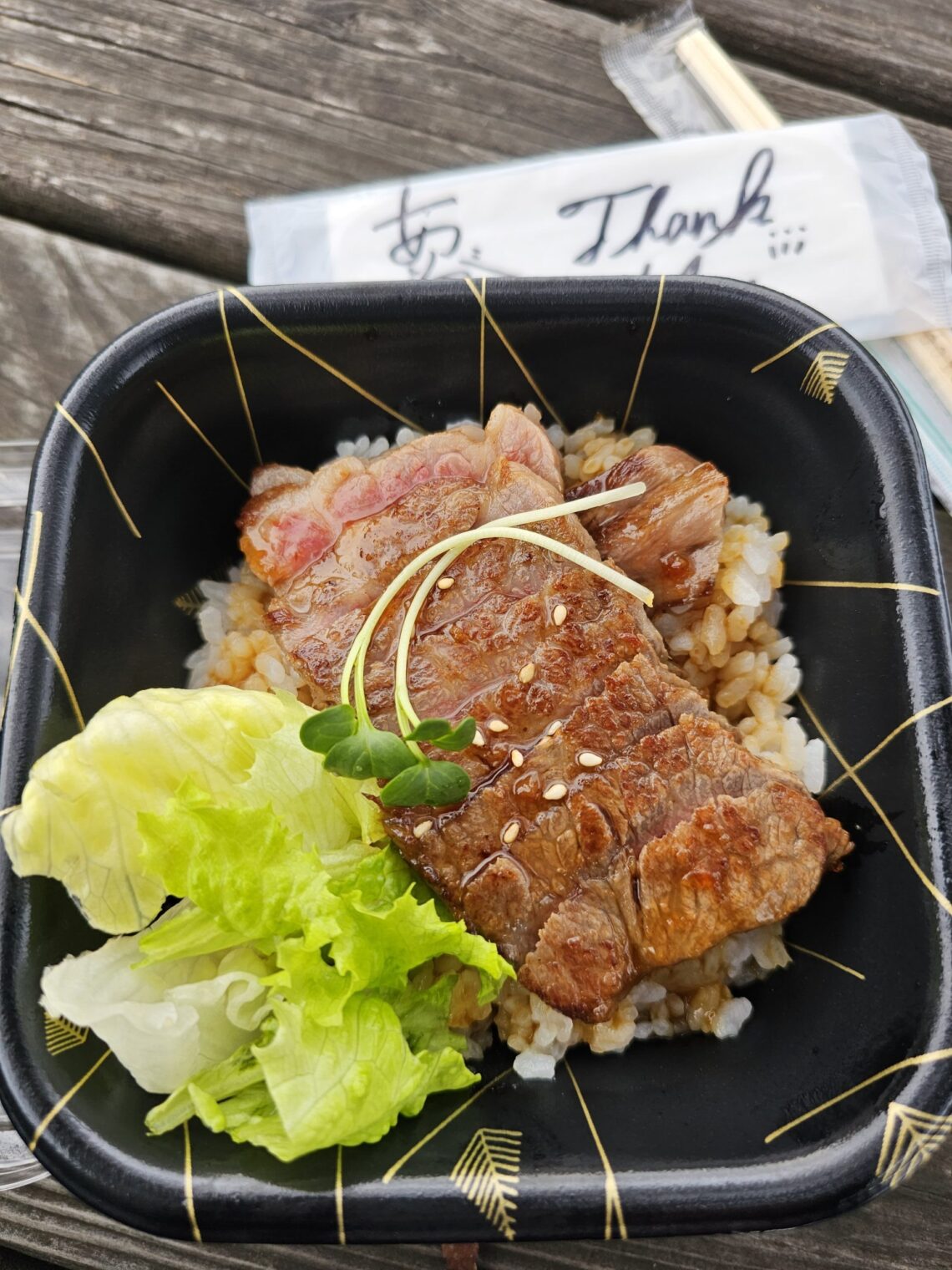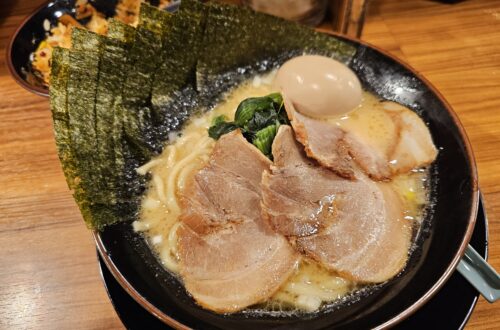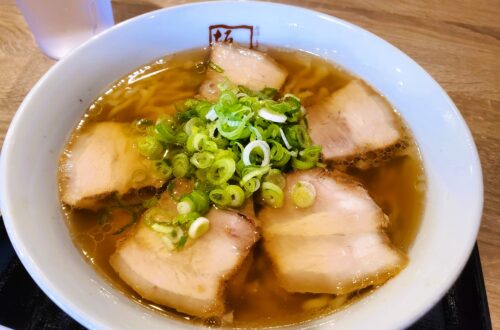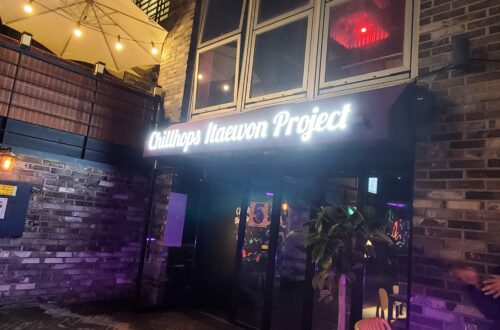-
Shin-Osaka Station: Great Food Options to Try While Waiting for Your Bullet Train
If you’re taking a bullet train out of or into Osaka, you will end up at Shin-Osaka Station. Fortunately, there’s a number of restaurants and places to grab snacks at here. I was at Shin-Osaka Station a couple of times and ate at two of the restaurants there.
Hokkyokusei at Shin-Osaka Station
Hokkyokusei is a restaurant that specializes in omurice. A Western influenced dish, omurice is a very common and popular Japanese dish. The beloved dish traces its history all the way back to the early 1920s. Its origin is a bit hazy, with some believing it started in Osaka, while others claim a restaurant in Tokyo was the first to offer the tasty dish. Regardless of its origin, omurice is now a national dish and another iconic food in Japan.
Omurice includes ketchup fried rice, yes ketchup fried rice, wrapped in a very thin omlette with ketchup drizzled over the egg. The egg is very crepe like, it’s a very thin layer. The ketchup fried rice is generally mixed with chicken and vegetables.
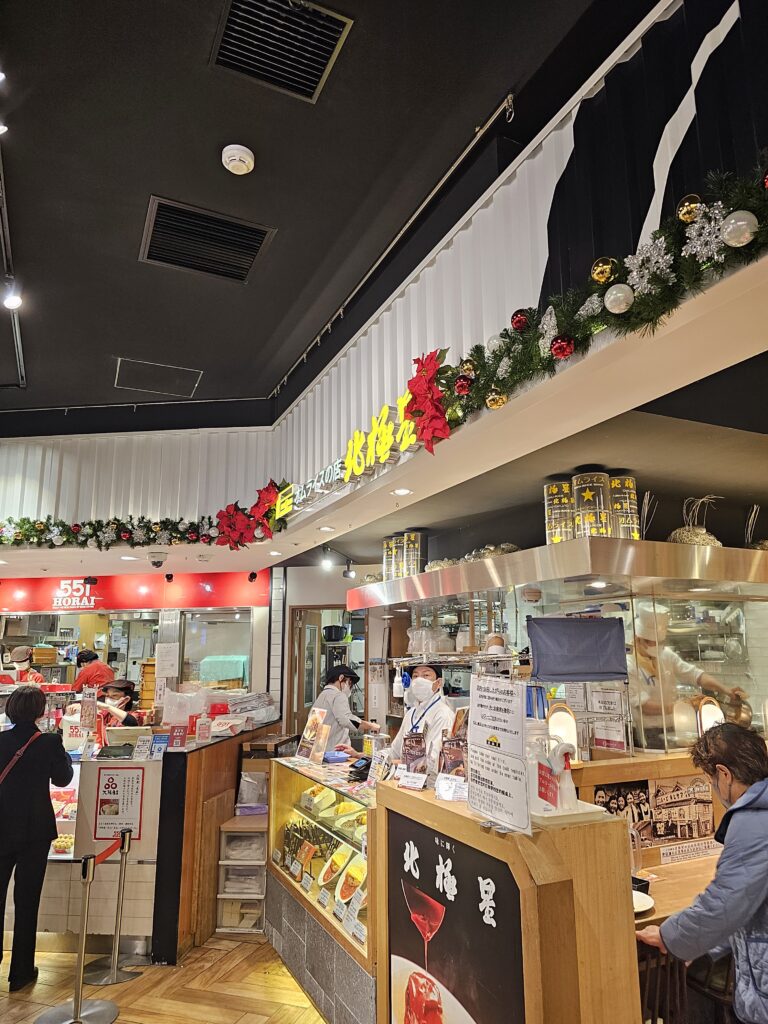
The Omurice
The omurice I got was the traditional chicken fried rice encased in the thin crepe like egg (970 yen, $6.65 USD).
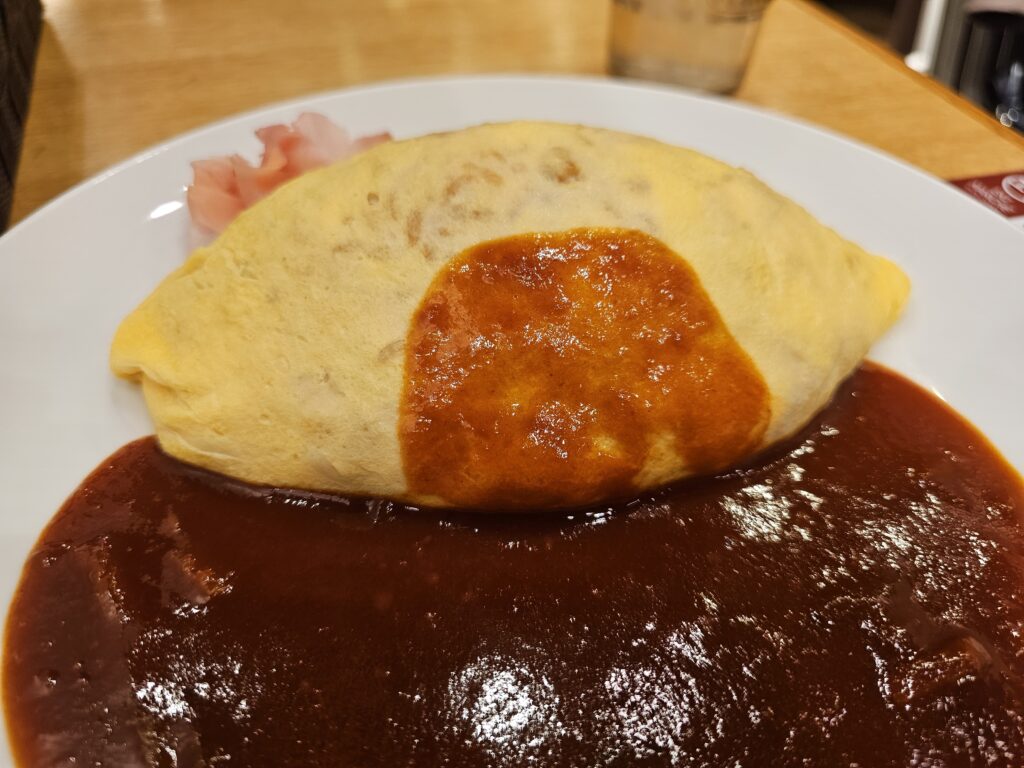
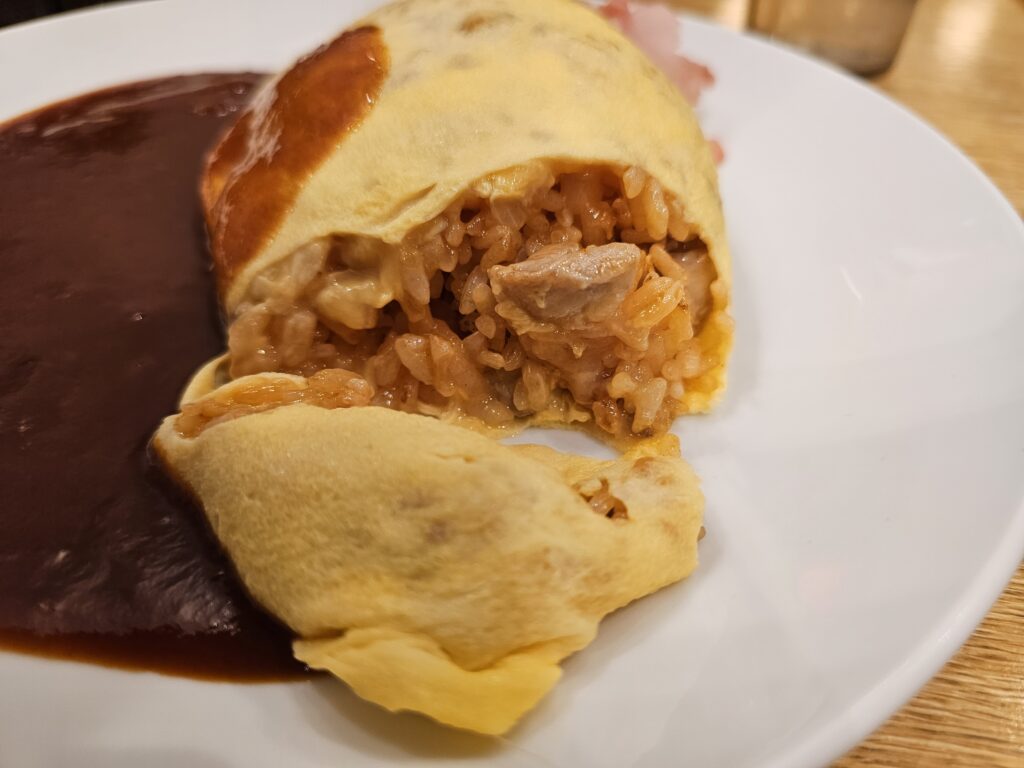
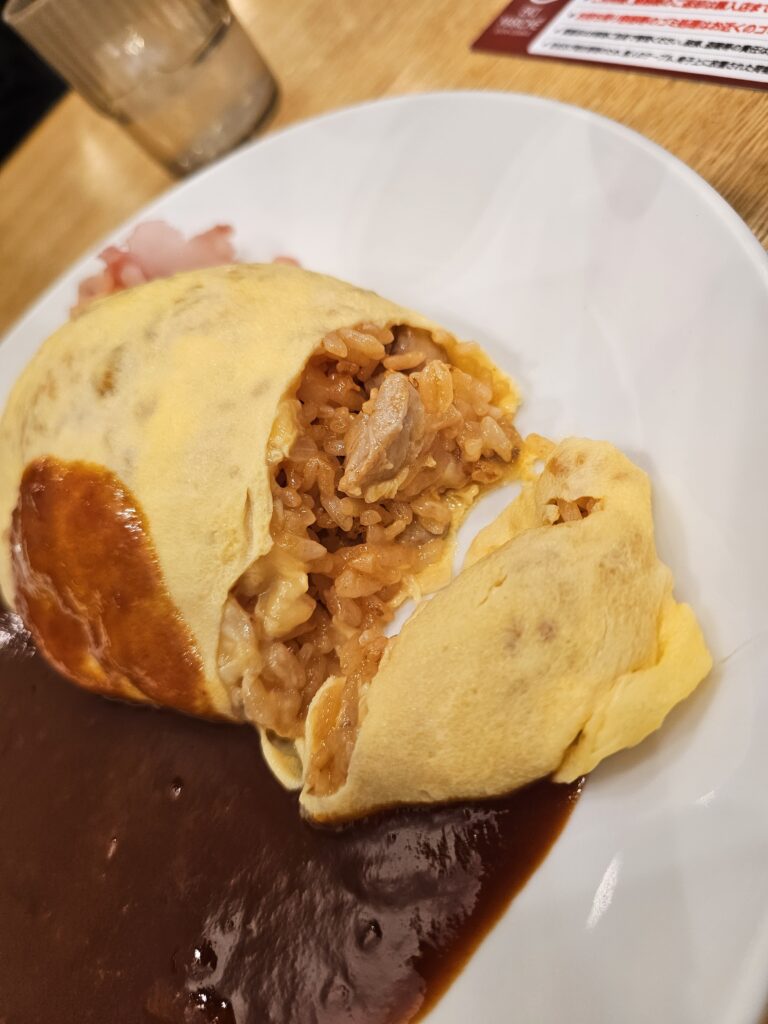
This came loaded up with chicken fried rice. A little sweet, a little savory the pieces were nice and tender as well. The sauce drizzled on the plate was pretty much like a thinner, bitter ketchup. Interesting flavor to it.
Despite the omurice being loaded to the gills with fried rice, this was stll a very light meal. The egg is so light and airy. I really have no idea how they’re able to wrap the rice inside of it like they do. It seems so delicate and easy to rip. This was my first experience eating omurice and it was definitely an enjoyable breakfast. It’s certainly something I’d enjoy trying to make in the future myself. I doubt the presentation will look as good as this though!
Dashi Chazuke En at Shin-Osaka Station
Dashi Chazuke En is a chain restaurant in Japan that is know for serving ochazuke with various toppings over it.
What exactly is ochazuke? It’s a simple Japanese dish that includes a bowl of cooked rice with hot tea or dashi poured over it. You add toppings such as Japanese pickles, nori (seaweed), salted fish, and really any other topping which sounds appealing to you, you can throw in there!
This is something that I’ve eaten with my family after certain Japanese meals, essentially my entire life. We use the rice left over from the meal for it and pour tea over it and eat with pickled vegatables.
I’ve never seen ochazuke in any restaurant in my life before so I was actually quite excited to see there was a restaurant in Shin-Osaka Station whose menu tilted towards serving the dish.
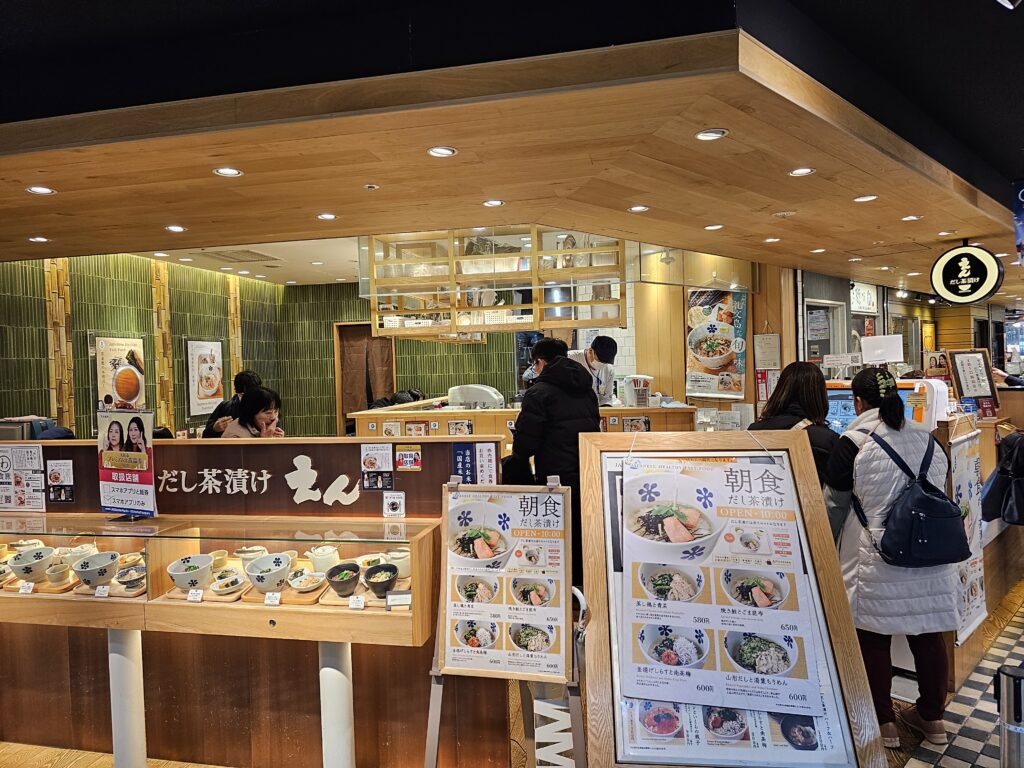
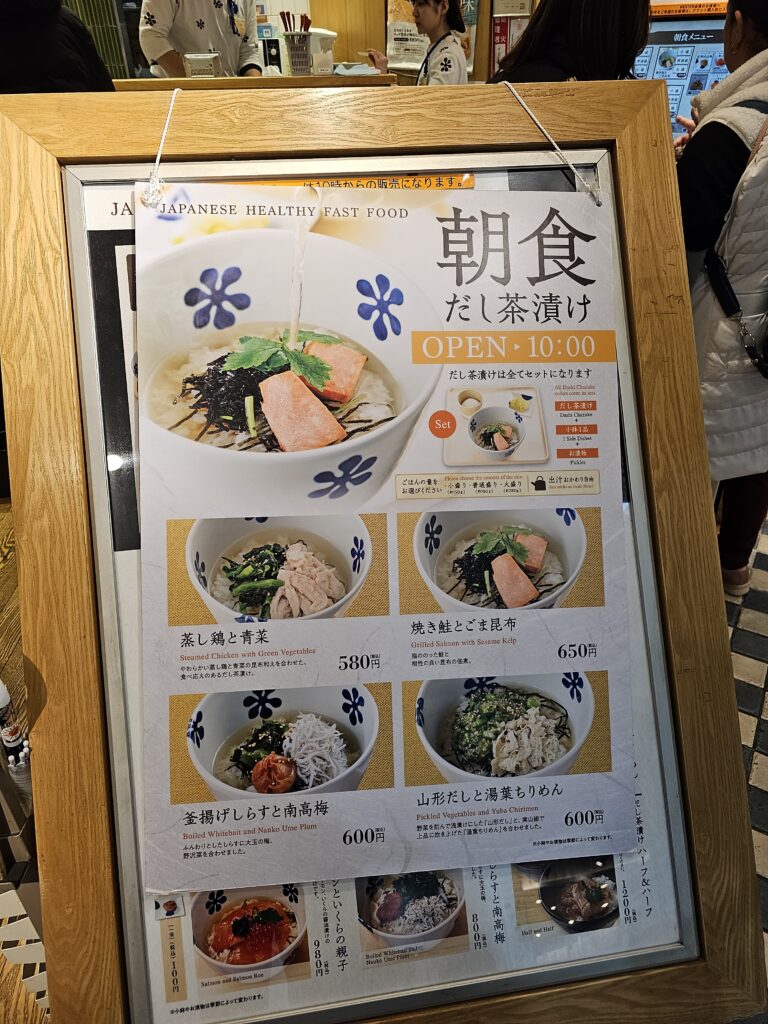
It was definitley helpful that the menu was in English as well. I went with the grilled salmon and sesame kelp option (650 yen, $4.10 USD). This little meal set comes with the bowl of ochazuke a couple of side dishes and some pickled vegetables. You get your own personal teapot and pour the tea in yourself. There’s also a seasoning packet provided that you can pour into the ochazuke to add some additional flavor.
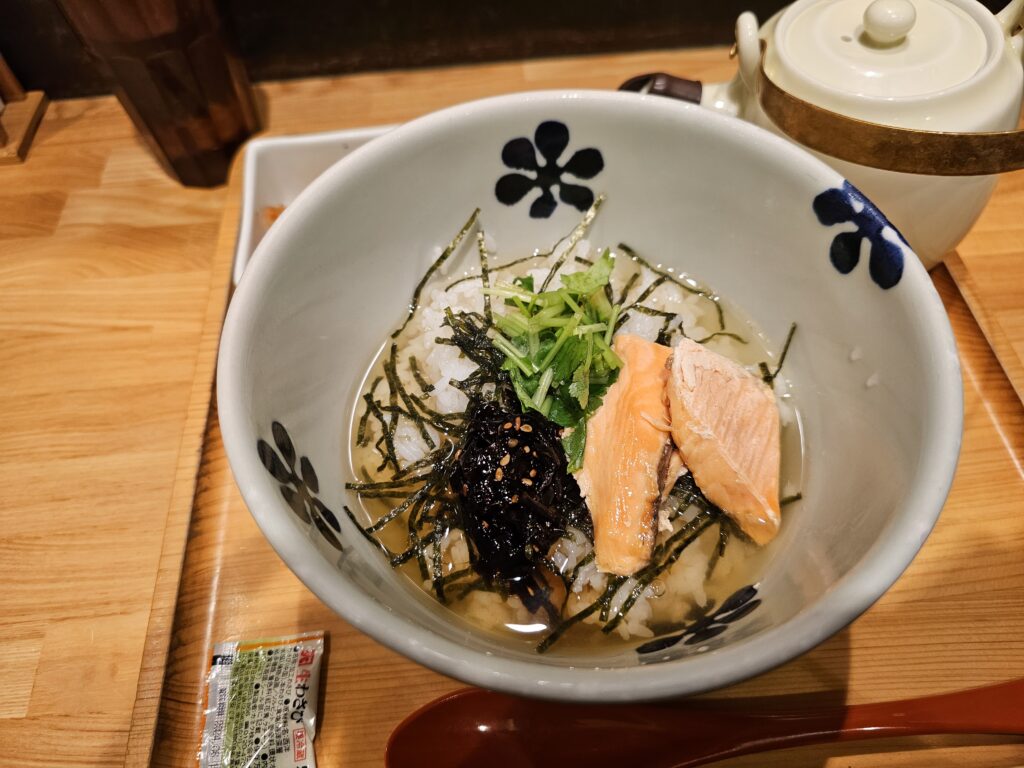
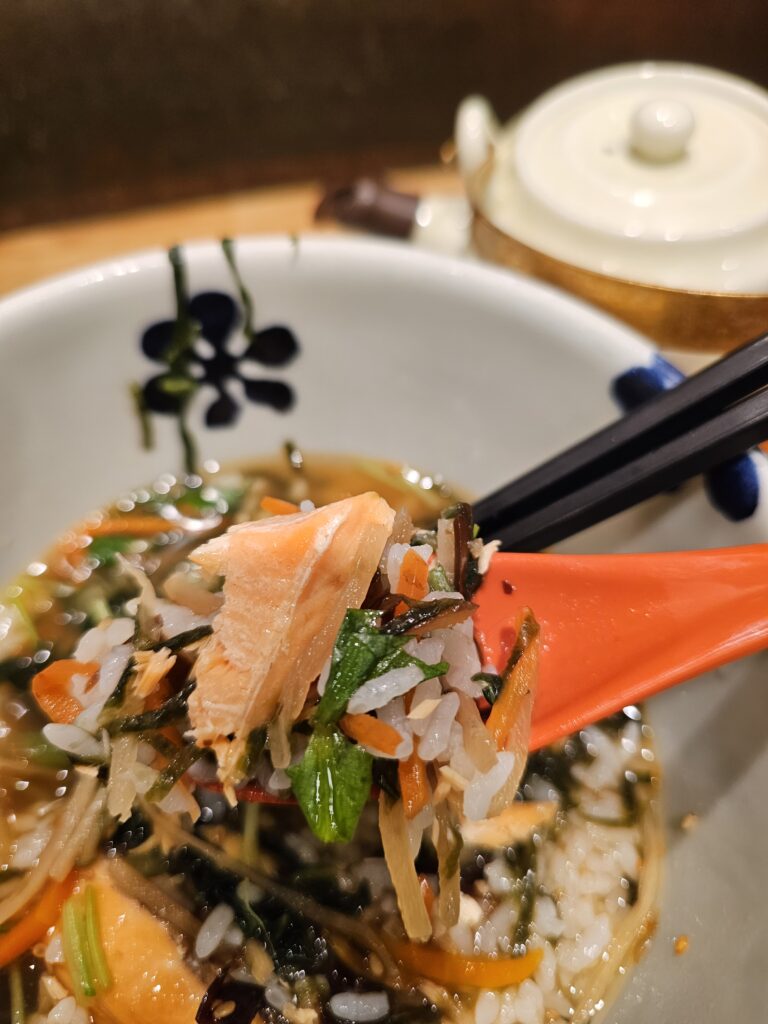
I dumped in all the side dishes and pickles as well. It all combines to make what could be considered a type of stew. With rice, salmon, pickled vegetables, there’s a whole lot of different textures to enjoy with this meal. This is definitley a comfort food for myself and it was great to be able to enjoy it in Japan. This was a perfect breakfast as I waited for my train. Light, yet filling, warm, and comforting, it was a great way to kick off the day and was extremely affordable as well!
A Lot Of Options
These are just two of the restaurants you can eat at. There’s about 10 total restuarants but over 36 total shops / restaurants / cafes within this area in the station. If you don’t want or have time for a sit down restaurant there’s a ton of places with pastries, sandwiches, sweets to choose from within Shin-Osaka Station. I wouldn’t necessarily worry about grabbing a bite to eat prior to heading over to the station, there’s plenty to choose from here!
-
10 Amazing Foods In Japan That Are A Must Try
There’s no question there’s a ton of unique attractions and sights to see while visiting Japan. It’s a truly beautiful, bustling country which never ceases to amaze me. One of the biggest draws of the country for myself is the food. To say the food in Japan is delicious would be an understatement. It’s absolutely amazing.
Here are some of the standouts that anyone visiting Japan must try!
Table of Contents
Mochi
Mochi is certainly one of the most 10 amazing foods in Japan. A traditional rice cake, mochi is chewy and has a chewy texture and can be either savory or sweet. It’s a versatile rice cake which can be filled with various fillings like red bean paste and have different types of toppings like fruit on top. The freshness, and how soft and chewy the mochi is in Japan really stands out. While mochi can be found worldwide, the mochi in Japan is on a different level!
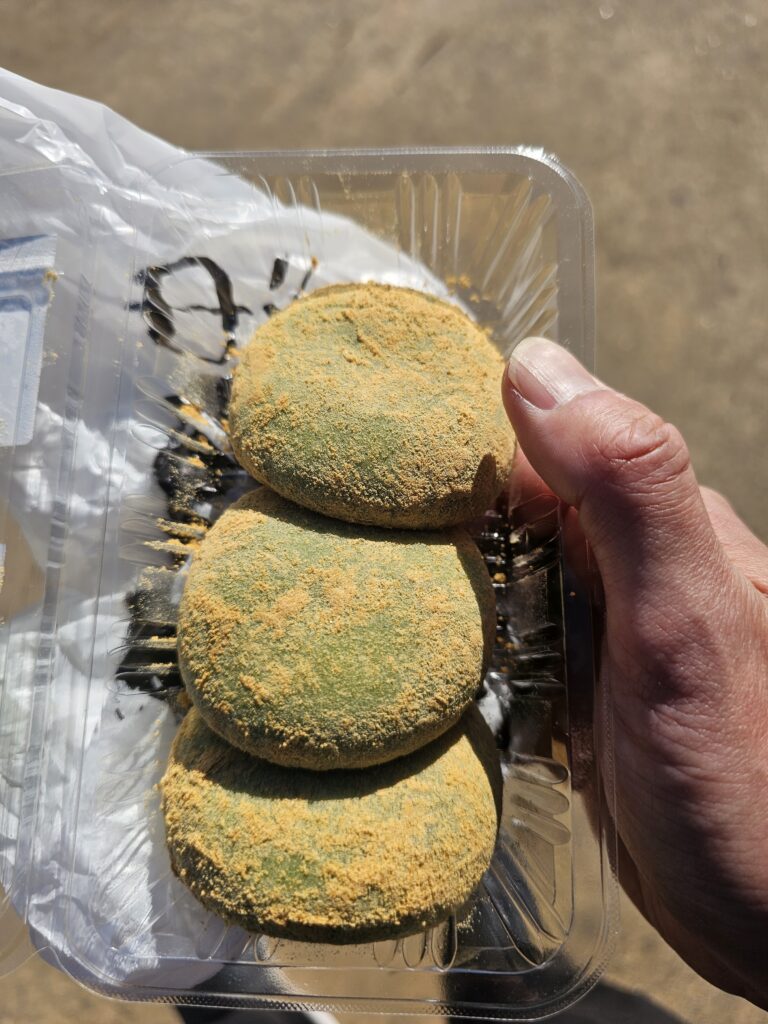
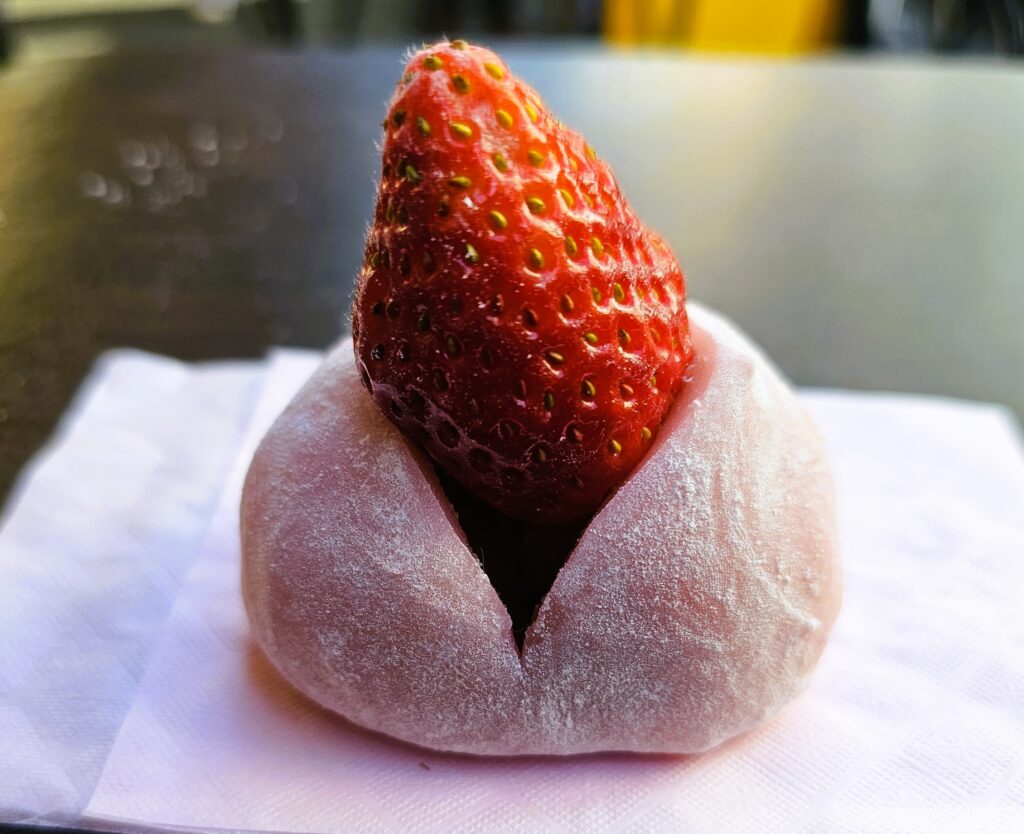
Ramen
Ramen is easily one of the top 10 amazing foods in Japan. Everyone knows ramen, let’s be honest. Ramen is everywhere in the world but it’s something that absolutely must be tried in Japan. The number of ramen places and different types of ramen are insane. The atmosphere itself, with many ramen shops just being a counter that seats 15 or less is a pretty cool experience. The ordering process, with the ordering machines in the front of some ramen restaurants is certainly an experience as well.
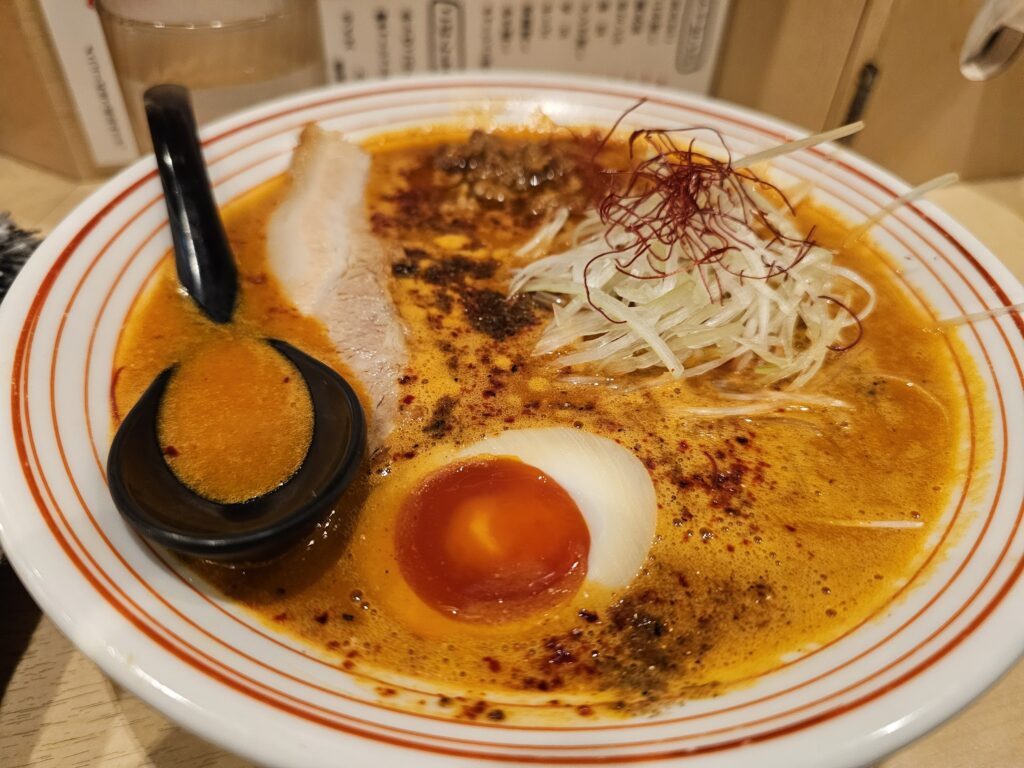
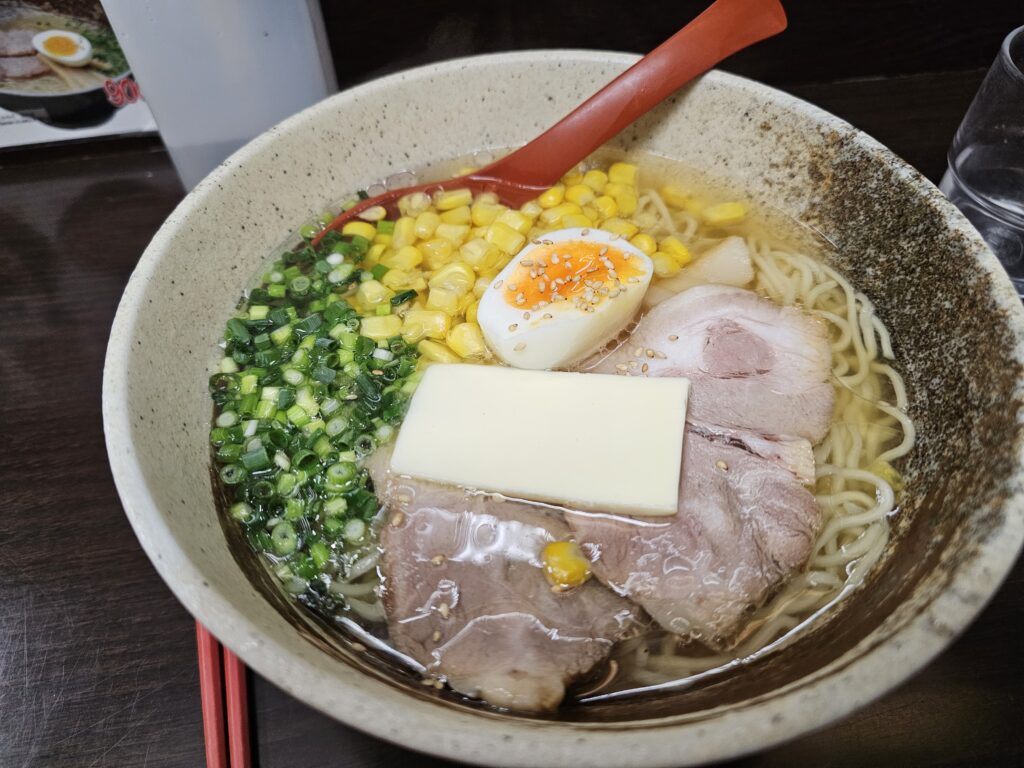
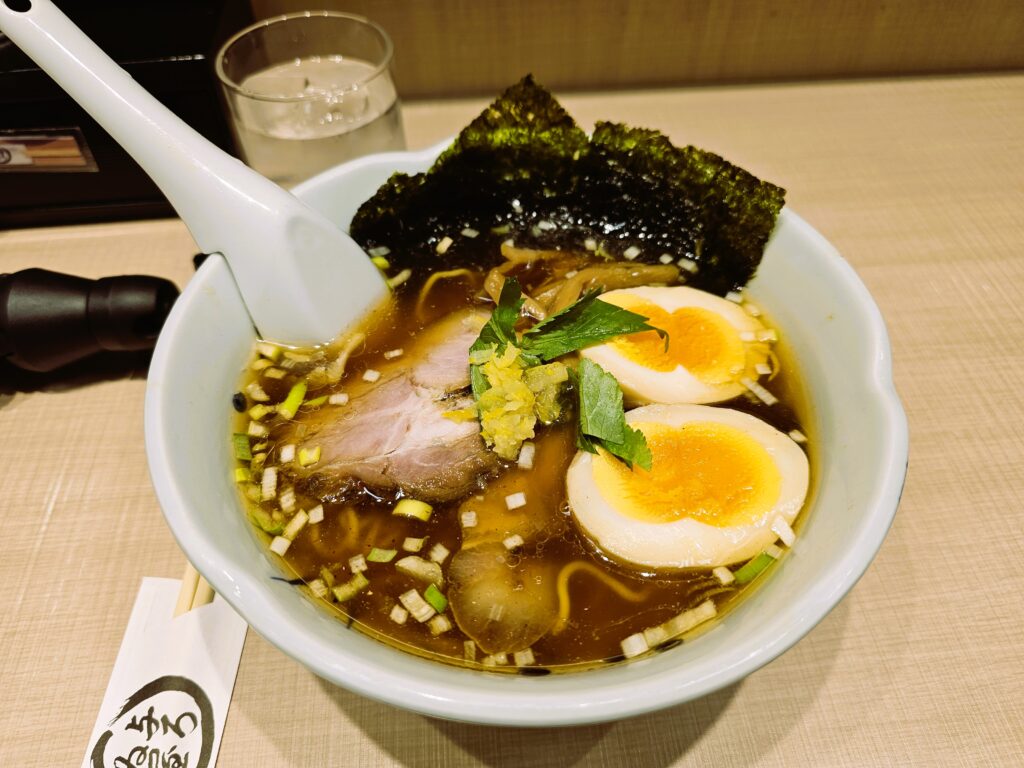
Sushi / Sashimi / Chirashi
Without a doubt, sushi in all it’s variations is one of the 10 amazing foods in Japan that you must have. Japan has some of the best quaility seafood in the world and the quality of the sushi / sashimi / chirashi certainly reflects this. Whenever I go to Japan I eat as much tuna as I possibly can. It’s the best tuna I’ve ever had. The crab, scallop, uni, it’s all outstanding. Whatever your fish of choice is, you will not be disappointed by the quality.
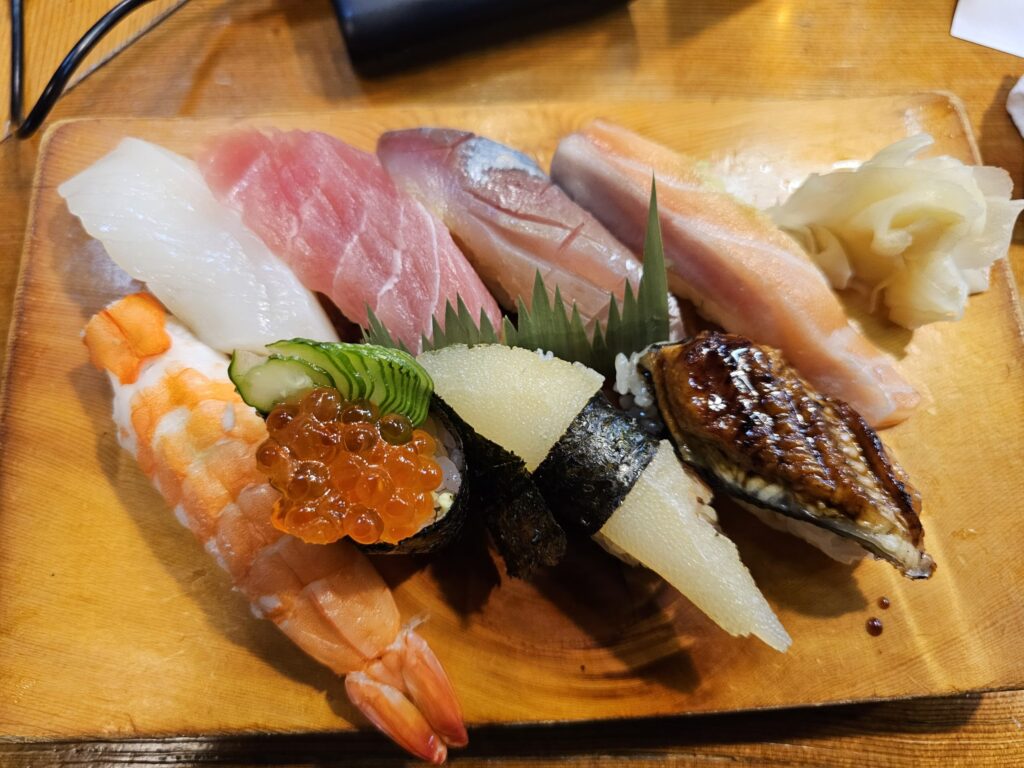

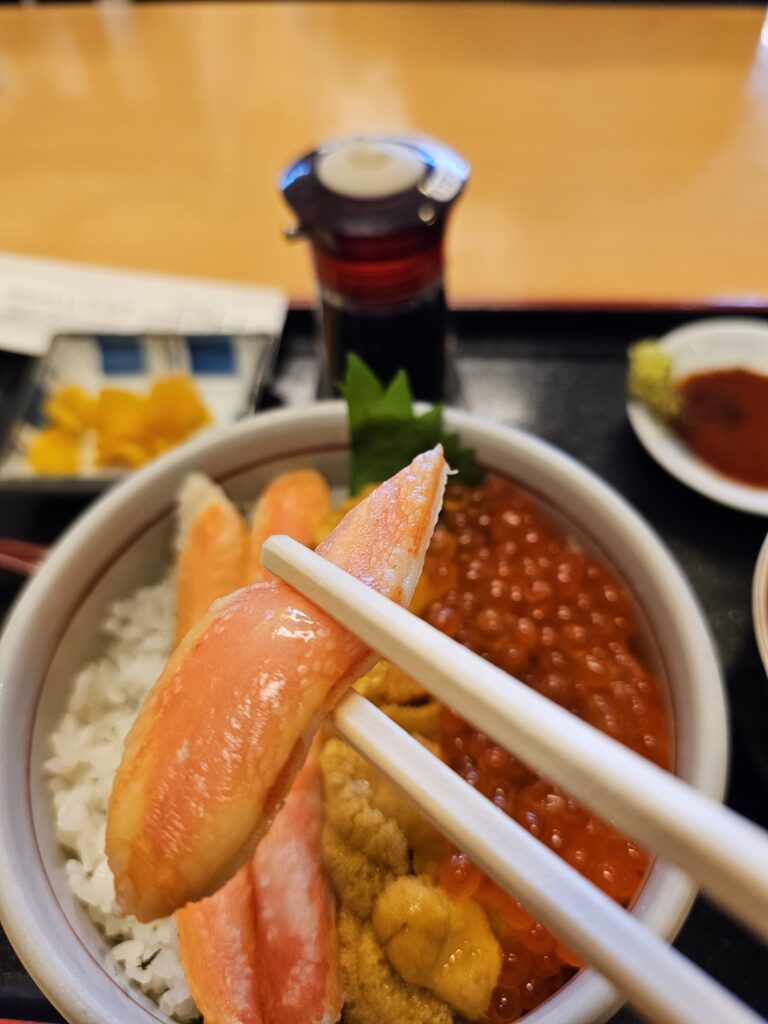
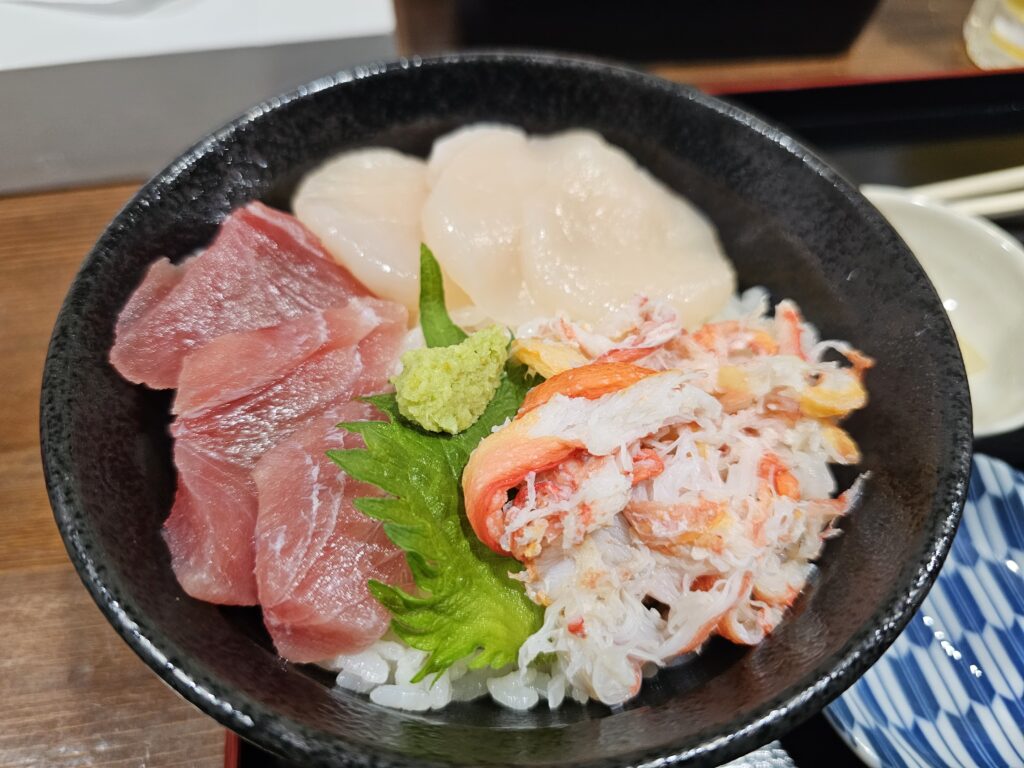
Fruit
Speaking of high quality, the fruit in Japan is on another level from what I’ve ever had in the United States. Quality takes precedence over quanity when it comes to Japanese fruit. Farmers are very attentive and closely monitor their crops to insure their fruit meets lofty standards in association with the fruit texture, sweetness, size, and shape.
These high standards, along with the country being smaller, which leads to less time for the fruit to make it from the farm to the store, leads to some exceptionally high quality fruit.
The melons and strawberries I had were the juiciest and sweetest I’ve ever experienced. With quality comes higher prices though. The fruit is definitely more expensive, but it’s well worth it. Fruit may not be on the radar as one the 10 amazing foods in Japan, but it certainly deserves to be!
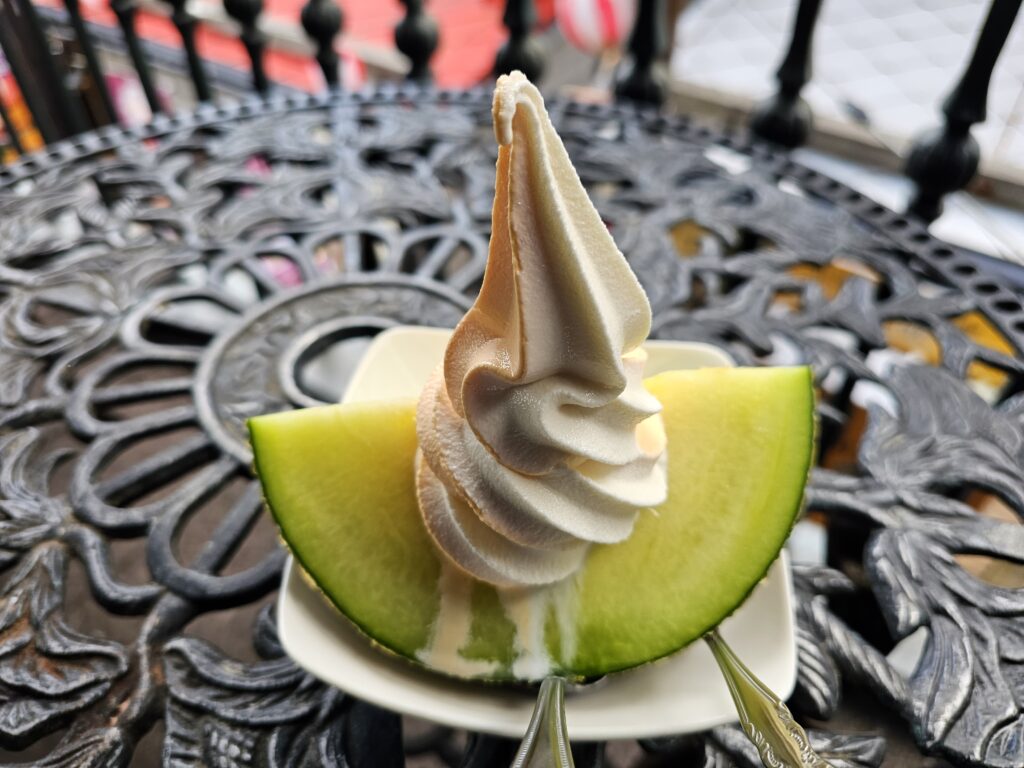
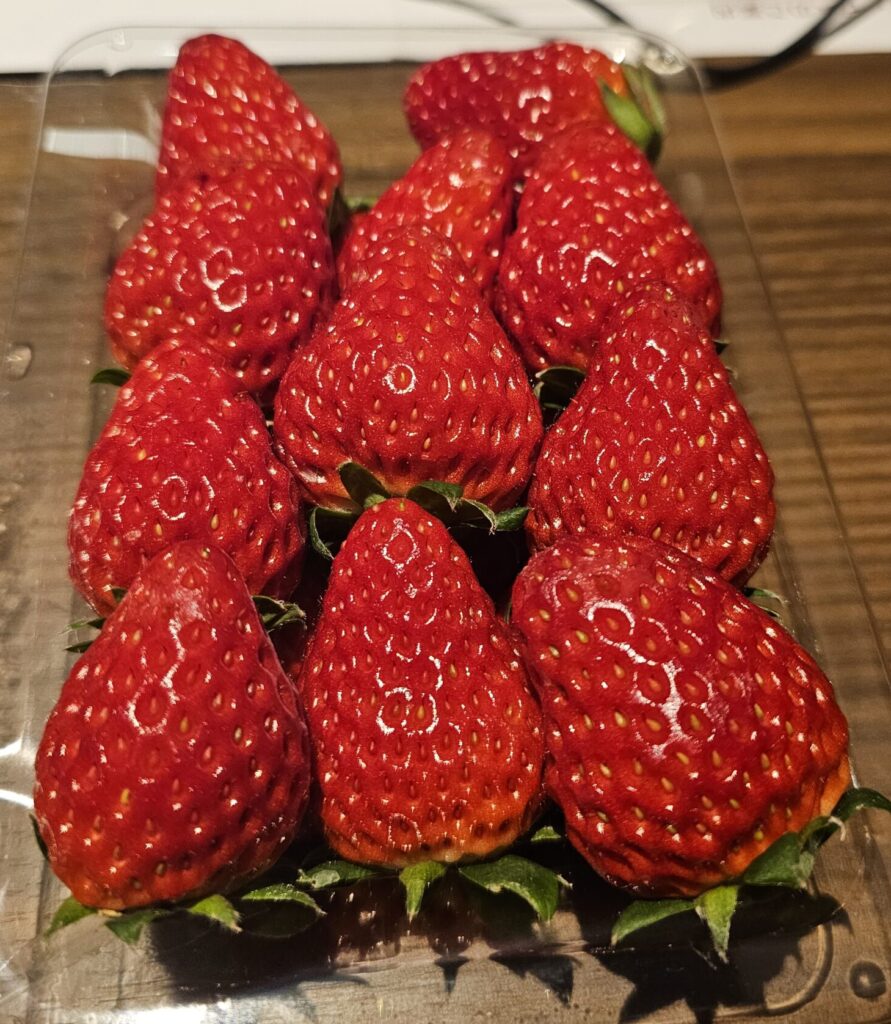
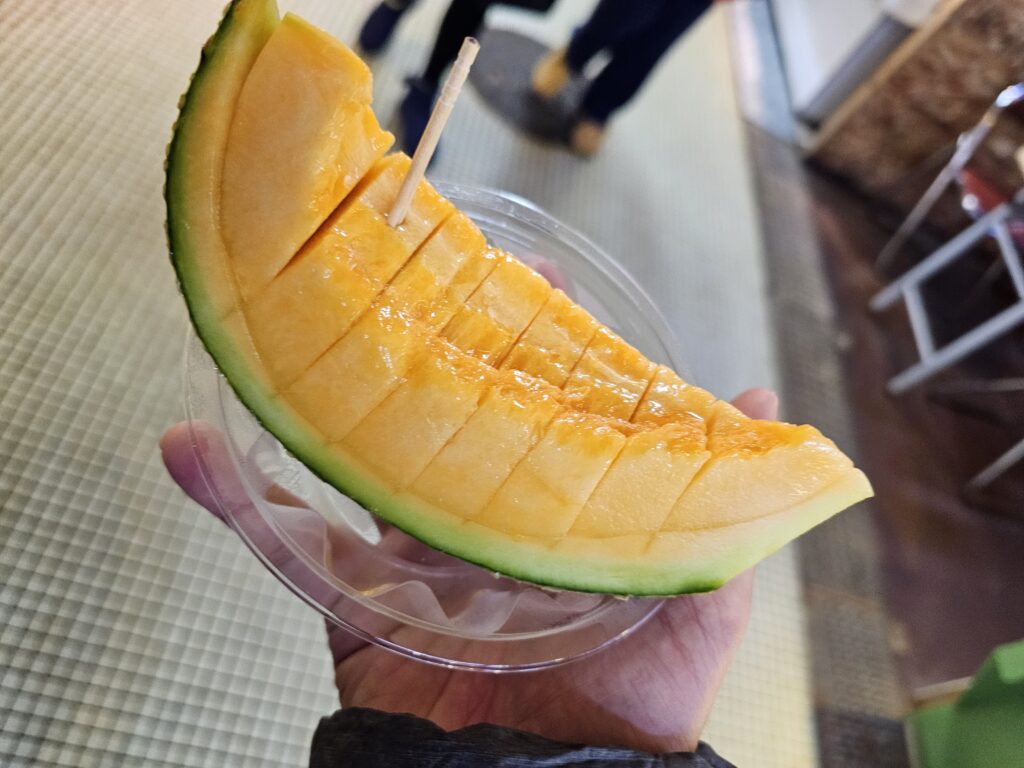
Japanese Curry
Japanese curry is a very popular food in the country and is considered a comfort food and is one of the 10 amazing foods in Japan. Japanese curry is its own unique curry and different from other types of curry found in the world. It’s a little bit thicker and is more sweet and savory. Commonly made with both a protein (beef, chicken, or with tonkatsu) and vegtables, it’s more in the vein of curry stew. Served with Japanese short grain rice which is stickier than basmati rice, the rice also really soaks up the curry.
Outside of rice curry, there’s other ways to enjoy Japanese curry as well. One of those “other” dishes is curry soup. A staple in Hokkaido, this is Japanese curry in soup form. While I’ve had curry rice many times, I’d never heard of curry soup before. If you’re a curry fan than this is a must try while traveling through Japan. I actually enjoyed it more than the curry rice. Very tasty with different vegetables and fall- off-the-bone chicken, this was one delicious dish!
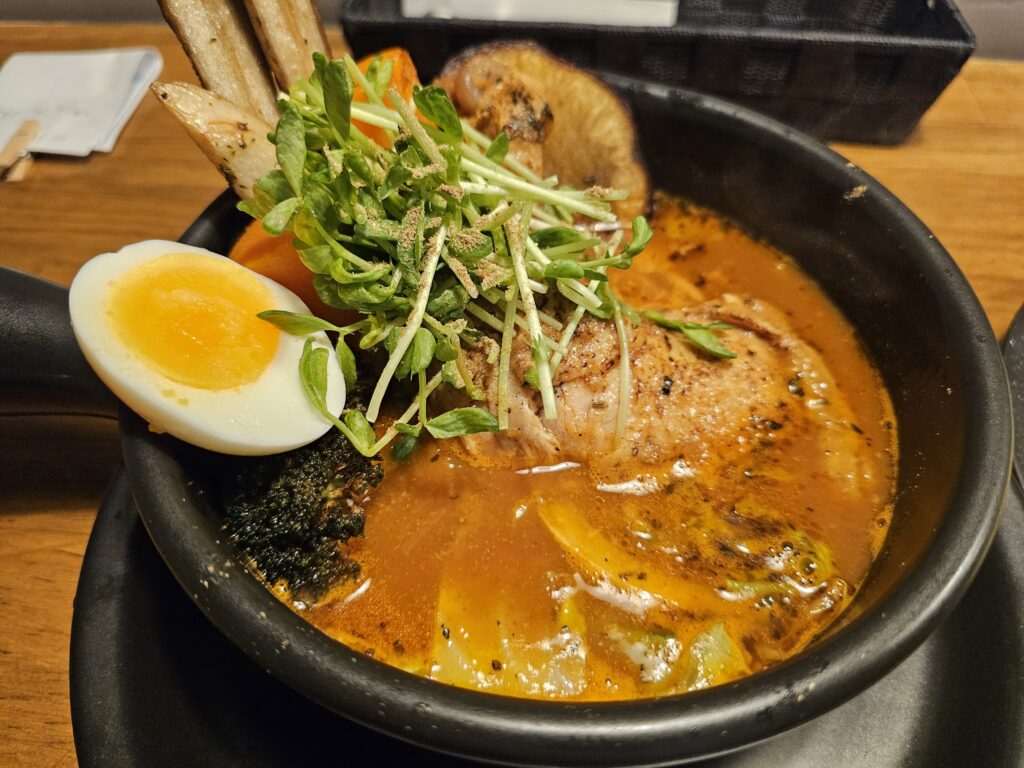
Kobe Beef / Wagyu
Kobe beef is a worldwide delicacy renowned for its flavor, tenderness, and fatty, well-marbled texture which easily places it amongst 10 amazing foods in Japan. As the name implies, Kobe beef is cultivated from Japanese Black cattle which is raised in the Hyogo Prefecture region of Japan, near Kobe. It’s considered the highest quality beef that Japanese cattle can produce and is a must try! There’s various cuts of this and obviously the higher the price the better the cut and quality. So the experience can certainly vary upon how much you’re willing to spend.
But it’s an experience that must be tried!
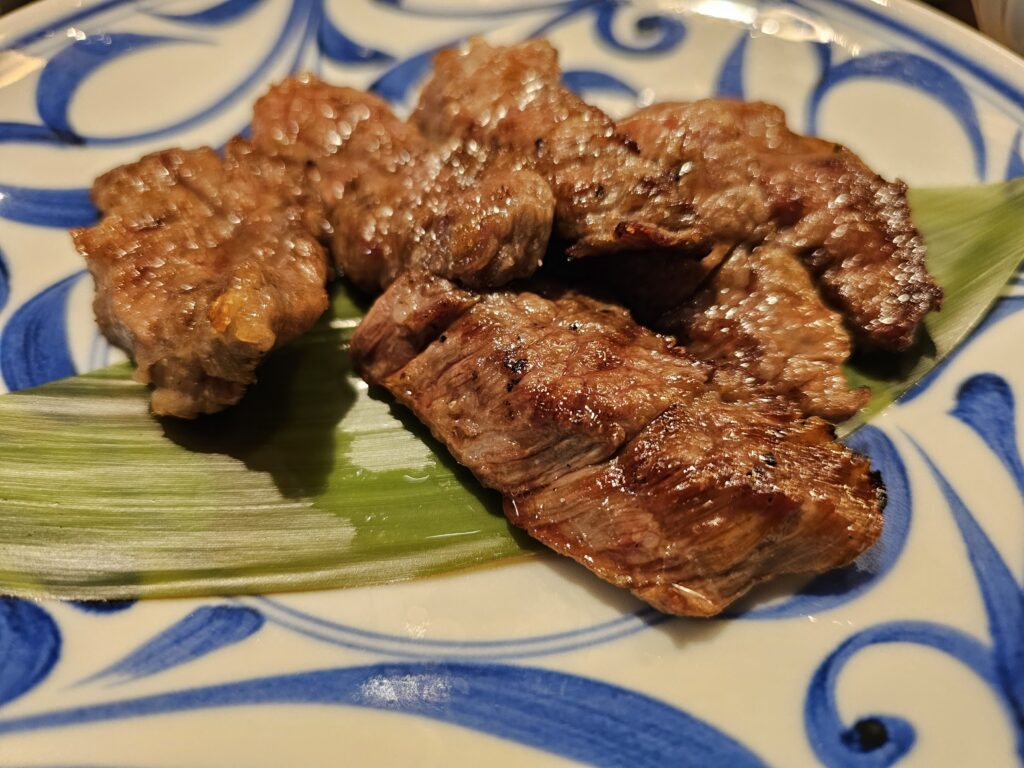
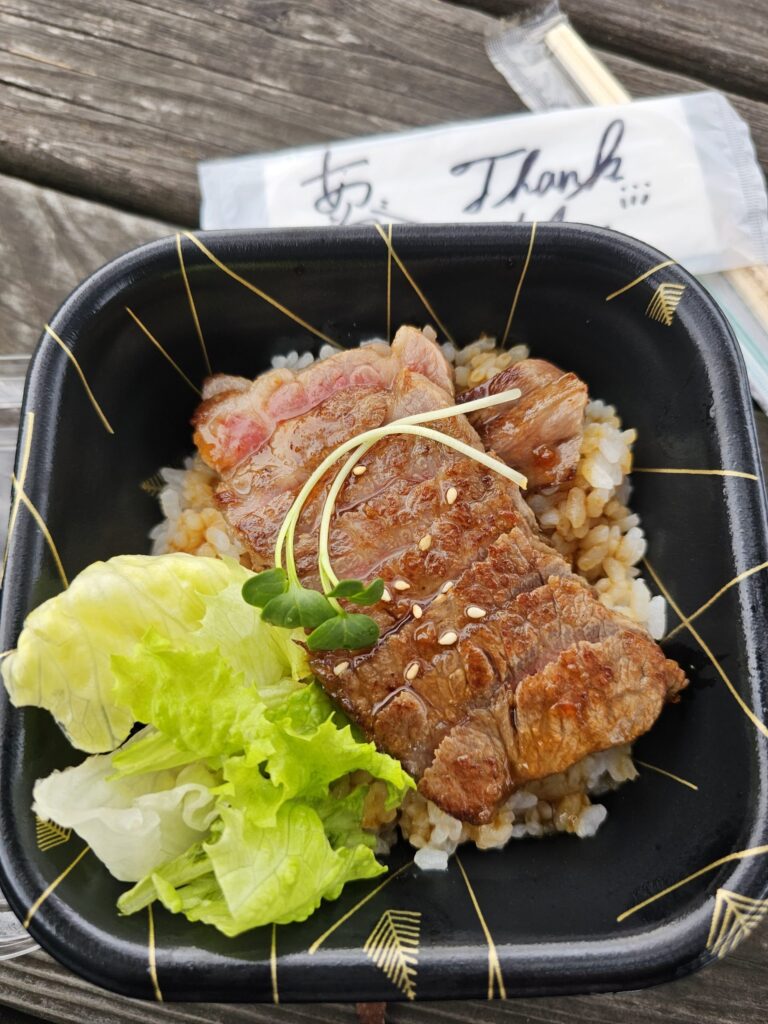
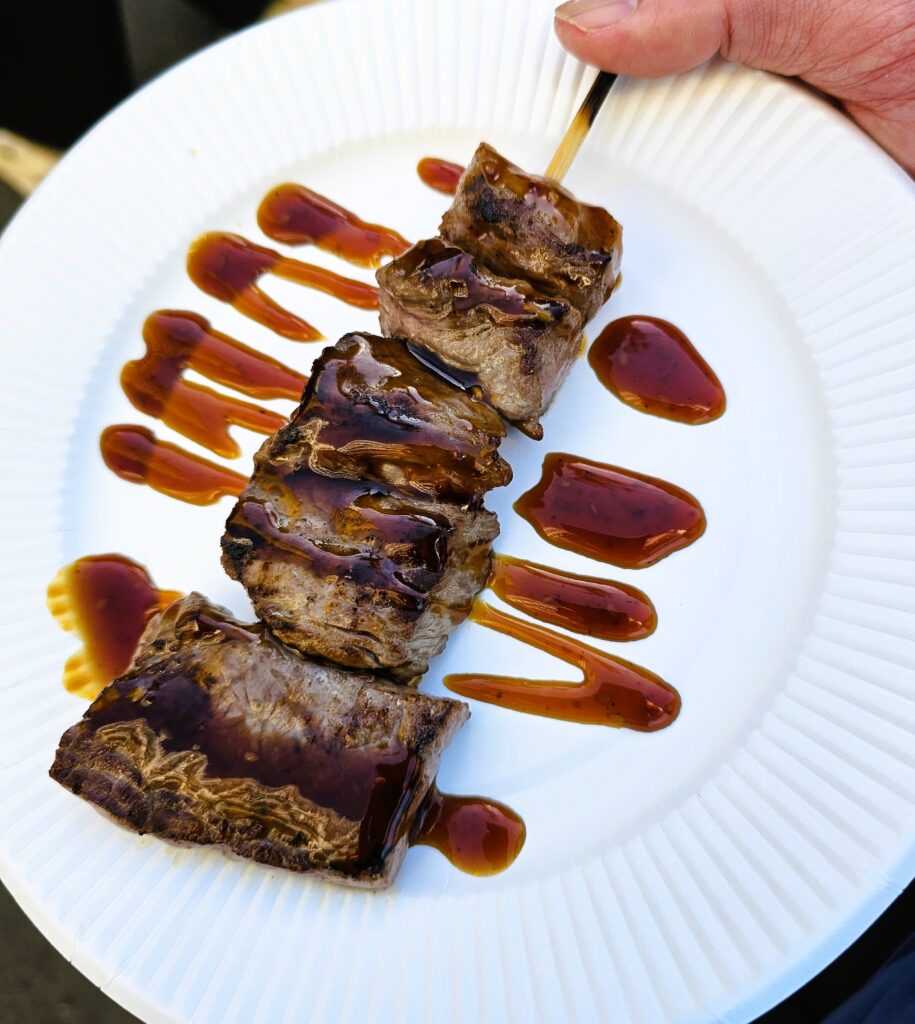
Omurice
Omurice includes ketchup fried rice, yes ketchup fried rice, wrapped in a very thin omlette with ketchup drizzled over the egg. The egg is very crepe like, it’s a very thin layer. The ketchup fried rice is generally mixed with chicken and vegetables. It’s an all-around unique looking and tasty dish that must be tried while in Japan! It’s a very common and popular breakfast item which is why I’m including it on the list of 10 amazing foods in Japan.


Tempura
Another food on the 10 amazing foods in Japan is tempura. Tempura is very famous in Japan and you’ll be able to find it thorughout the country. Tempura, for those who haven’t had it before, consists of seafood (shrimp is a staple) and vegetables coated in a thin batter and deep fried. The quality can differ, but the outer batter should be light and crispy and not saturated in oil. It definitely makes a big difference while enjoying this classic meal.
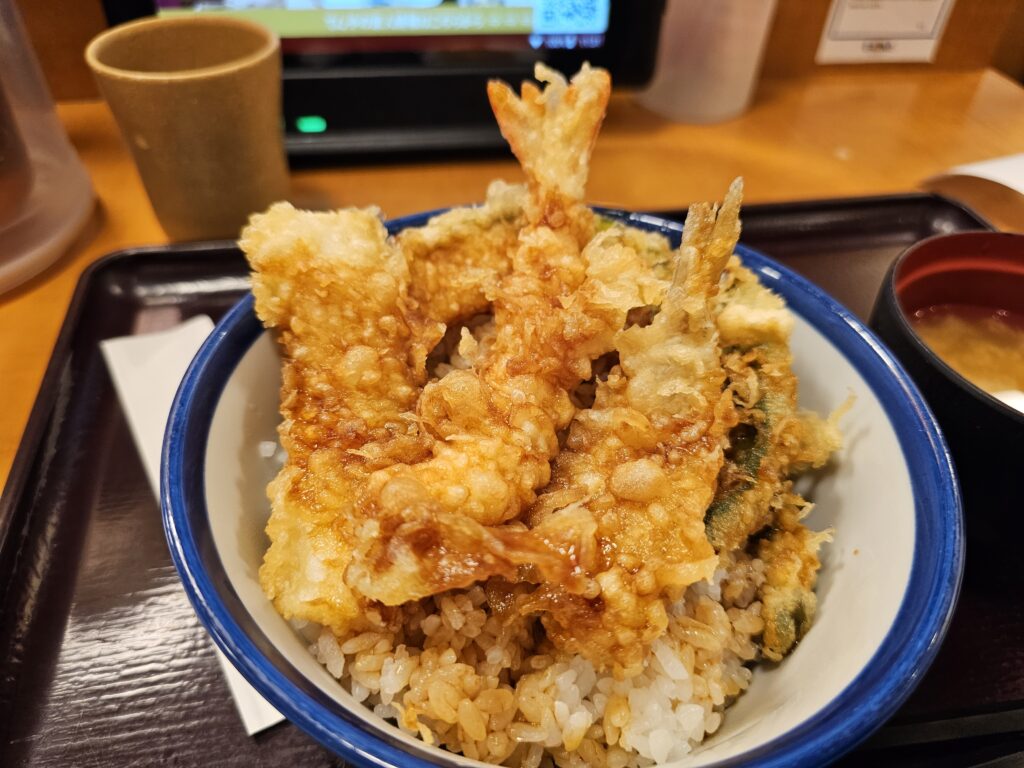
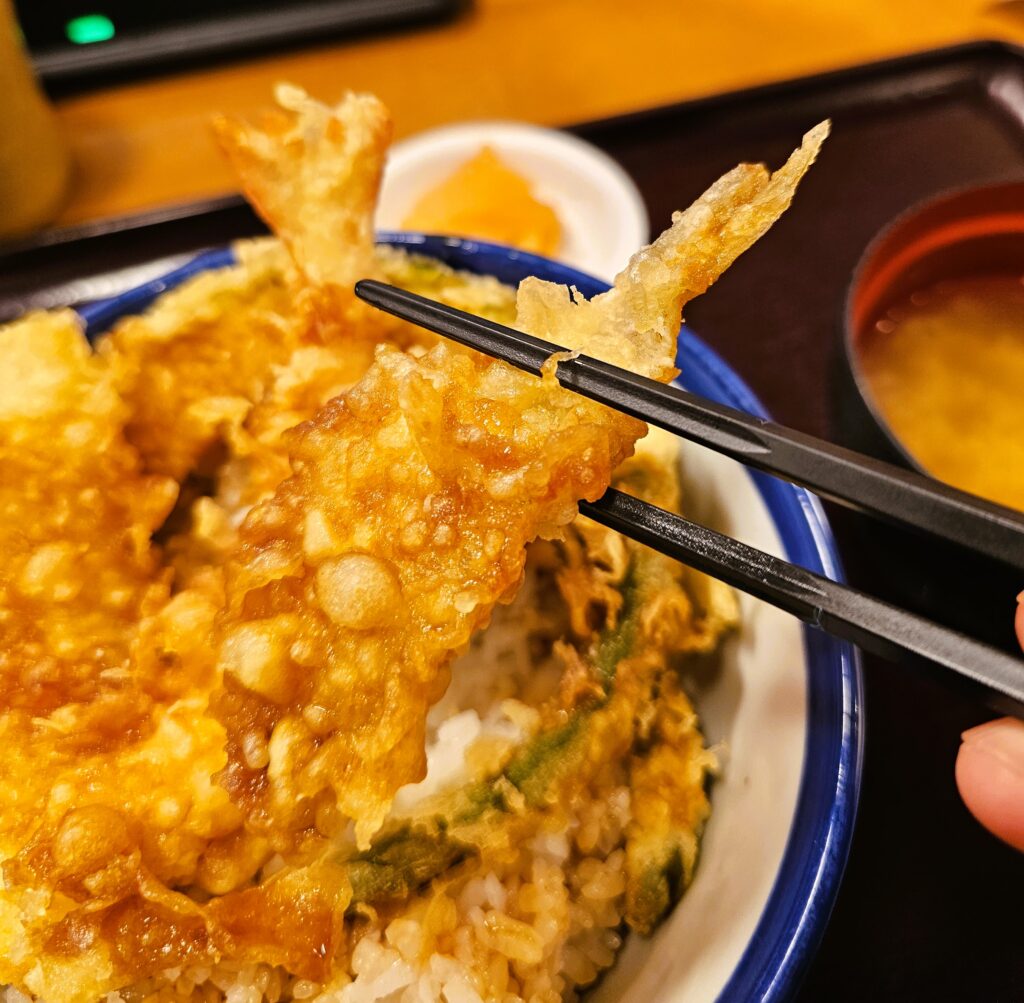
Tonkatsu
A classic food in Japan, tonkatsu, is certainly on the list for 10 amazing foods in Japan. Tonkatsu is a breaded pork cutlet that’s deep fried in oil. The breaded exterior is nice and crunchy, while the pork, which is generally a pork fillet or tenderloin, is juicy and tender. Served with a side of cabbage and a thick Worcestershire-style sauce, this is a must have while in Japan. Certainly do your research and find a quality spot to enjoy this Japanese comfort food.
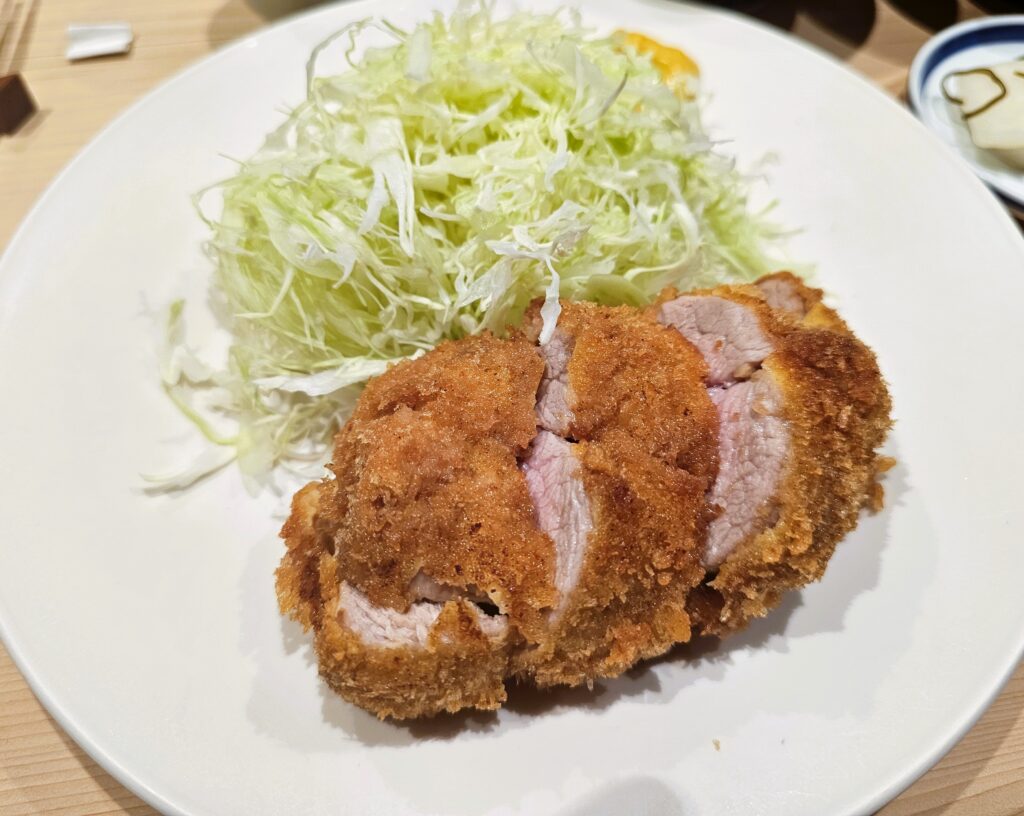
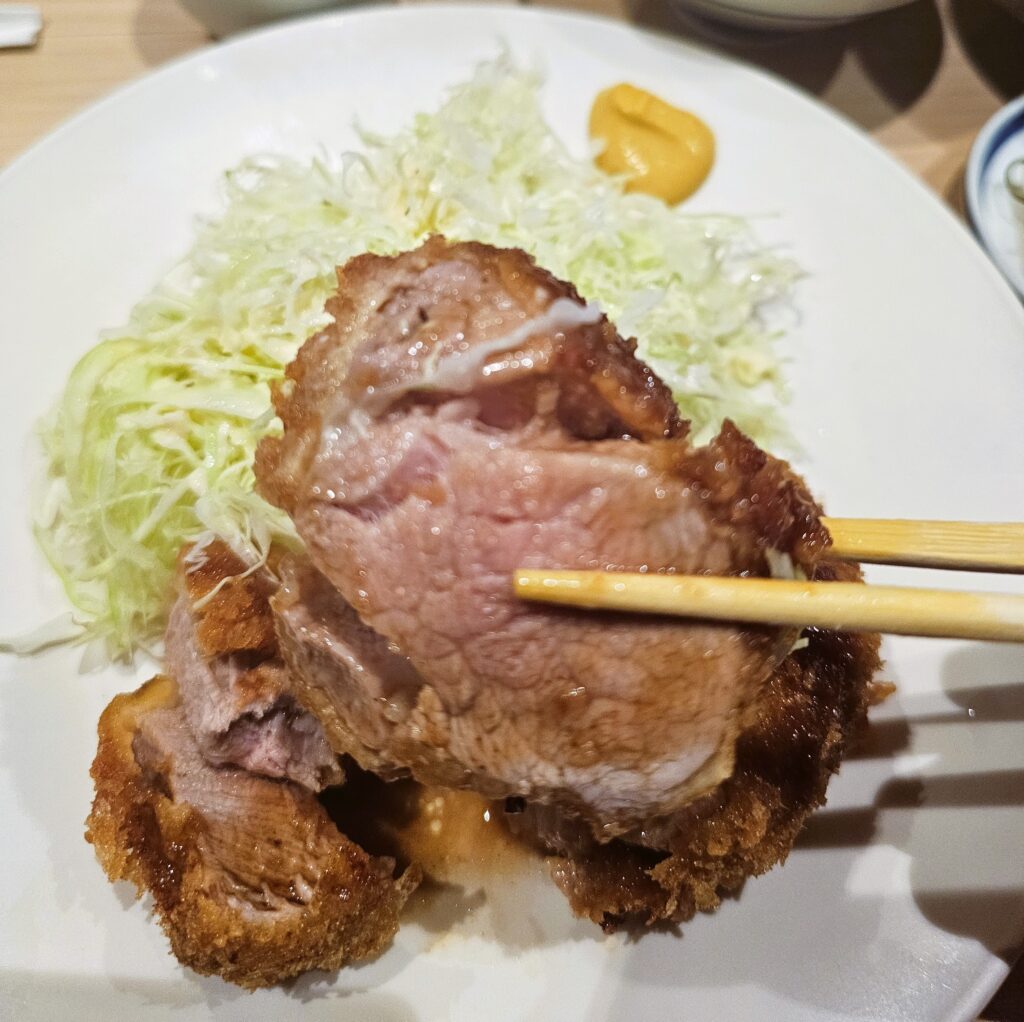
Okonomiyaki
Okonomiyaki is a popular, savory pancake dish that is found throughout Japan. Consisting of a flour batter and cooked on a teppan, common ingredients include cabbage, meat, and seafood, with toppings including a thicker worcestershire type sauce, dried seaweed flakes (aonori), bonito flakes, Japanese mayonnaise, and ginger. There’s two distinct types, one hailing from Osaka and one from Hiroshima. The Hiroshima version is layered instead of mixed and uses 3-4x more cabbage.
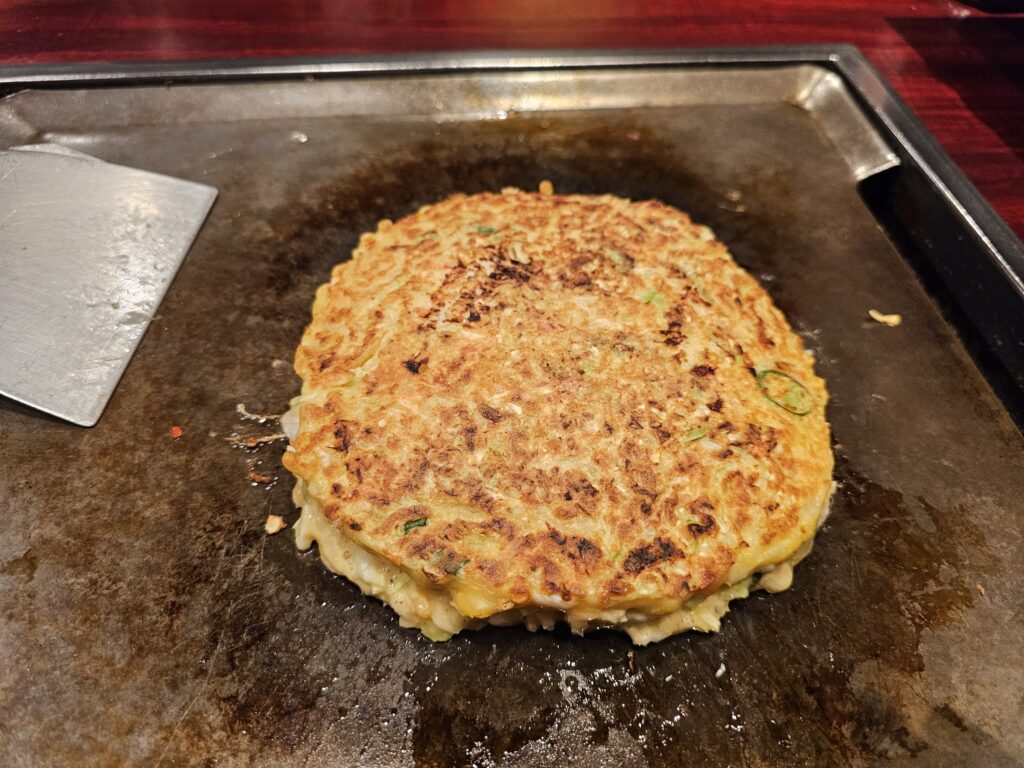


-
Discover Tokyo Disneyland: Overview Of The Unique Rides
Tokyo Disneyland is a major attraction in Tokyo. Immensley popular, it offers awe-inspiring sights and sounds that are both familiar and new to Disney fans alike. If you’re a Disney fan, there’s no doubt that you have a trip planned to visit Tokyo Disneyland and most likely Tokyo DisneySea as well.
Table of Contents
Tokyo Disneyland’s History
Tokyo Disneyland opened it’s gates in April 1983 becoming the first Disney park to be built outside the United States. It, along with its companion park, Tokyo DisneySea are the only Disney parks in the world that are not owned or operated by The Walt Disney Company. They are both owned by the Oriental Land Company which licenses the intellectual property from the Walt Disney Company.
The park mainly mirrors the original Disneyland with both the same themed lands and many of the same rides and iconic structures. There are differences though. Tokyo Disneyland includes themed rides including Beauty & The Beast, Monsters Inc., and Baymax which are not in its American counterpart.
Here are the unique rides that can be found at Tokyo Disneyland:
Enchanted Tale of Beauty and the Beast
As I mentioned above, Tokyo Disneyland has a few rides that are unique to the park and not found in any other Disney parks. The biggest of them all is the Enchanted Tale of Beauty and the Beast. Opened in 2020, the attraction includes a 108 foot castle which you can admire as you wait in the always lengthy line.
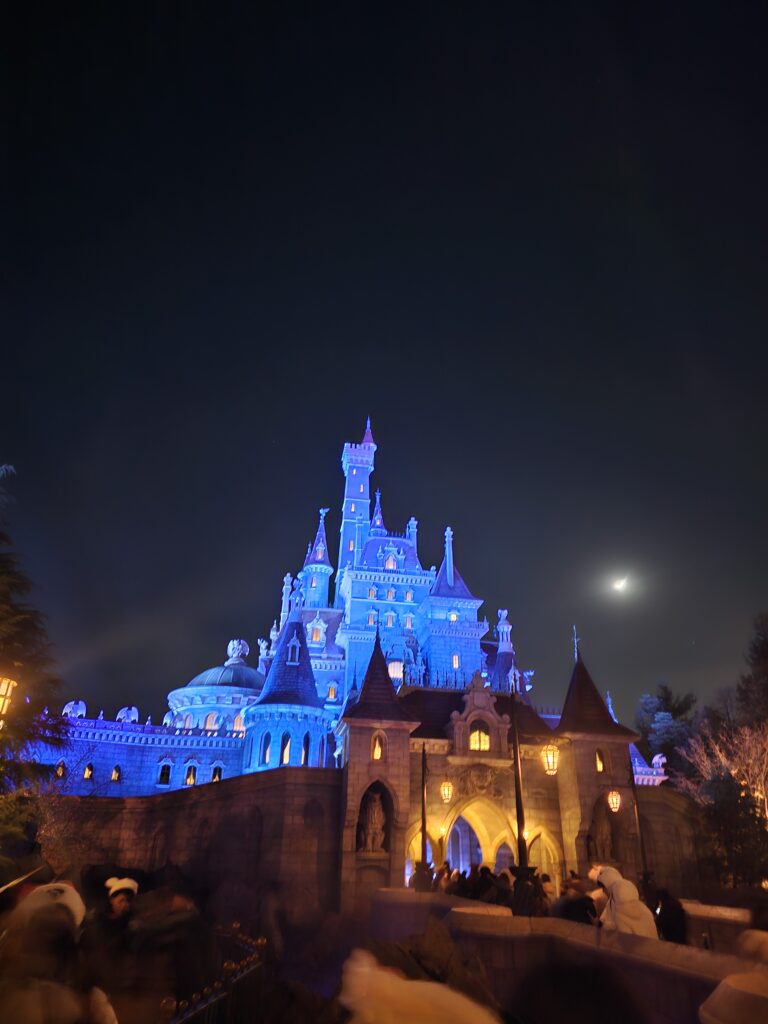
Once inside the castle, you’re provided with pre-show that includes the backstory of how the Prince became the Beast and then Belle and Beast both make an appearance. This pre-show is fantastic and the animatronic Beast and Belle are really, really cool. The ride itself is amazing.
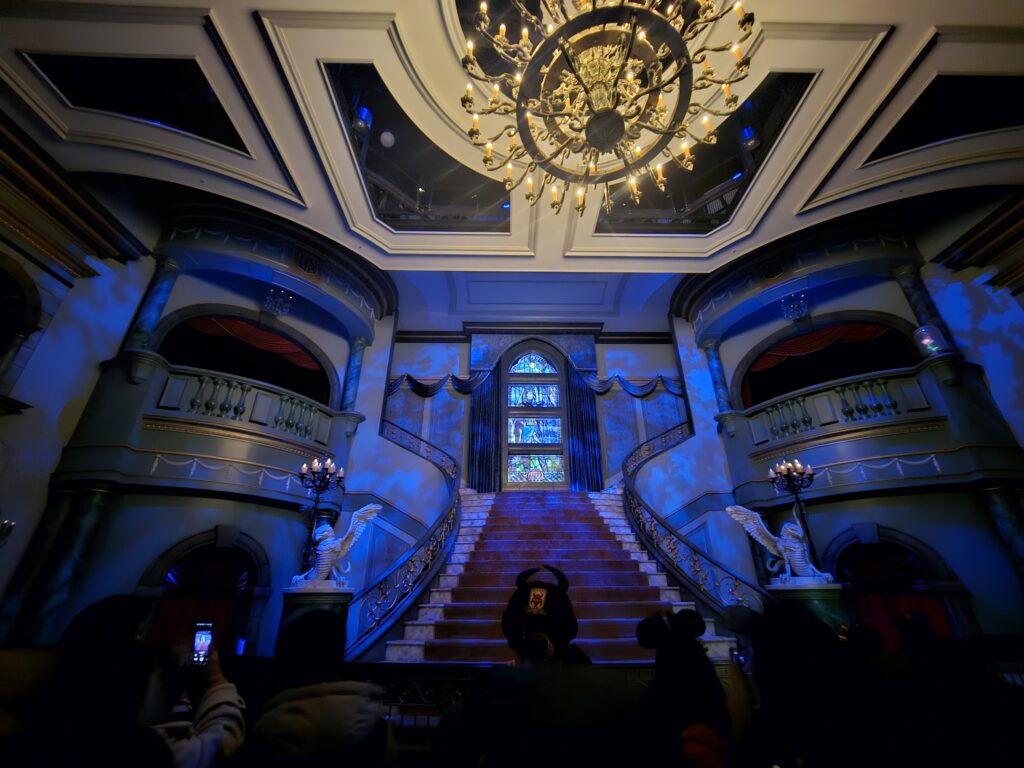
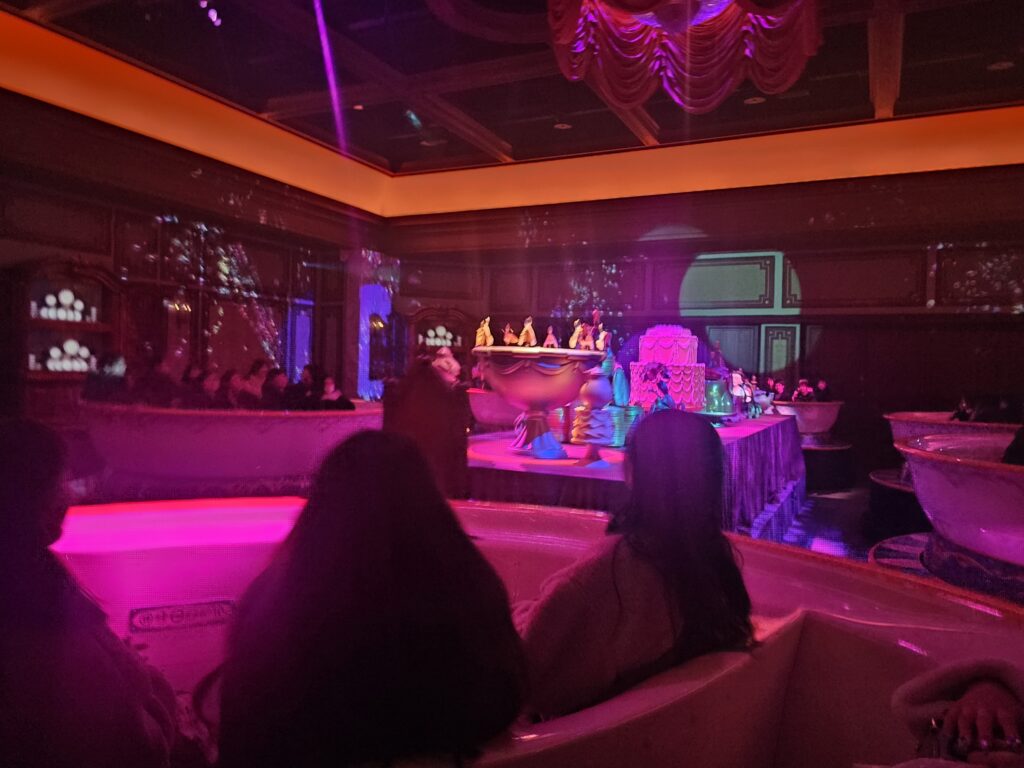
Seated in tea cups that are trackless, guests are whisked through various scenes and all the popular songs from the movie are played, including “Be Our Guest”, “Something There”, and “Beauty and the Beast”. What makes this so unique is how the tea cups dip and dive and spin in concert with the music. The way they move it makes you feel as if you’re dancing to the music. The all-around environment and presentation of the ride along with top notch animatronics, make the ride, well, magical to say the least. I’m not even a Beauty and the Beast fan but was really awed by the experience.
Pooh’s Hunny Hunt
I’m not entirely sure if the actual story and different scenes of Pooh’s story within the ride is different than other Pooh rides, but the presentation is certainly different and unique. Pooh’s Hunny Hunt is entirely trackless. This trackless technology allows for a new ride experience each and every time you go on the ride since the way your honey pot vehicles moves is different each time.
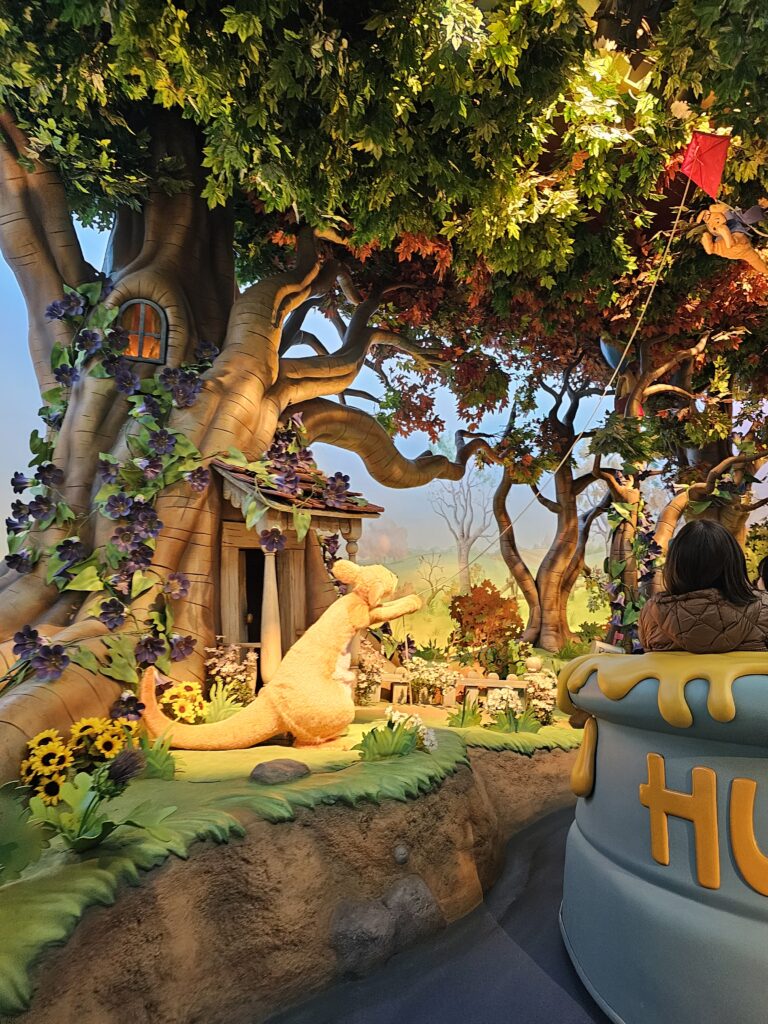
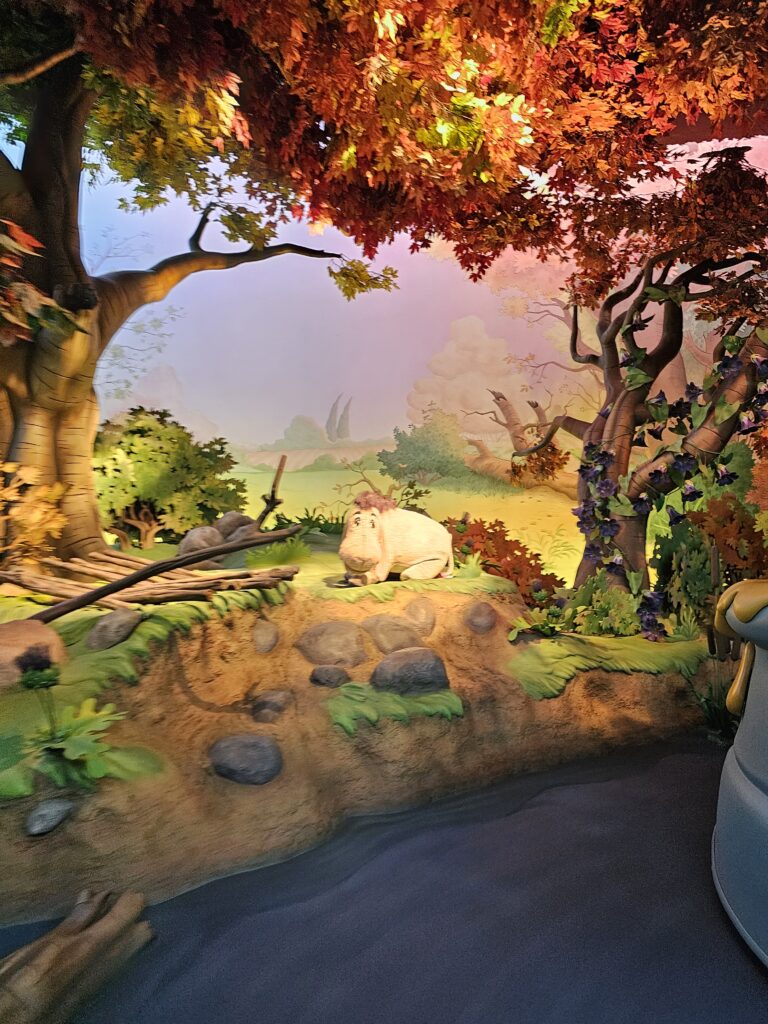
The ride itself and the story it tells may feel familiar (again, not sure if the other Pooh rides are exactly the same) with the ride taking you through the Hundred Acre Woods where all of Pooh’s famous pals reside. You’ll see plenty of Kanga, Roo, Eeyore, Owl, Rabbit, Piglet, as well as Tigger, who provides a fun “bouncing” experience.
In Tigger’s portion of the ride, as he comes bouncing into the scene, the entire room bounces, including the honey pots. It’s a really, really fun portion of the ride.
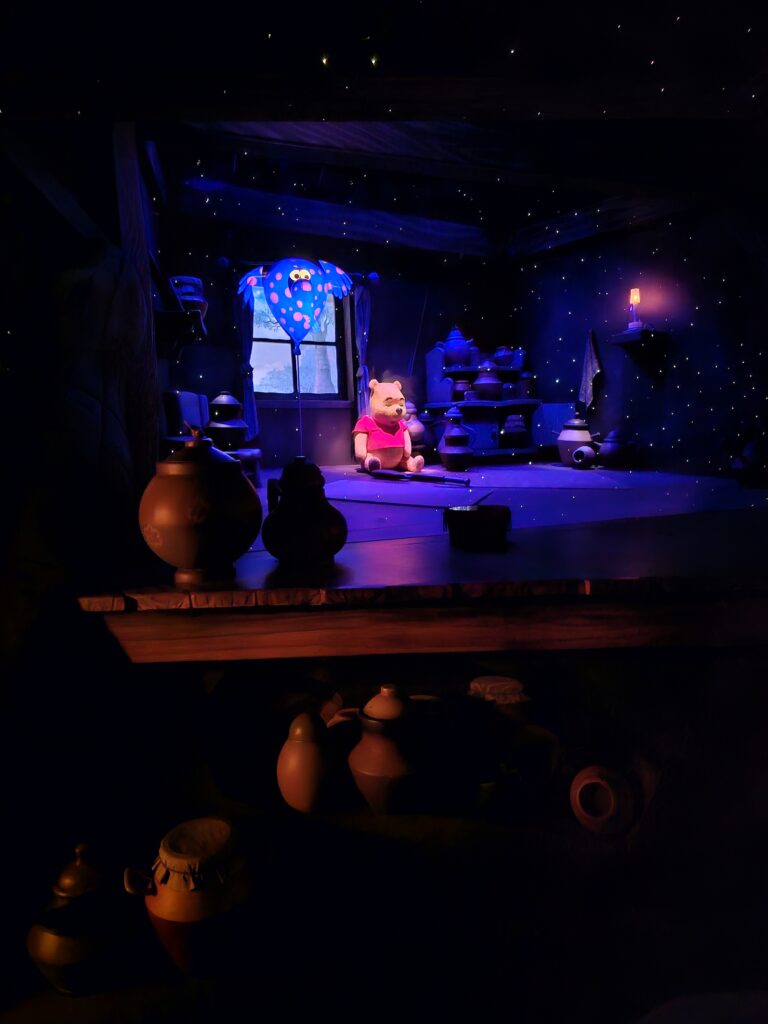
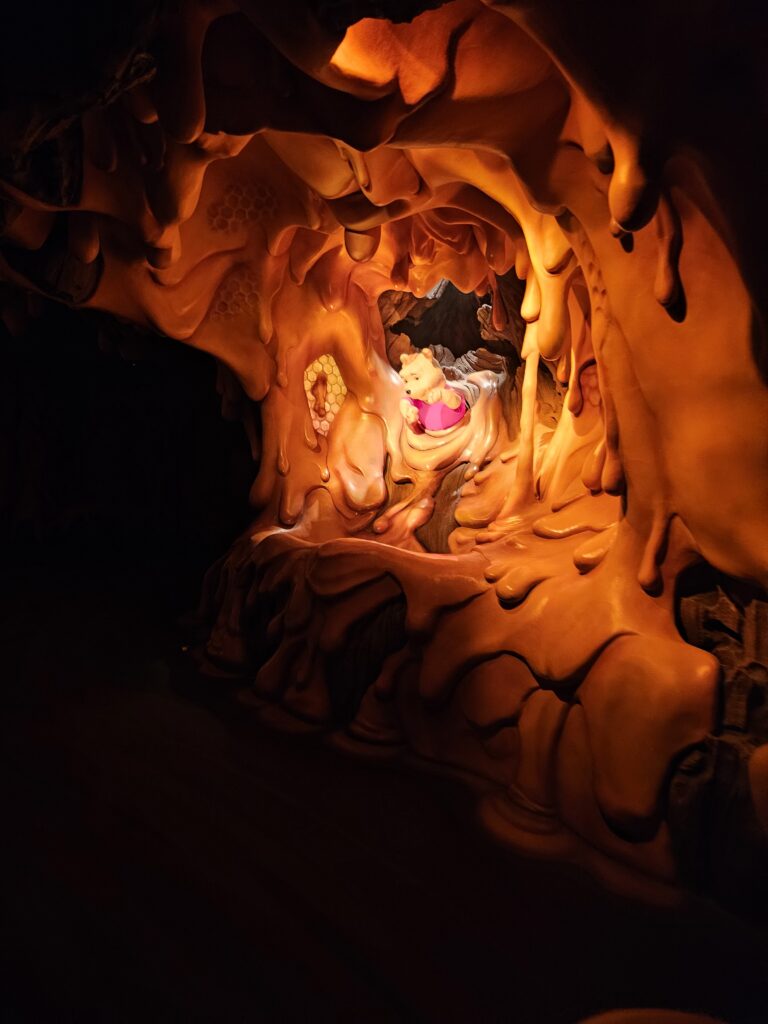
Pooh’s Hunny Hunt is colorful and vibrant and the attention to detail is outstanding. It’s a really fun ride with the trackless technology and is certainly a must ride while at Tokyo Disneyland.
The Happy Ride with BaymaxThe only Big Hero 6 themed ride in the world, The Happy Ride with Baymax is a “whip ride” that has guests seated in a vehicle that is hitched to a “personal healthcare companion” vehicle which Baymax is seated in. The ride whips around in unpredictable routes in an arena that’s similar to a roller rink. The entire time one of six original songs, made specifically for the ride, is blaring.
The basis for the ride is that in order to take better care of people and keep them healthy, the first step is making them happy. What better way to do that than through upbeat music and lights?
I didn’t have time to jump aboard this one but guests were definitely jamming out to the music here and it seemed like a good time. Time permitting I would have gone on it, but I didn’t have it circled as a “must”. Hopefully next time!
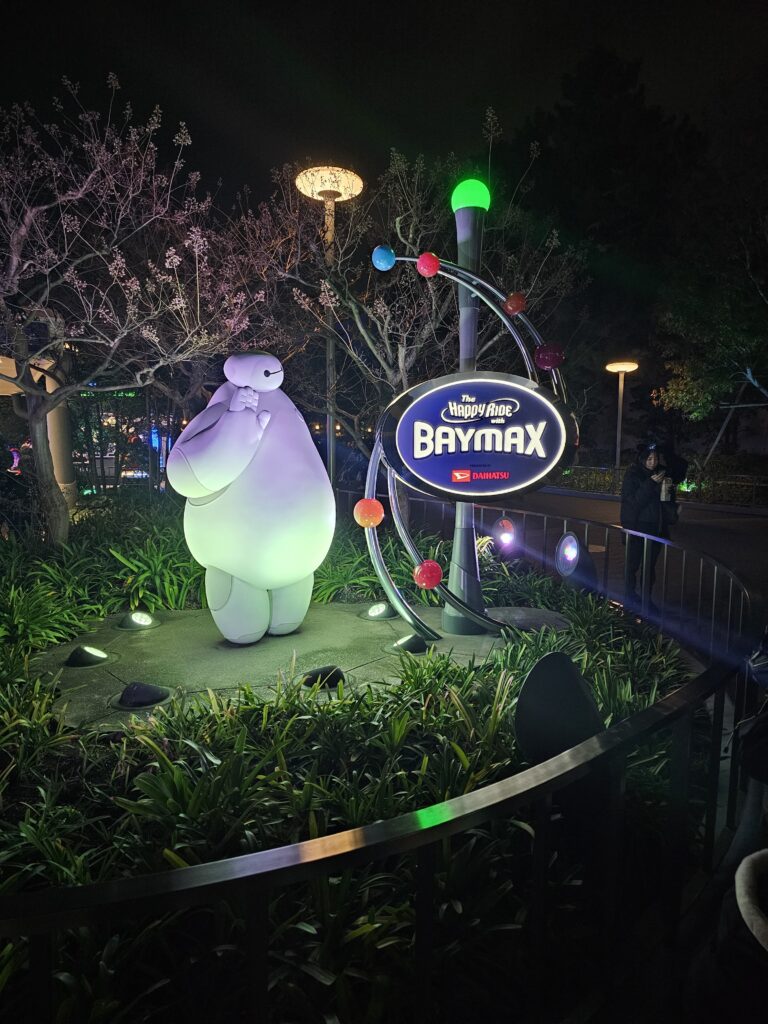
Monsters, Inc. Ride & Go Seek
Another Tokyo Disneyland exclusive, Monsters, Inc. Ride & Go Seek, is based after the events of Monsters, Inc. The premise of the ride is that an exciting new event called Flashlight Tag is being held at the Monsters, Inc. factory where humans are invited back to the scare / laugh floor of the factory to play a game of hide and go seek but the ride takes you to various places outside the factory within Monstropolis as well.
The two person “security vehicles” are equipped with flashlights. Shining your flashlight at Monster Inc. helmets placed throughout the attraction causes items and monsters to react in fun ways. They might light up, pop up, or do some other form of movement. It’s a lot of fun as there’s a lot of these Monster, Inc. helmets throughout the ride. Some blend in well with the background and are harder to locate than others that are right in the line of sight.
This is a fun, interactive ride, where you can see all of your favorite characters from the Monsters, Inc. universe. Like all the rides, the attention to detail and the animatronics are top notch!
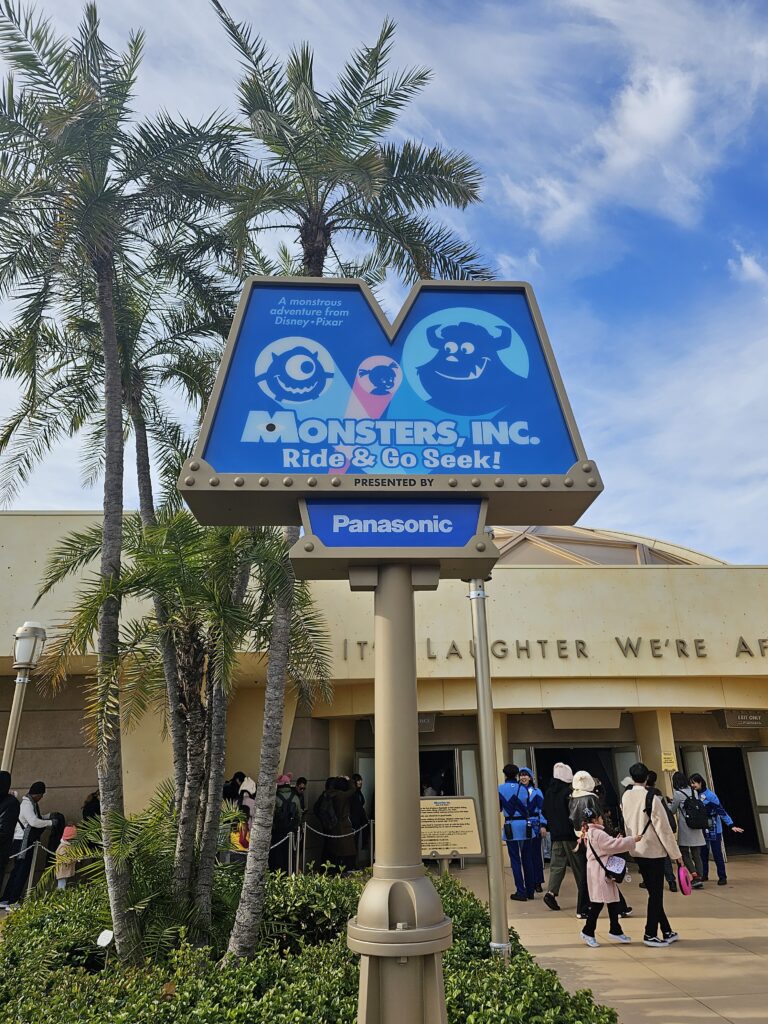
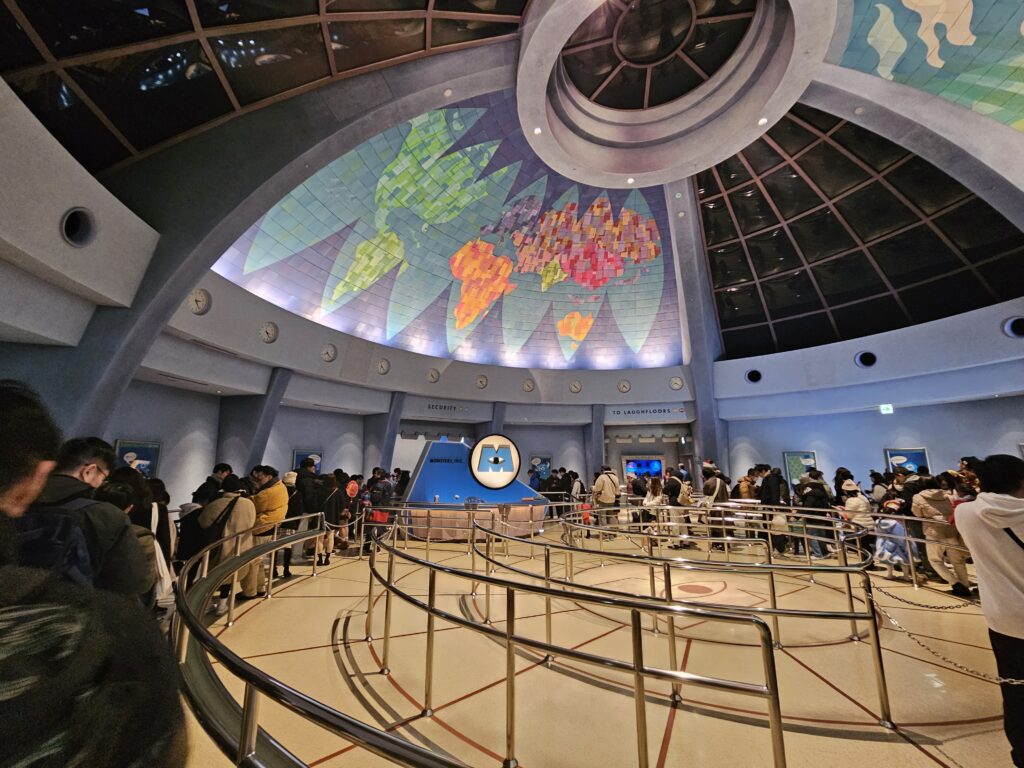
-
7 Popular Things To Do In Kobe, Japan
Kobe, located in the Kansai region, is Japan’s 7th largest city with a population around 1.5 million. It’s about a 20-30 minute train ride from Osaka and makes for a perfect day trip if you’re using Osaka as a hub for the surrounding area. There’s plenty to see and do in this lovely port city!
Table of Contents
7 Popular Things To Do In Kobe, Japan:
Eat Kobe Beef
As the saying goes “When In Rome..” or perhaps the more suitable, “When in Kobe..” in this instance. Kobe beef is a worldwide delicacy renowned for its flavor, tenderness, and fatty, well-marbled texture. As the name implies, Kobe beef is cultivated from Japanese Black cattle which is raised in the Hyogo Prefecture region of Japan, near Kobe. It’s considered the highest quality beef that Japanese cattle can produce and is must try! There’s various cuts of this and obviously the higher the price the better the cut and quality. So the experience can certainly vary upon how much you’re willing to spend.
I went the “cheap” route at a Kobe beef restaurant ($36.14 USD) for six pieces of Kobe beef and the meat was just alright. Some pieces melted in my mouth, while others were pretty chewy. You get what you pay for. On the other hand, I got a Kobe beef bowl in Himeji and the Kobe beef was AMAZING.
Regardless, Kobe beef is an EXPERIENCE. It’s one of the most popular things to do in Kobe and is something you’ll definitely want to try (just do some better research than myself to find a proper Kobe beef restaurant!).


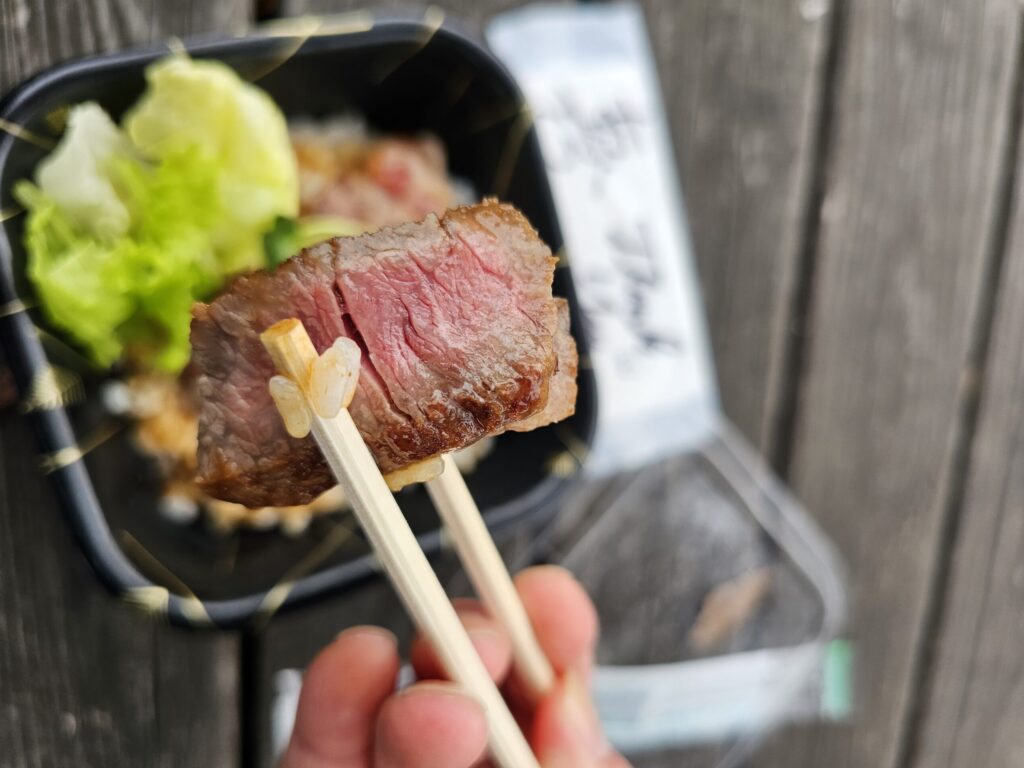
Visit Kobe’s Chinatown
One of the most popular things to do in Kobe is taking a visit to its Chinatown. This is one of the largest Chinatown’s in all of Japan. This is a small area – 270 meters east to west and 110 meters north to south – but is jam packed with over 100 shops, food stalls, and restaurants.
A lot of the food stalls, as you’ll notice, sell a lot of the same types of food items. There are some unique food items though. Some restaurants are quite popular with massive lines.
Needless to say, you don’t need to walk to far to find some tasty, cheap food or drinks. Be sure to come with a big appetite, you’ll certainly need it here!
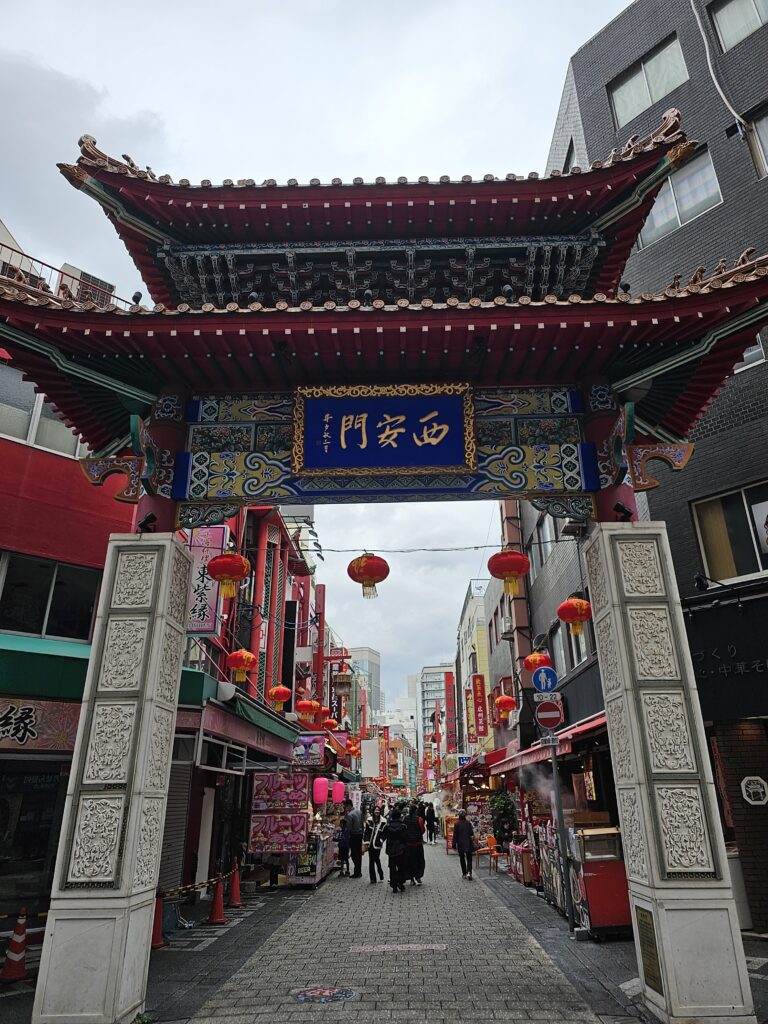
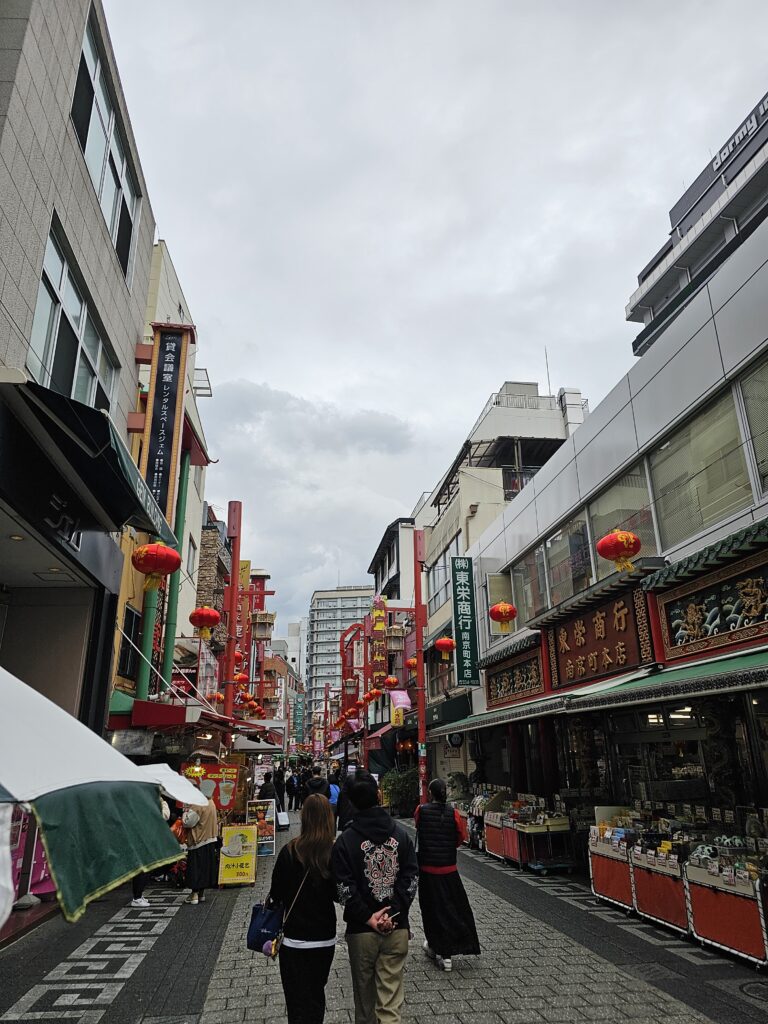
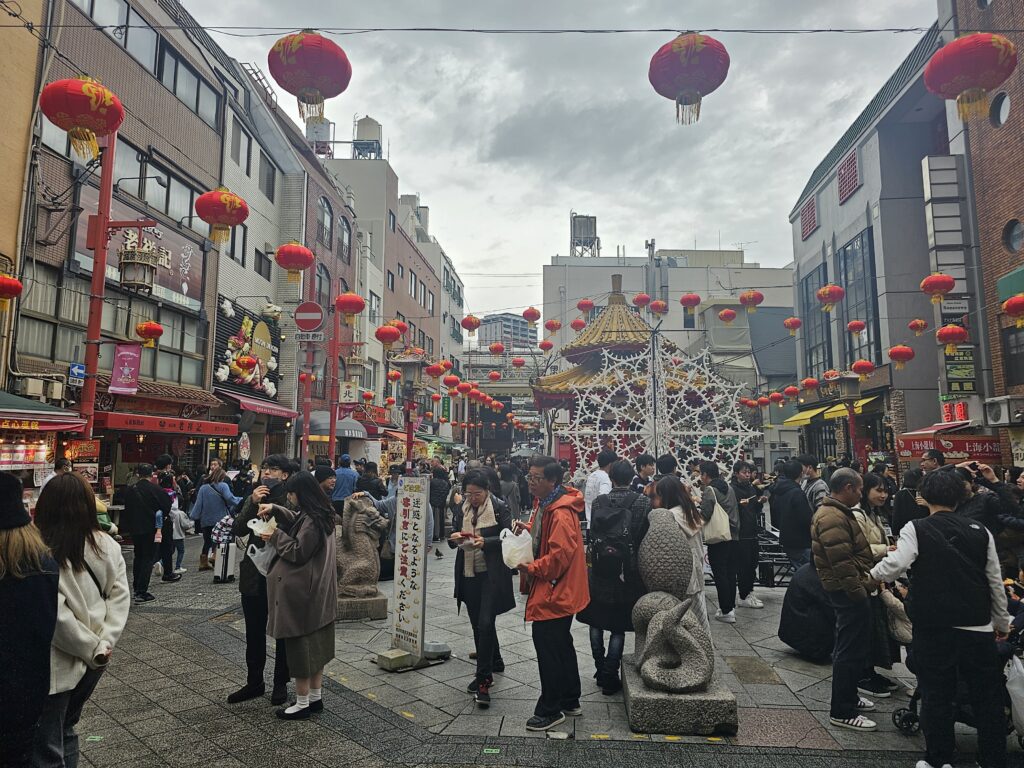
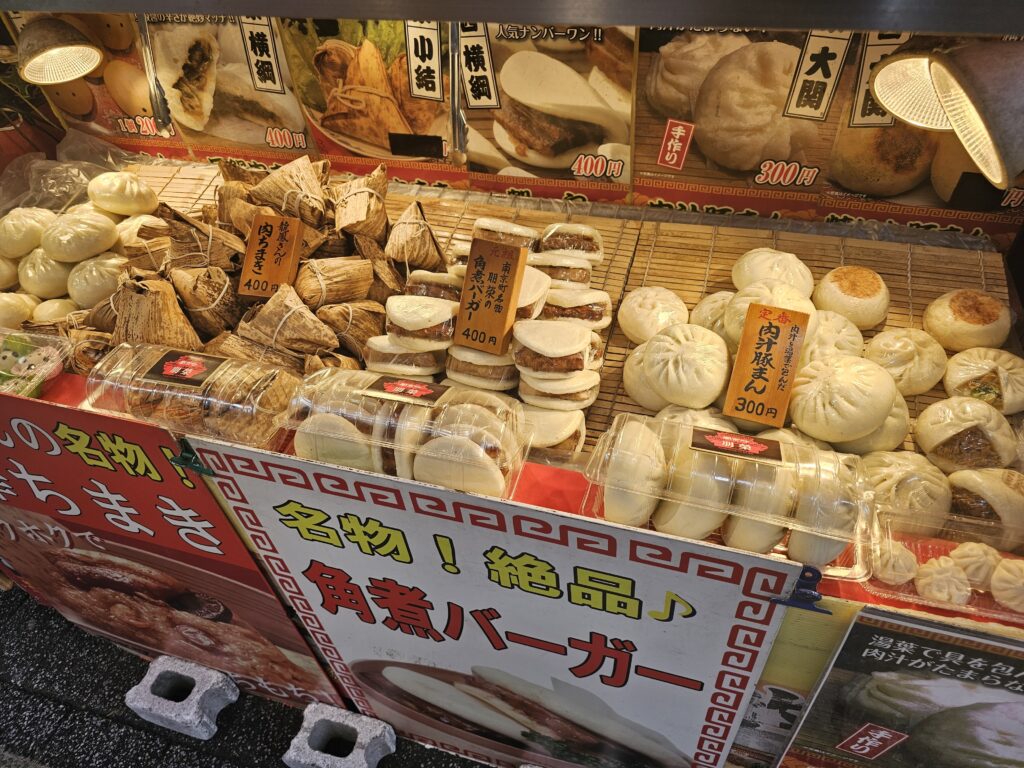
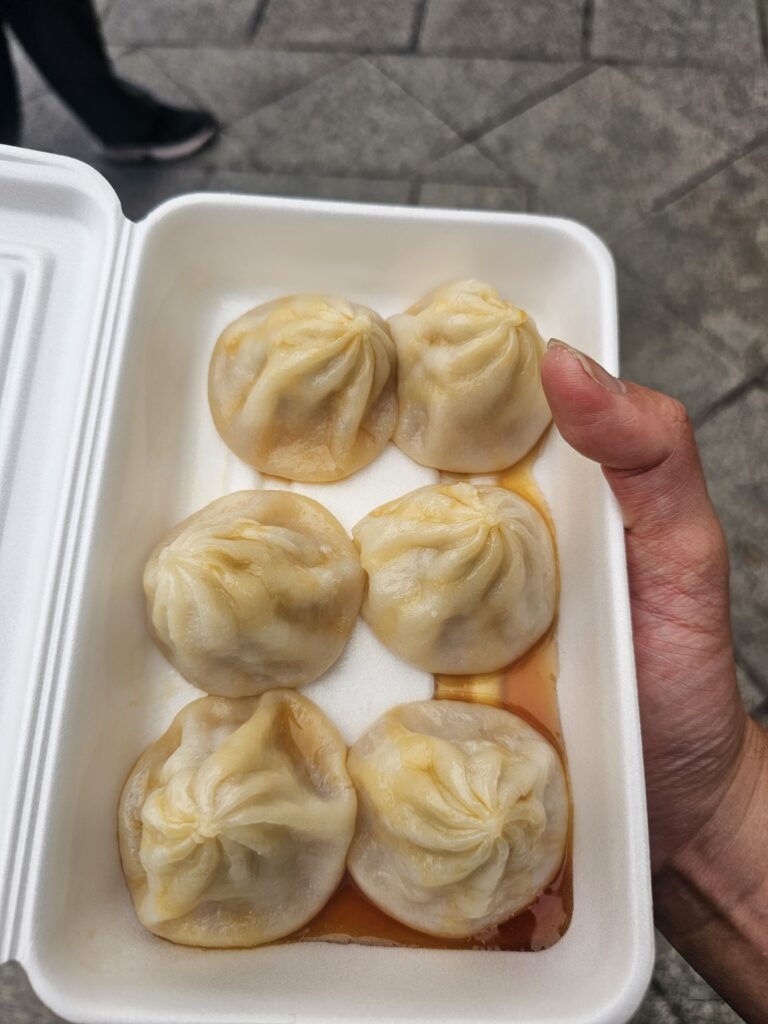
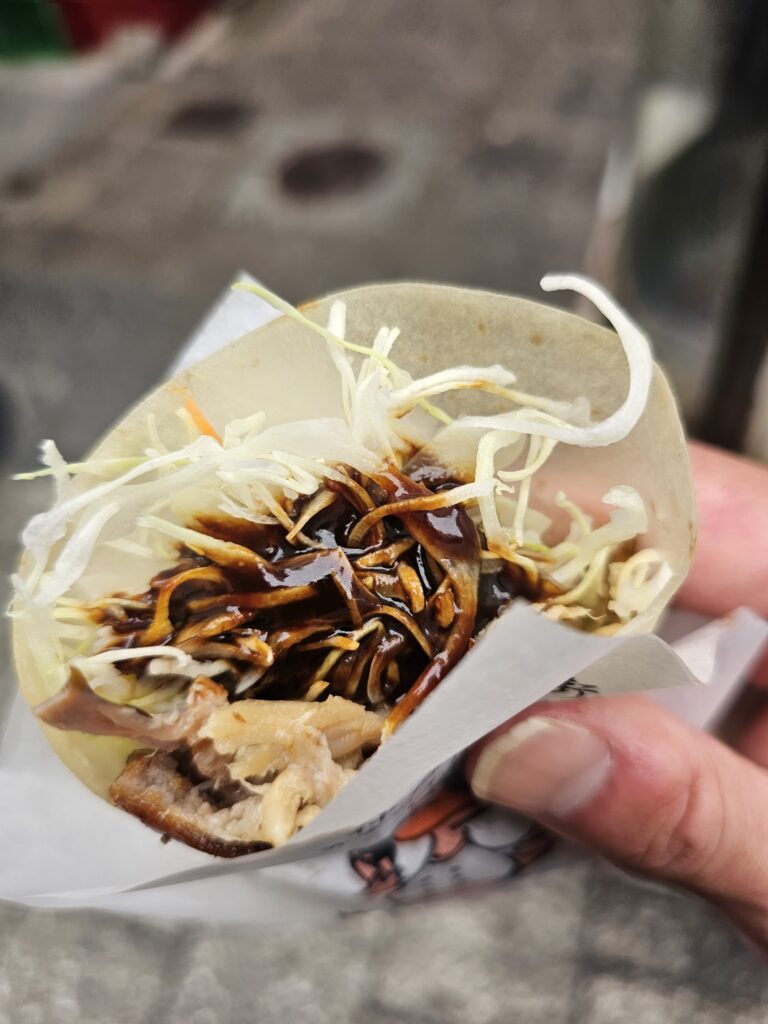
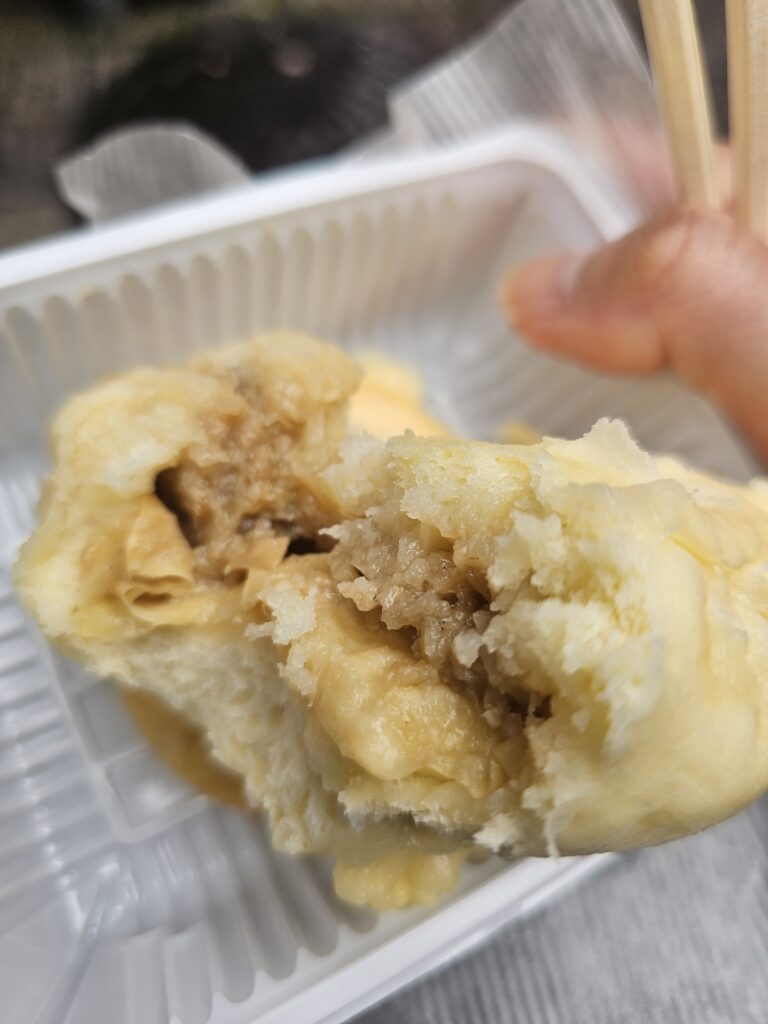
Explore The Kobe Nunobiki Herb Gardens
One of the biggest attractions and things to do in Kobe is taking a visit to the Kobe Nunobiki Herb Gardens. Located on Mt. Rokko above Kobe, the best way to access Kobe Nunobiki Herb Gardens is via the Kobe Nunobiki Ropeway. The ropeway ride takes about 10 minutes and provide a great view of Kobe on the way up.
A round trip on the ropeway which also provides access to the garden, will set you back 2000 yen ($12.43 USD), a one-way ticket is 1400 yen, ($8.70 USD).
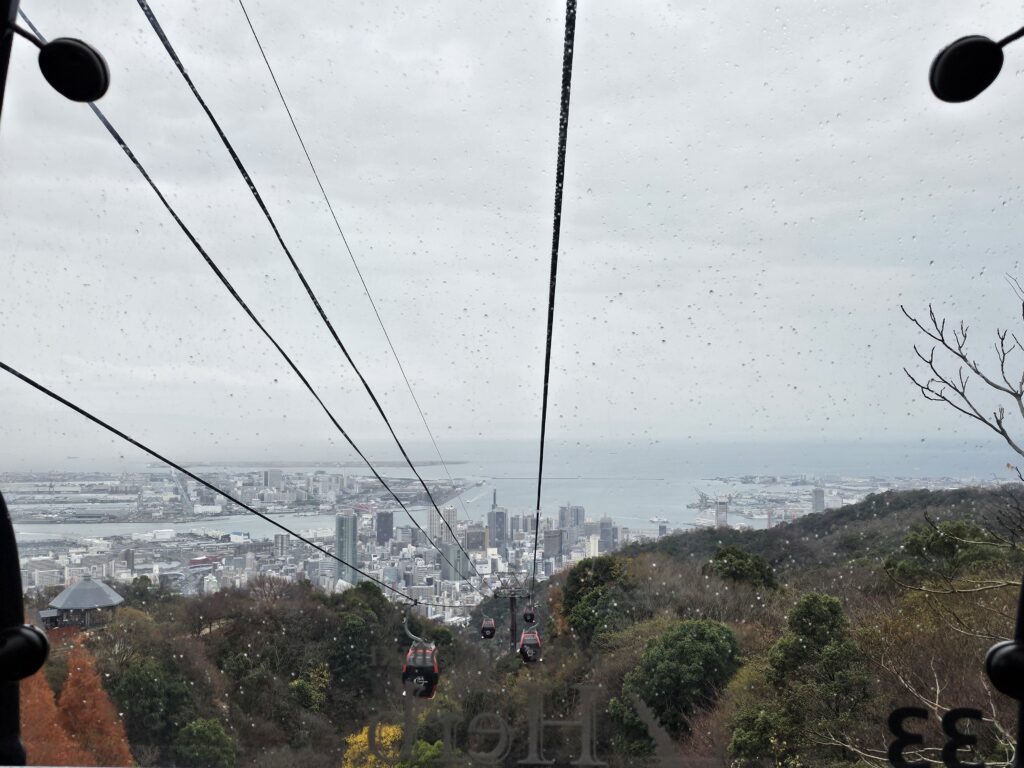
Once you get to the actual garden area, it opens up with a large, open view plaza that includes the German castle themed rest house. This building has some souvenir shops and a shop selling food and drinks. The open concourse area can house vendor tents selling seasonal boutique items while provide an abundance of bench seating.
There’s also a frangrance museum next to the rest house. This museum has a huge array of unique, natural smelling perfumes and oils that can be purchased and is well worth a walk through.
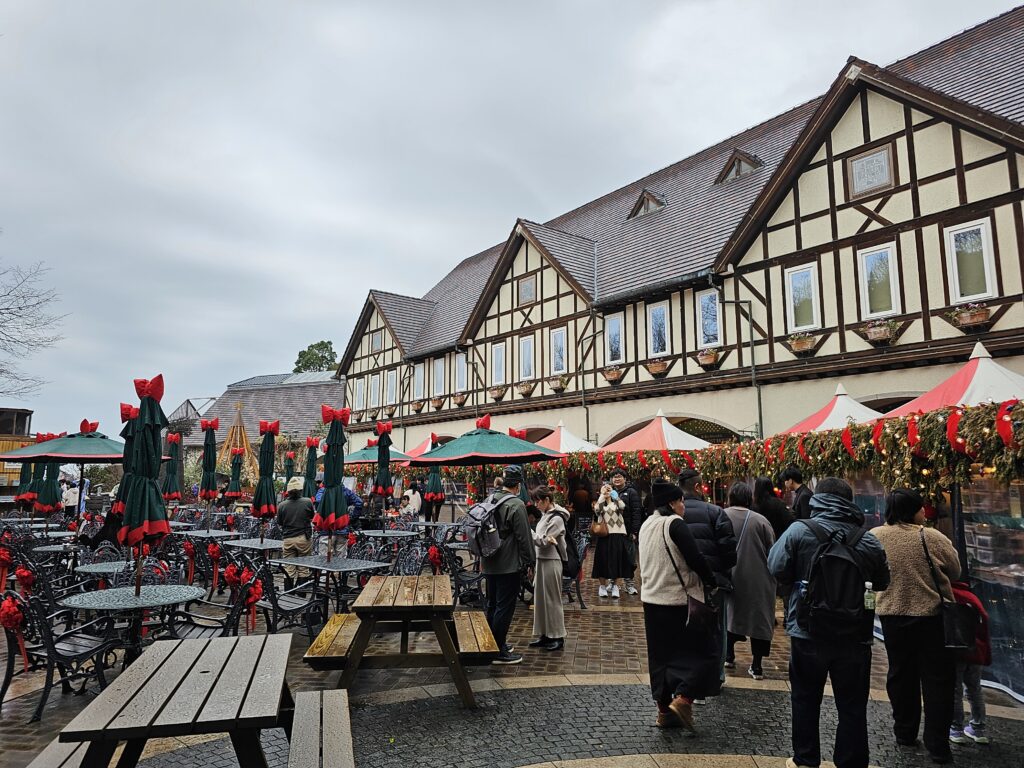
It’s a nice walk down the mountain with a paved, windy pathway that takes you through multiple types of herb and flower gardens.
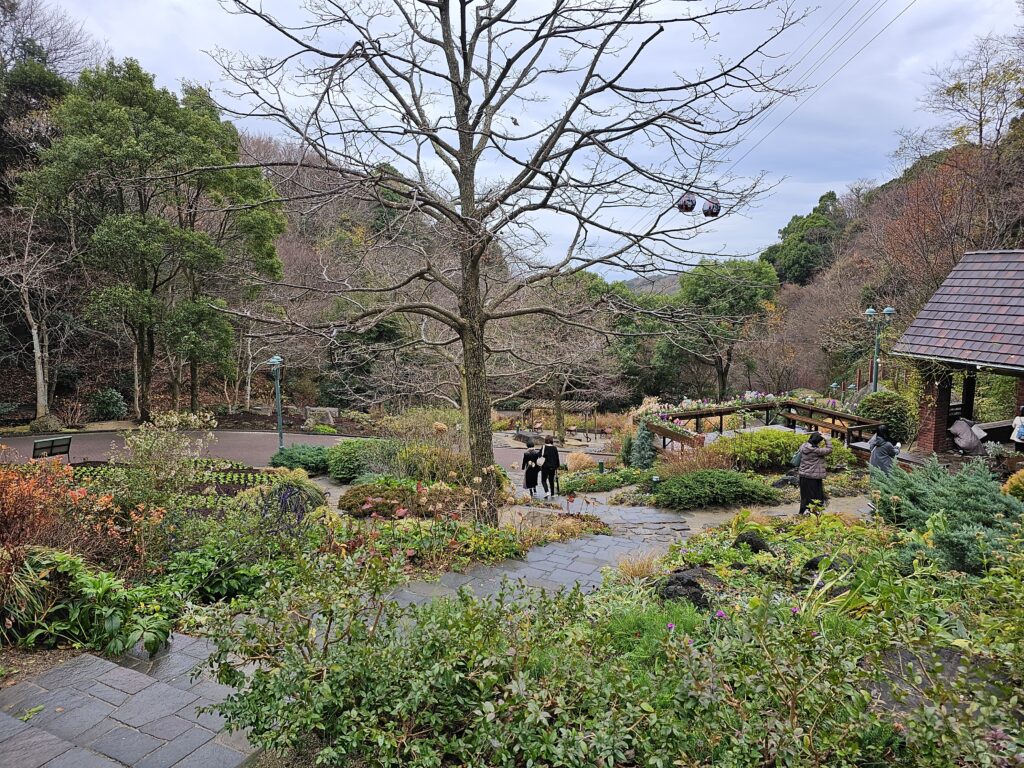
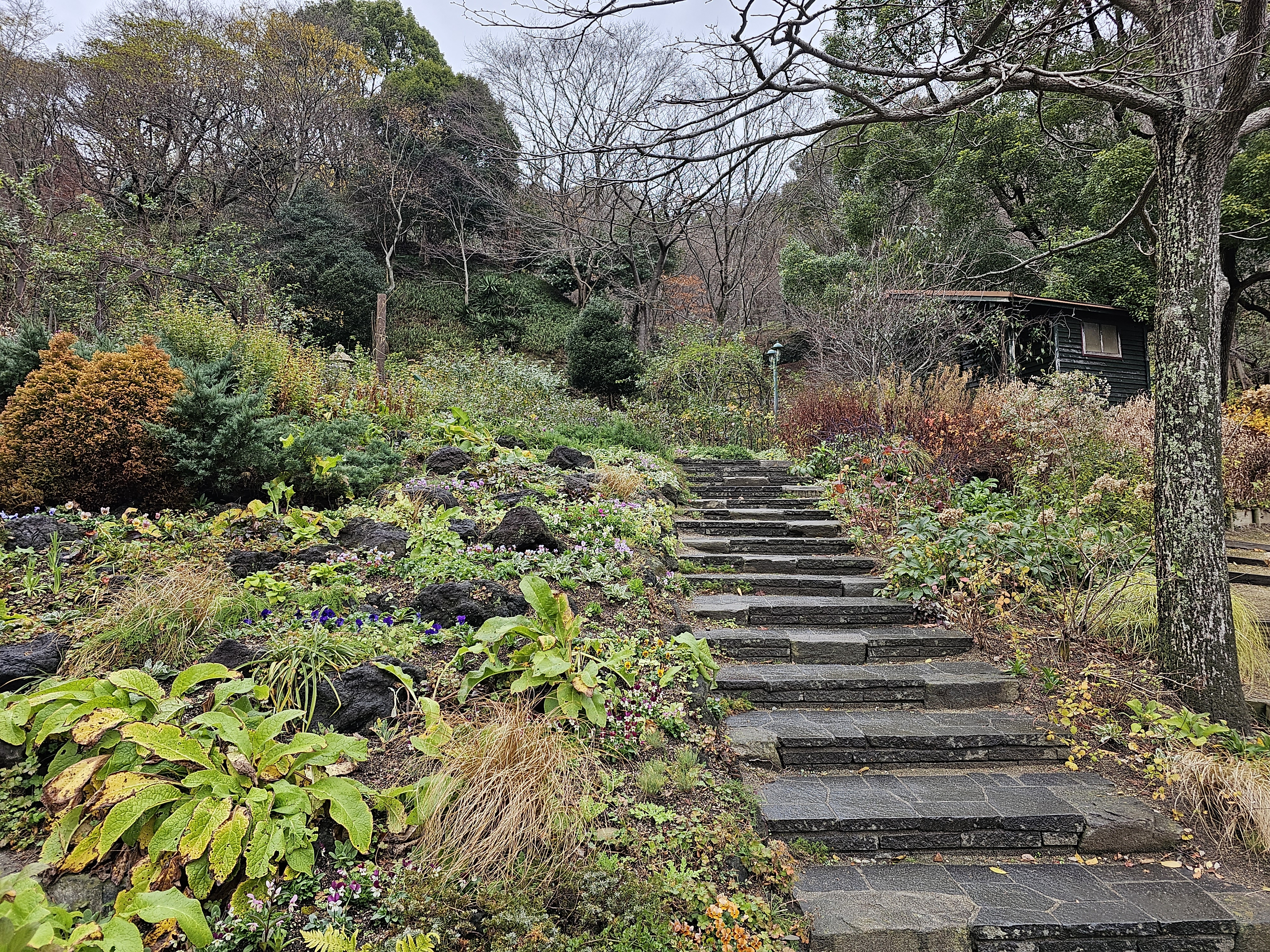
This pathway also leads you to the glasshouse which you can walkthrough and holds a cafe / lounge on the second floor, a herbal area where you can create your own household friendly scents and the “statue of love”
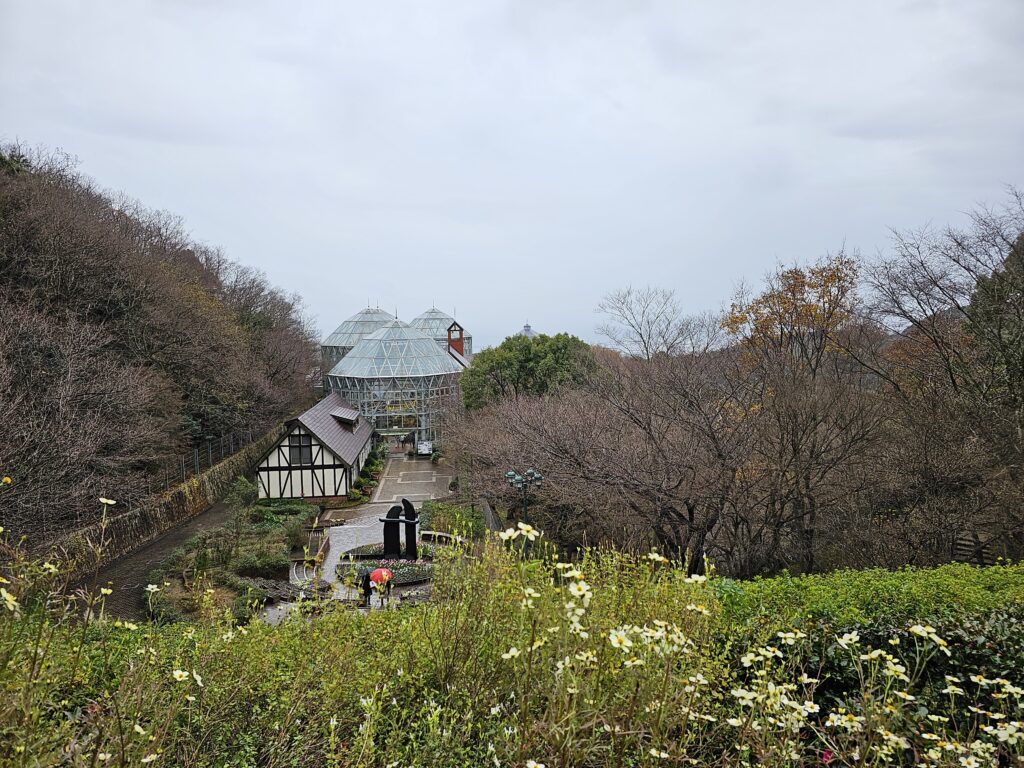
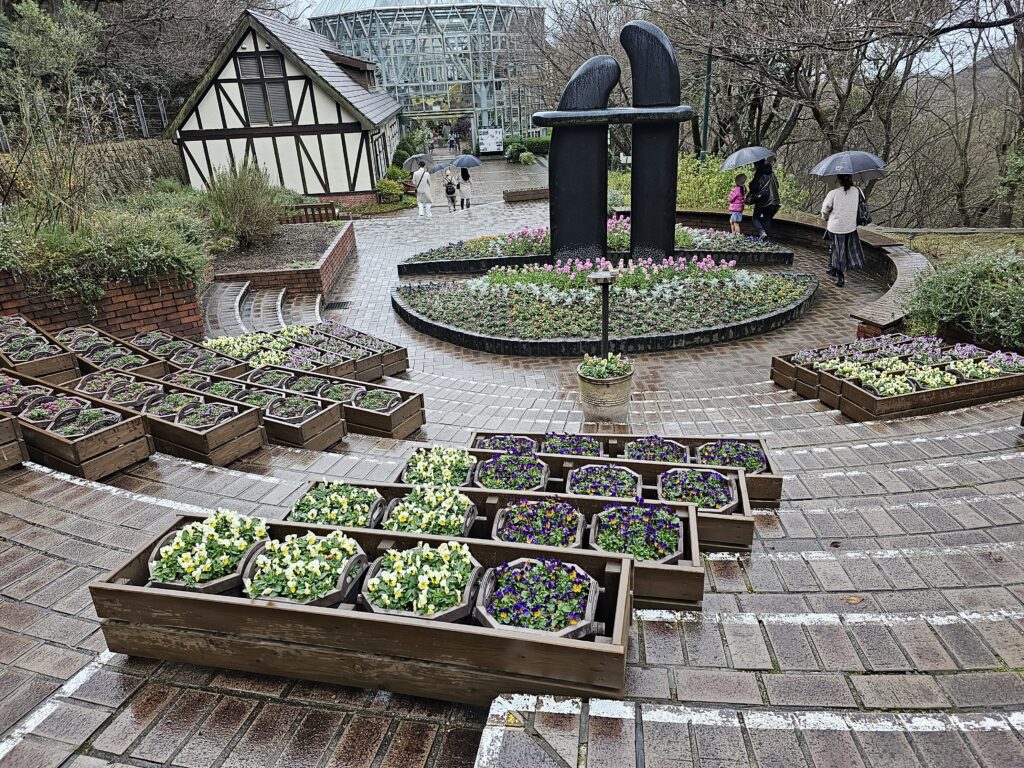
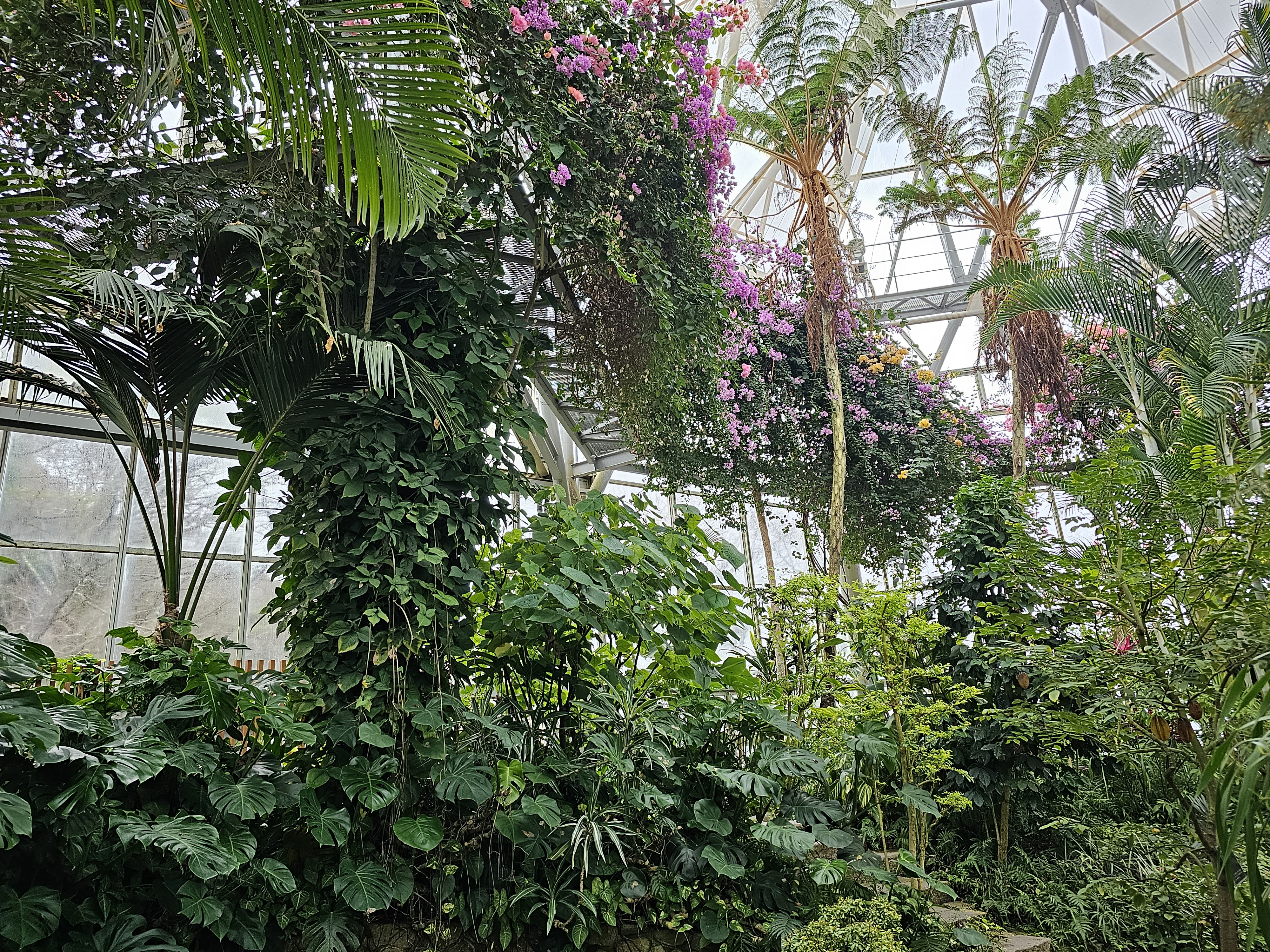
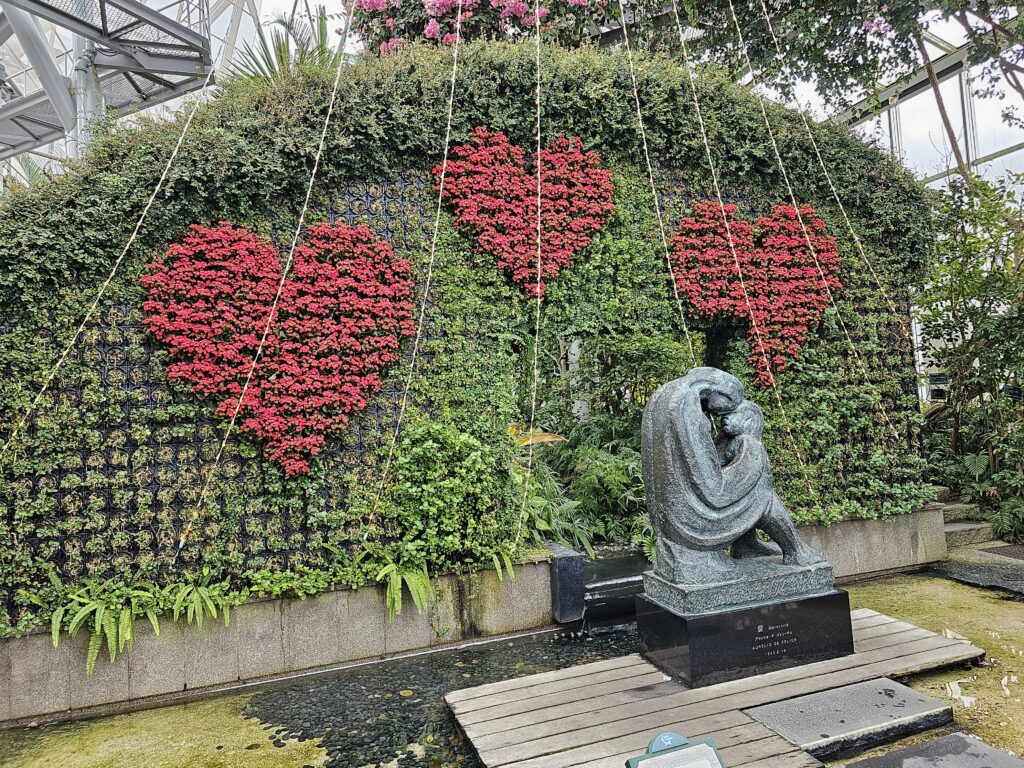
You can easily spend a few hours in total, at The Kobe Nunobiki Herb Gardens which is why it’s one of hte most popular things to do in Kobe. It’s a nice change of pace from the regular tourist attractions and is a great way to walk off all that food from the Kobe Chinatown!
Visit The Many Attractions At Meriken Park
Meriken Park is one of the most popular things to do in Kobe due to the abundance of attractions within it. A large, wide open park, home to some impressive contemporary architecture, and a spacious lawn, Meriken Park is great place to enjoy some outdoor sights all within walking distance to one another.
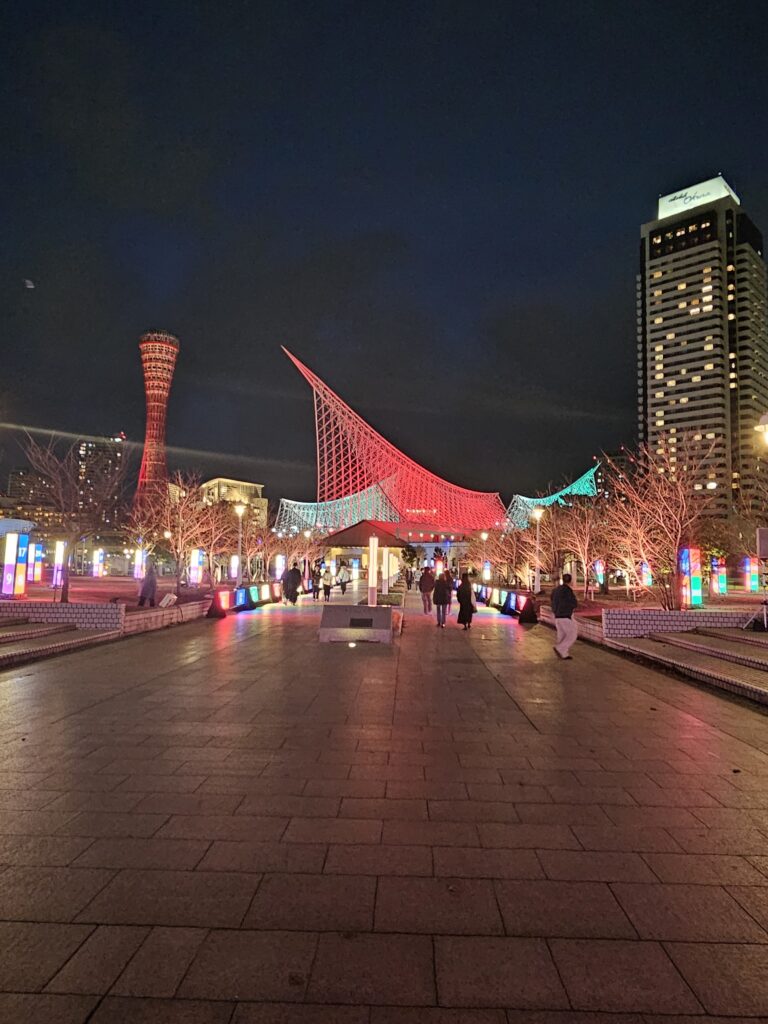
It’s also located right on the waters of the port and is a short walk from Harborland, which is major shopping area in Kobe.
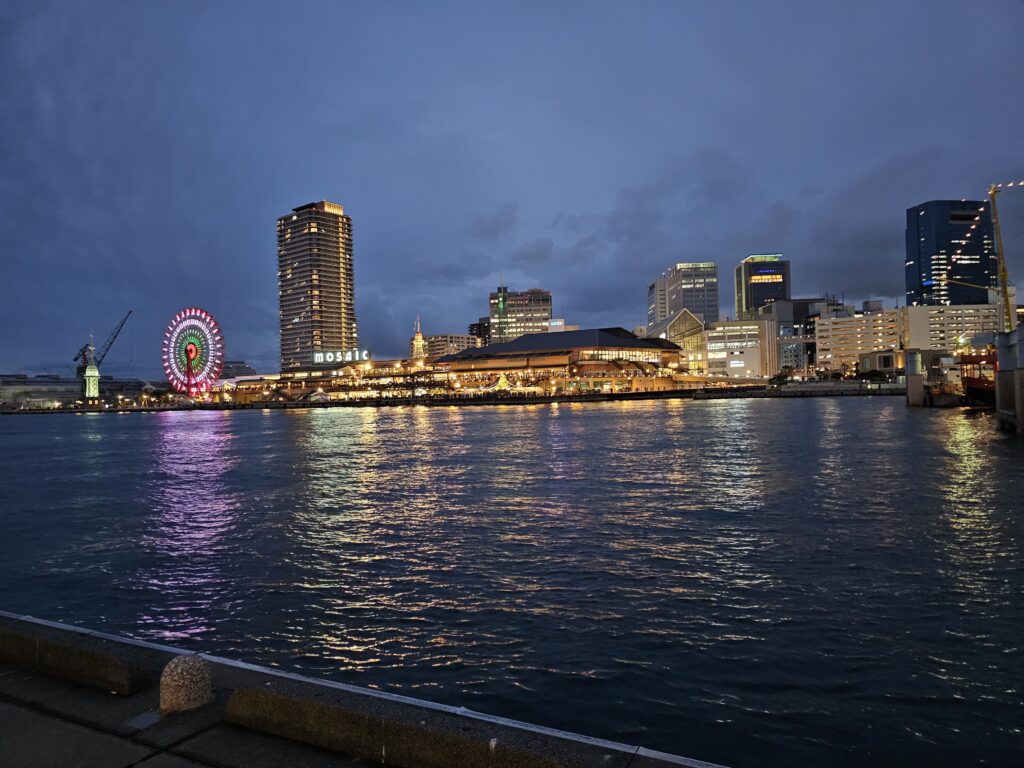
Kobe Port Tower
Kobe Port Tower is one of the attractions located within Meriken Park. Standing at 354 ft tall, the tower has multiple observations decks as well as an open air rooftop deck and cafe.
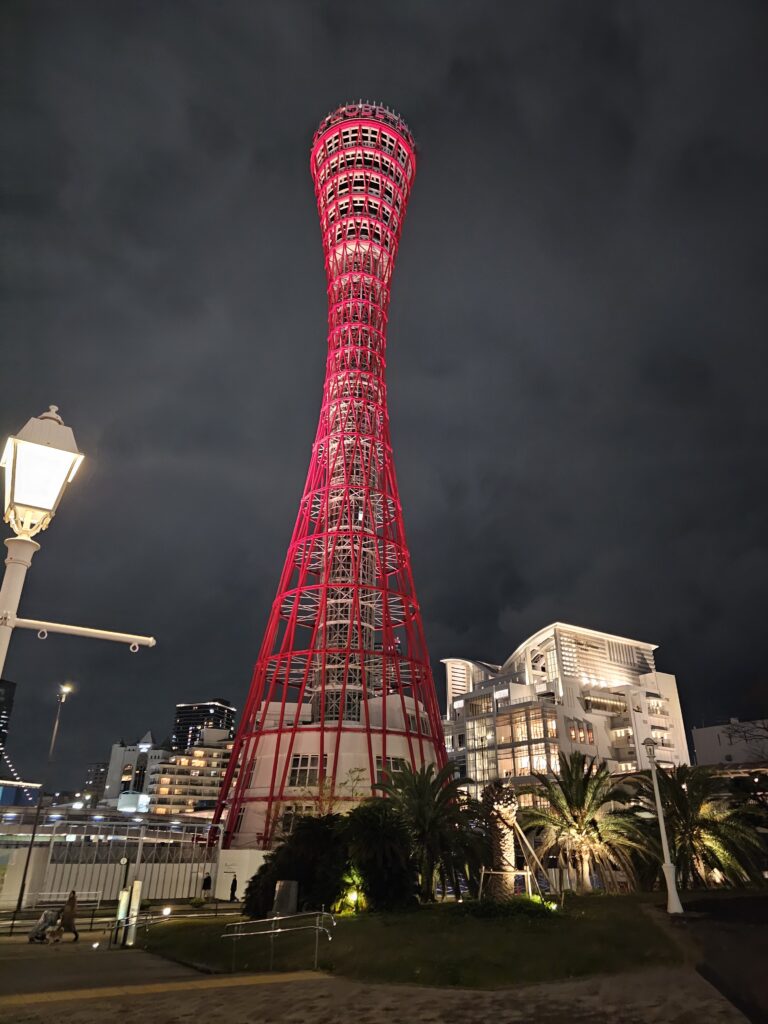
Port of Kobe Earthquake Memorial Park
The Port Of Kobe Earthquake Memorial Park is a small memorial for the victims who lost their lives in the port during the 1995 Kobe earthquake. Located in Meriken Park, there’s a small section of the waterfront area that was left unrepaired as a part of the memorial. It’s an opportunity for visitors to catch a small glimpse of the destructive power of the earthquake. It’s a somber area, but interesting nonetheless.
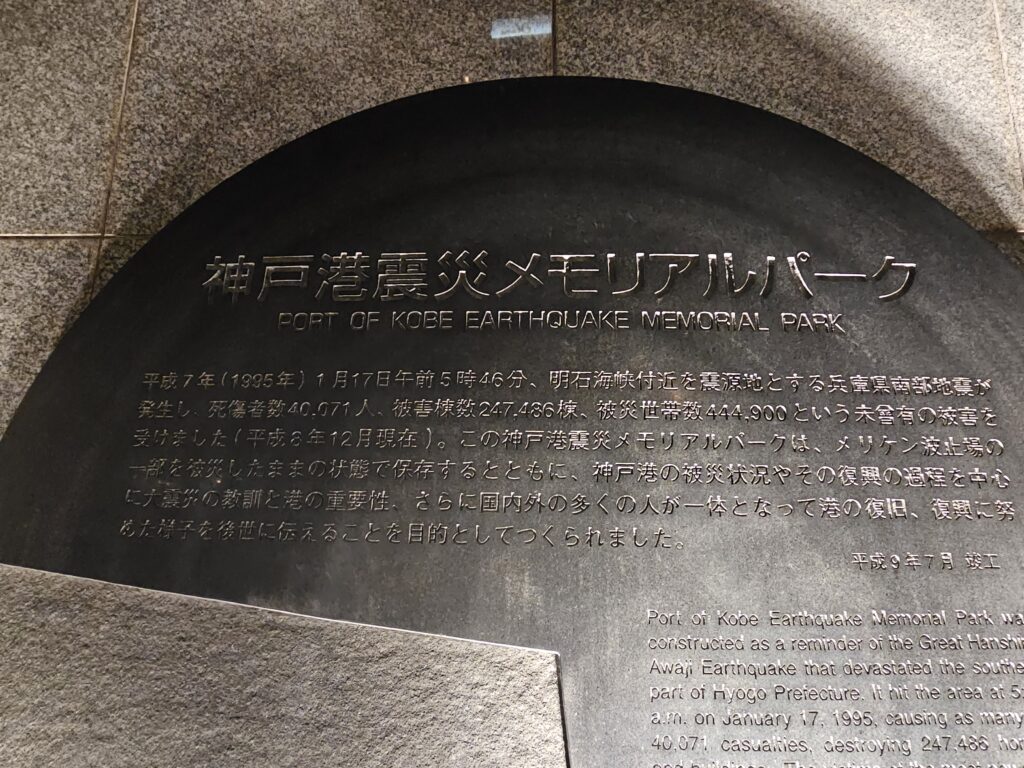
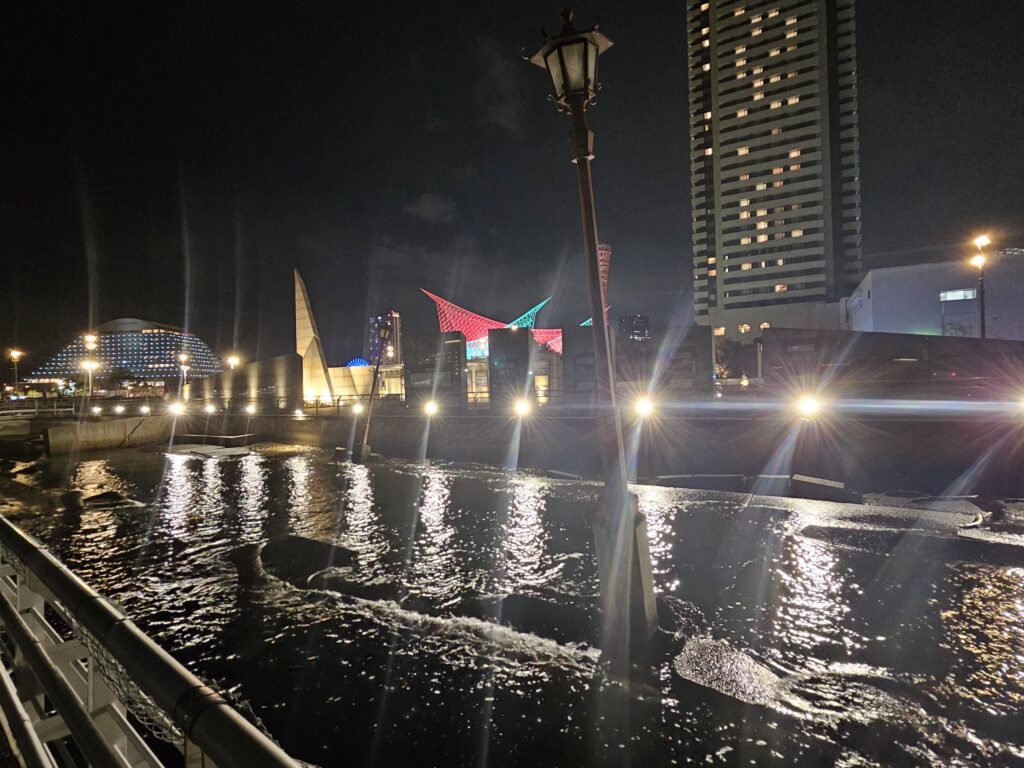
BE KOBE Sign
One of the most popular things to do in Kobe is taking a photo with the BE KOBE sign. The sign was built to commemorate the 20th anniversary of the 1995 earthquake. City Hall had this sign created to instill a sense of civic pride in the citizens of Kobe. If visiting the area at night, the sign is illuminated by colored lights on the base of the sign.
Unrelated, if you’re a big Kobe Bryant fan like myself, the sign has a different type of significance and is pretty special to see.
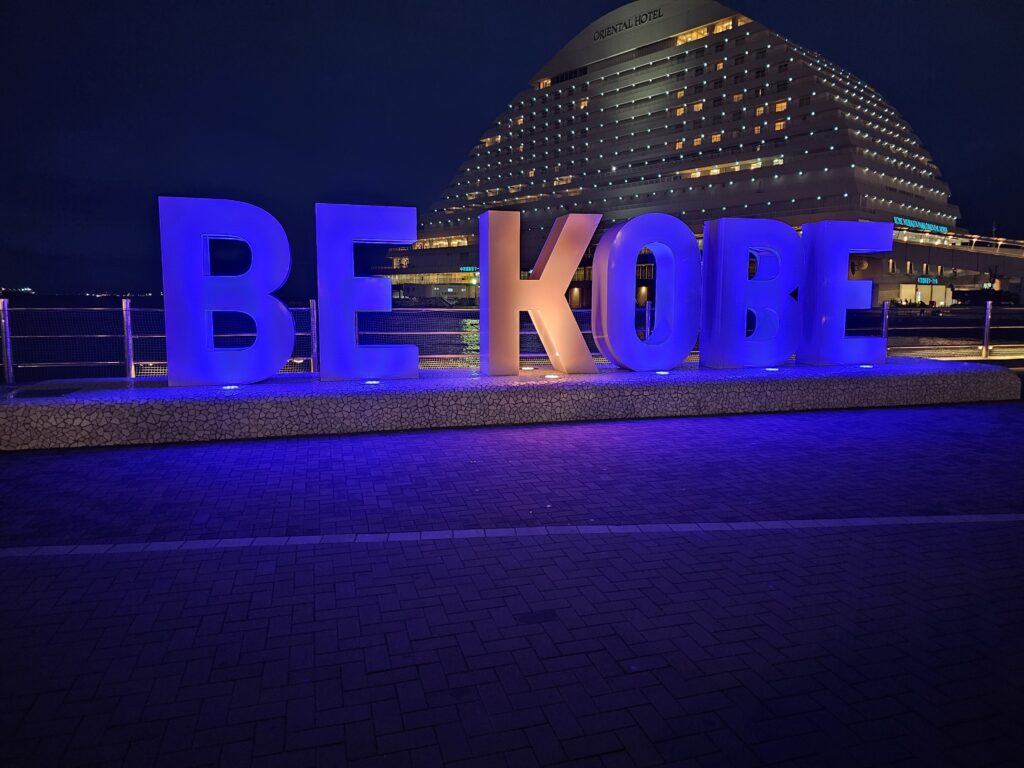
-
Meriken Park In Kobe Is Home To Many Visually Exciting Sights
Table of Contents
Meriken Park is one of the more popular places to see while visiting Kobe. Located in the Kobe port area, the water front park is home to several attractions.

Meriken Park
In Meriken Park you can find the iconic Kobe Port Tower, Kobe Maritime Museum, the Port of Kobe Earthquake Memorial, the Be Kobe sign.
What made this area stand out to me was all the contemporary architecture found throughout the park with the Kobe Port Tower and Kobe Maritime Museum at the forefront. There’s also a variety of different works of art throughout the park which was really cool to see, especially at night since everything was lit up.
The park is wide open with lots of open space and large paved pathways to get around. There’s a spacious lawn as well which would be a great spot to chill and have a snack and drink when the weather is nice.

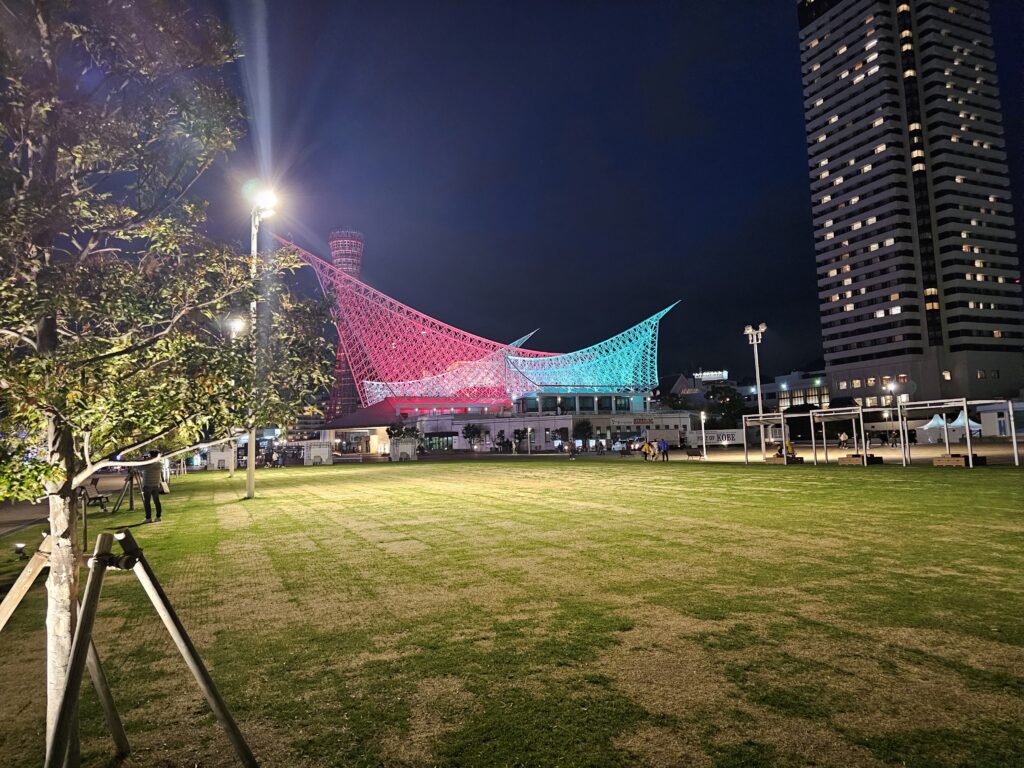
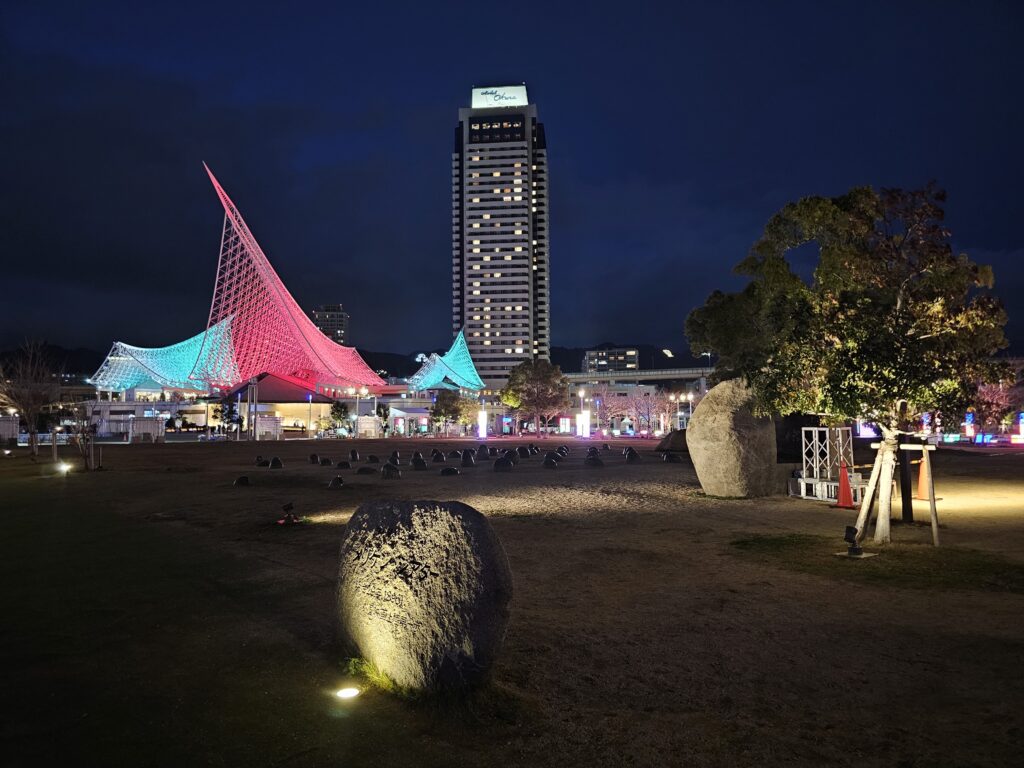
Kobe Port Tower
Built in 1963, the red painted Kobe Port Tower is hard to miss. Standing at 354 ft tall, the tower has multiple observations decks as well as an open air rooftop deck and cafe. I didn’t get the chance to enter the tower and go up it to get the views this visit, but the structure itself was unique looking with its design and it’s distinctive red color.

Port of Kobe Earthquake Memorial Park
1995 is the year that a massive 6.9 earthquake devasted Kobe. The Port Of Kobe Earthquake Memorial Park is a small memorial for the victims who lost their lives in the port during the earthquake. A small section of the waterfront area was left unrepaired as a part of the memorial and for visitors to catch a small glimpse of the destructive power of the earthquake.
It’s defintely a somber area, knowing what transpired here, but the small informational placards detailing the effects of the earthquake and relief efforts are certainly interesting.


BE KOBE Sign
This distinctive sign located in Meriken Park was built to commemorate the 20th anniversary of the 1995 earthquake. City Hall had this sign created to instill a sense of civic pride in the citizens of Kobe. It’s a popular attraction in Kobe and specifically Meriken Park.
The sign has lights on the base of it which provide different colored lighting. On this particular night it was illuminated in purple and gold. I’m not sure if this is always the case, but being a Kobe Bryant fan this was pretty awesome to see. I know the sign is for the city, but being a Kobe fan it had a bit of dual meaning for myself and the Mamba mentality.
It was definitely cool to see it illuminated in purple and gold the night I went.

Is Meriken Park Worth A Visit?
Meriken Park is certainly worth a stop if visiting Kobe. There’s quite a few attractions to be seen within it. The park is wide open with ample space and between the Kobe Port Tower, Kobe Maritime Museum, the Port of Kobe Earthquake Memorial, and the Be Kobe sign, there’s plenty to see with lots of opportunities for photos. That’s not mentioning the walk around the port itself. With some great waterfront views, just cruising around on the outskirts of the park taking in the nice ocean breeze is quite nice and relaxing.
The nearby Harborland, which is a huge shopping and entertainment area featuring two malls and the Mosaic, which consists of a ton of restaurants are also extremely popular places in Kobe. It’s another huge area with lots of shopping and food options to choose from. There’s also a ferris wheel that looks out on the port. Harborland is right next to Meriken Park and is an easy walk if you’re looking to hit two birds with one stone!

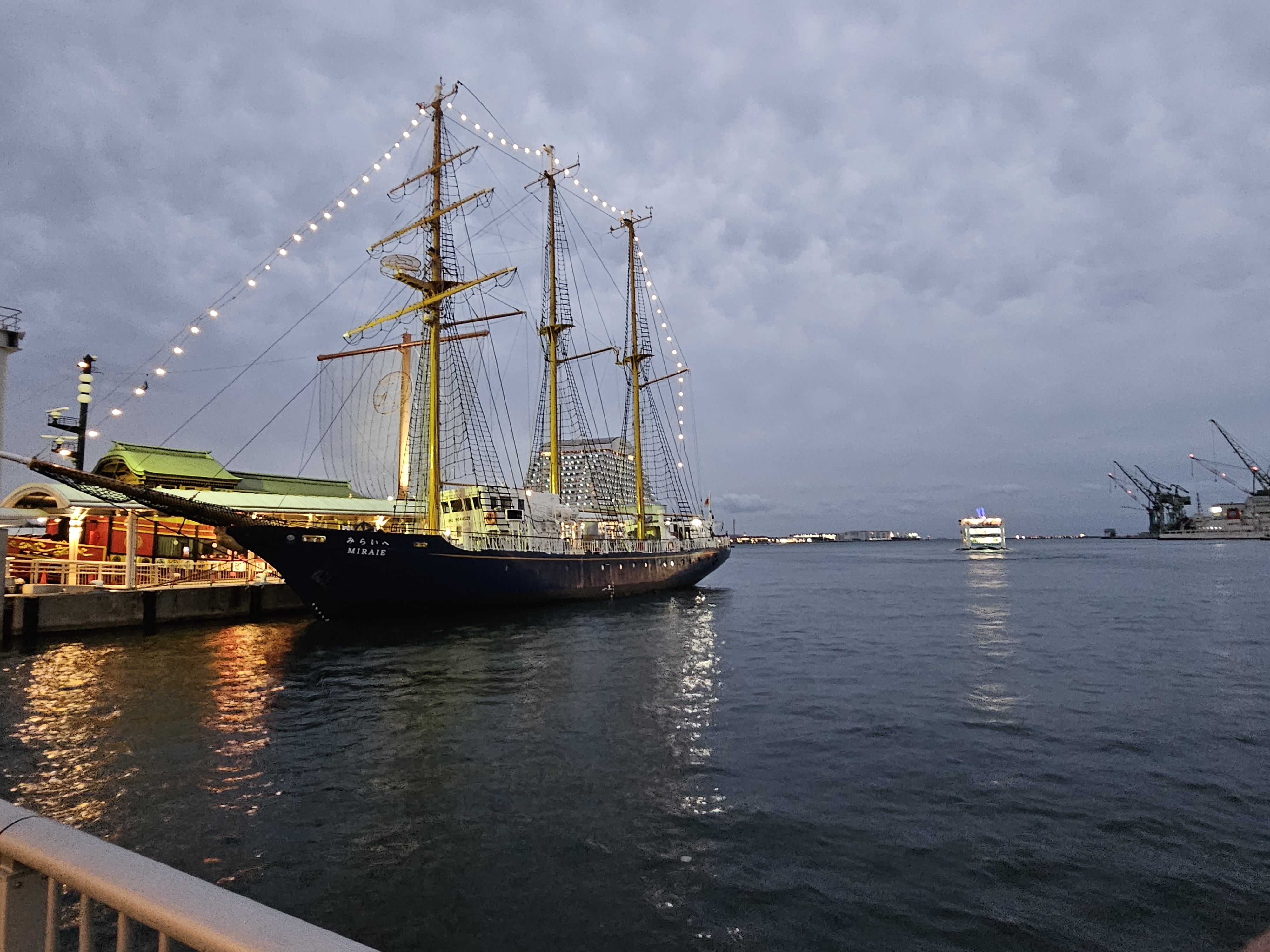
-
Exploring Kobe Nunobiki Herb Gardens: A Hidden Gem in Japan
One of the biggest attractions in Kobe is the Kobe Nunobiki Herb Gardens. With over 75,000 herbs and flowers spread across 12 gardens, the premises contains a fragrance museum, gift shops, a restaurant and cafe, and other exhibits. A ropeway takes you up to the garden and then a long winding trail takes you through the gardens until you reach a ropeway station that takes you back down the mountain, if you choose.
Table of Contents
The Kobe Nunobiki Ropeway
Located on Mt. Rokko above Kobe, the best way to access Kobe Nunobiki Herb Gardens is via the Kobe Nunobiki Ropeway. A round trip which also provides access to the garden, will set you back 2000 yen ($12.43 USD), a one-way ticket is 1400 yen, ($8.70 USD).
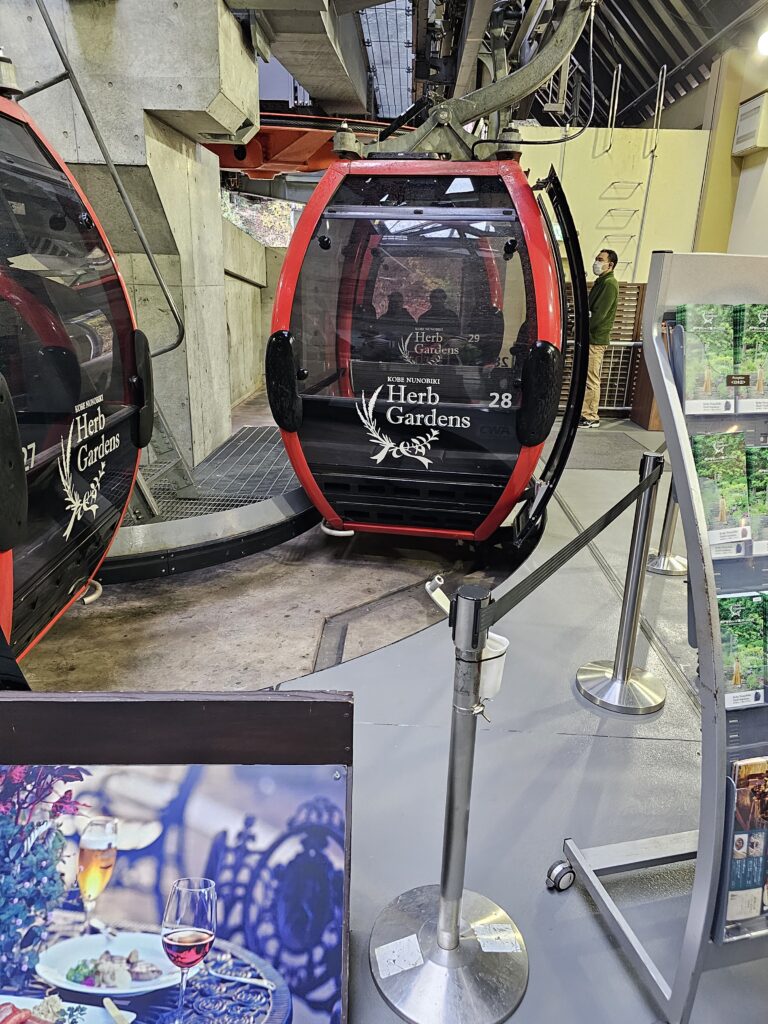
The ride up takes about 10 minutes and provides some great views of the city, ending at the top station. I’m sure even better if it wasn’t a little drizzly on the day I went!
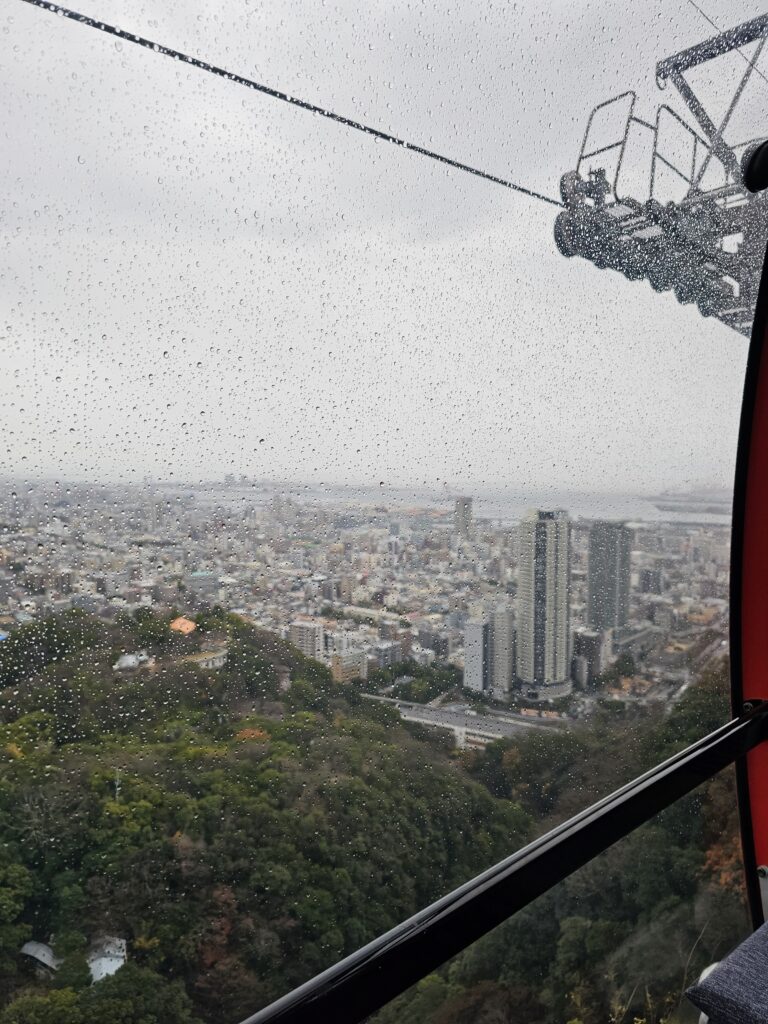
Kobe Nunobiki Herb Garden View Plaza
Once you exit the station it opens up to what is called the rest house. This building is designed after an old German castle and includes souvenir shops and snacks and refreshments. The Kobe Nunobiki Herb Gardens view plaza is also here which offers seating where you can enjoy your snacks amongst the beauty of the rest house and garden.
I’m not sure if they alway have little boutique tents up throughout the year, but during Christmas time they had tables set up selling ornaments and other Christmas decorations / trinkets.

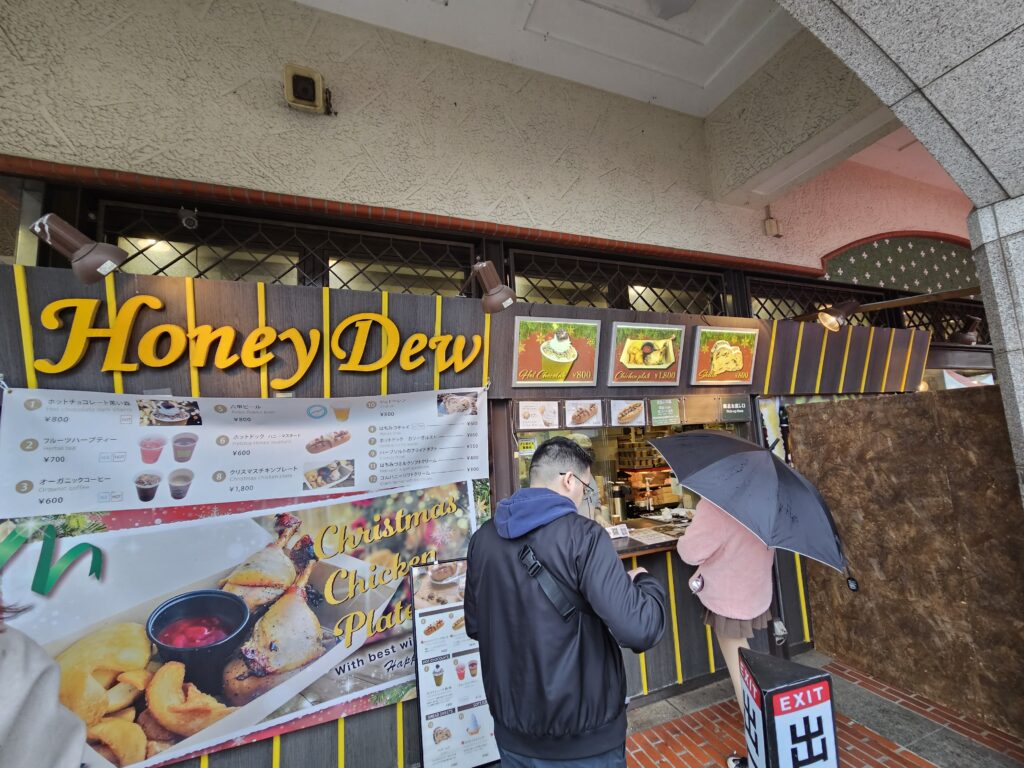
Honey Dew is a part of the Kobe Nunobiki Herb Gardens view plaza and you can pick up some food and drinks here. I had just come from Kobe’s Chinatown so wasn’t very hungry but still got a little snack. I got a honey chai (600 yen, $3.73 USD) and honey comb soft ice cream (800 yen, $4.98 USD). They give you some extra honey you can drizzle over the soft serve which was great!
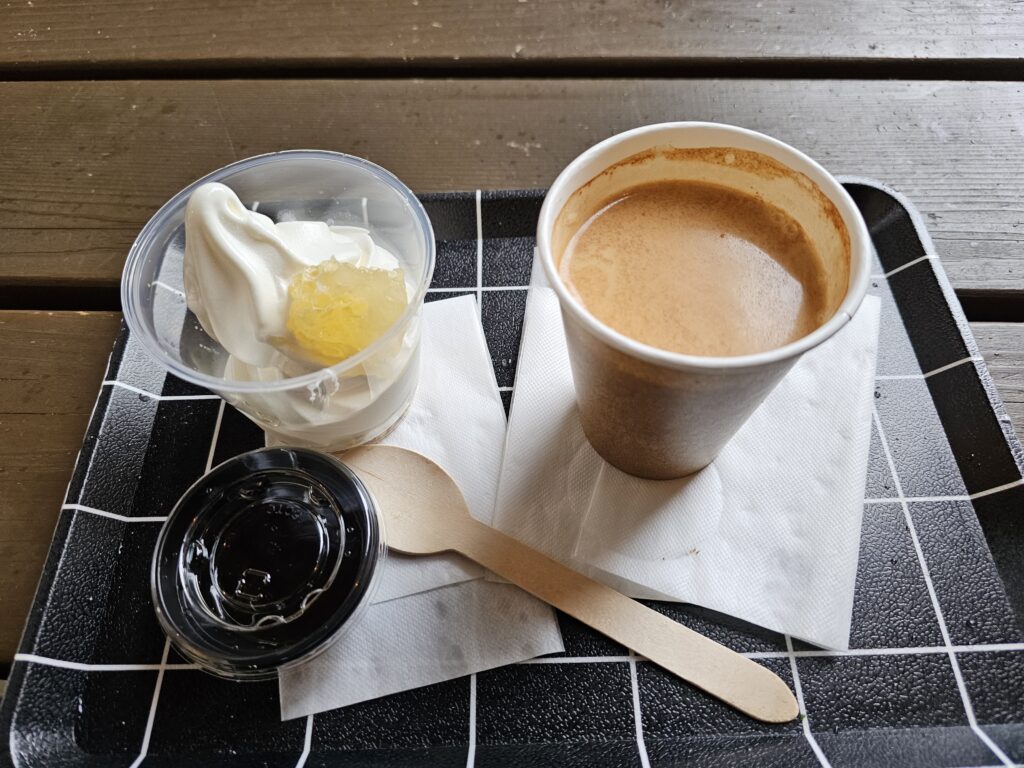
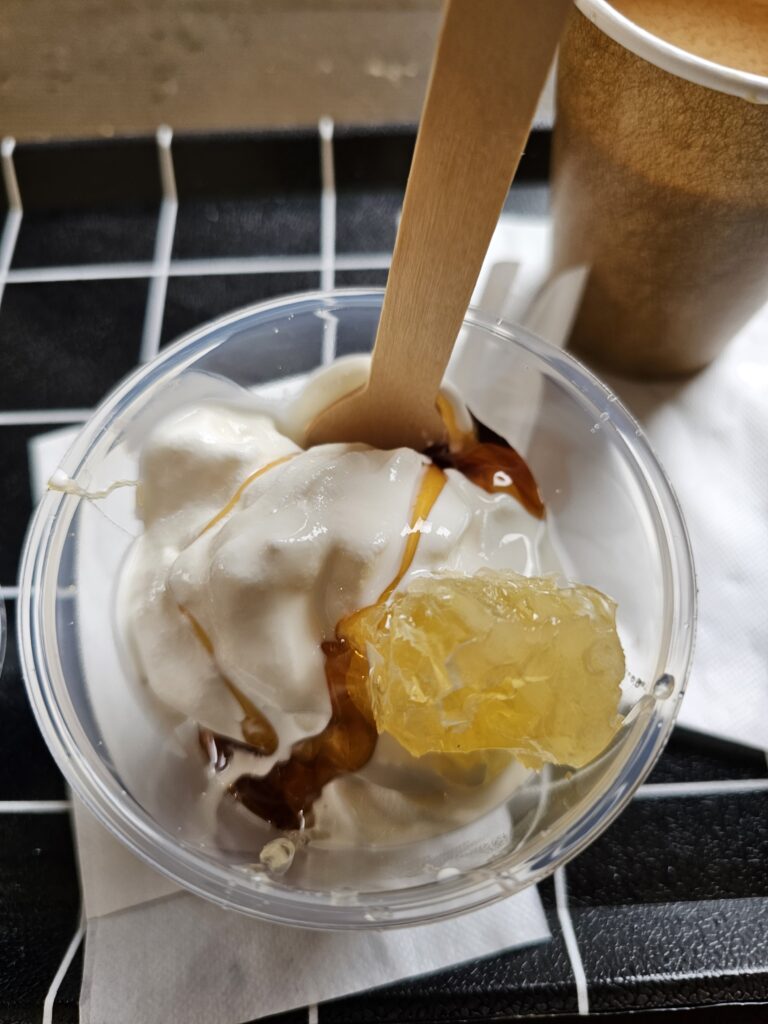
Also, at the Kobe Nunobiki Herb Gardens view plaza is the rose garden which is home to over 60 different types of roses and the fragrance museum / concert hall. The fragrance museum has a huge array of unique, natural smelling perfumes and oils that can be purchased. It’s fun to peruse and smell the various fragrances they have concocted in this little museum!
The concert hall is located upstairs. It’s basically a medium-sized room that looked like it could seat 100+ people with a small stage. When I was there there was a pianist that was performing. There’s an admission fee to see the performers here. I had wandered upstairs exploring and didn’t actually attend the show but you could still hear the music which was nice.
The view plaza also offers a great panoramic view of the city, floating above the tree top strewn horizon, pretty cool.
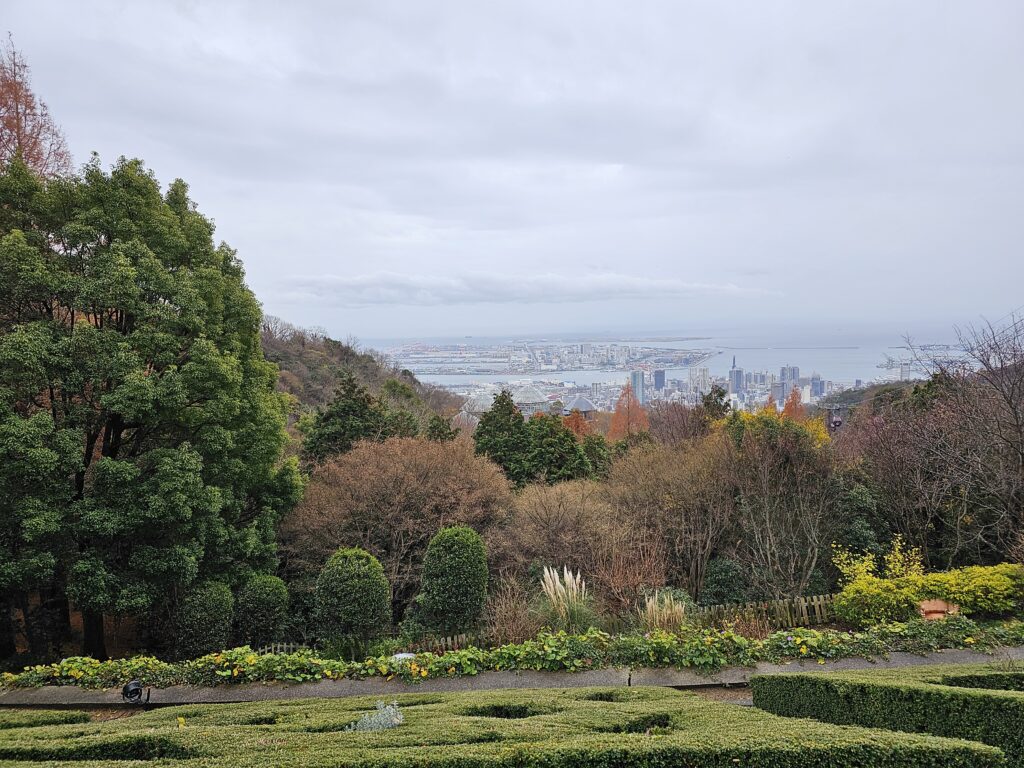
The Walk Through Kobe Nunobiki Herb Garden
Something that is really cool about this experience is the way the Kobe Nunobiki Herb Garden is designed. The paved, winding paths take you through multiple types of herb and flower gardens. This path and how it interweaves throughout these numerous gardens is aesthetically pleasing. I went in the winter time and it found it to be quite peaceful and pleasing but can only imagine what this little journey would like when everything is in full bloom.


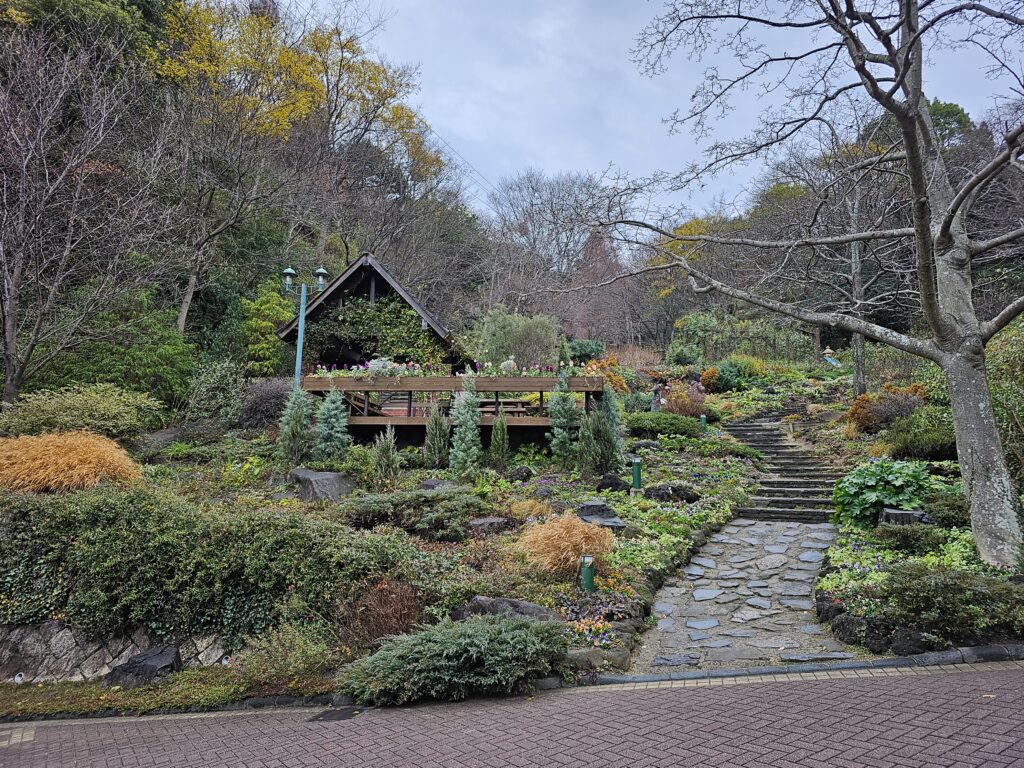
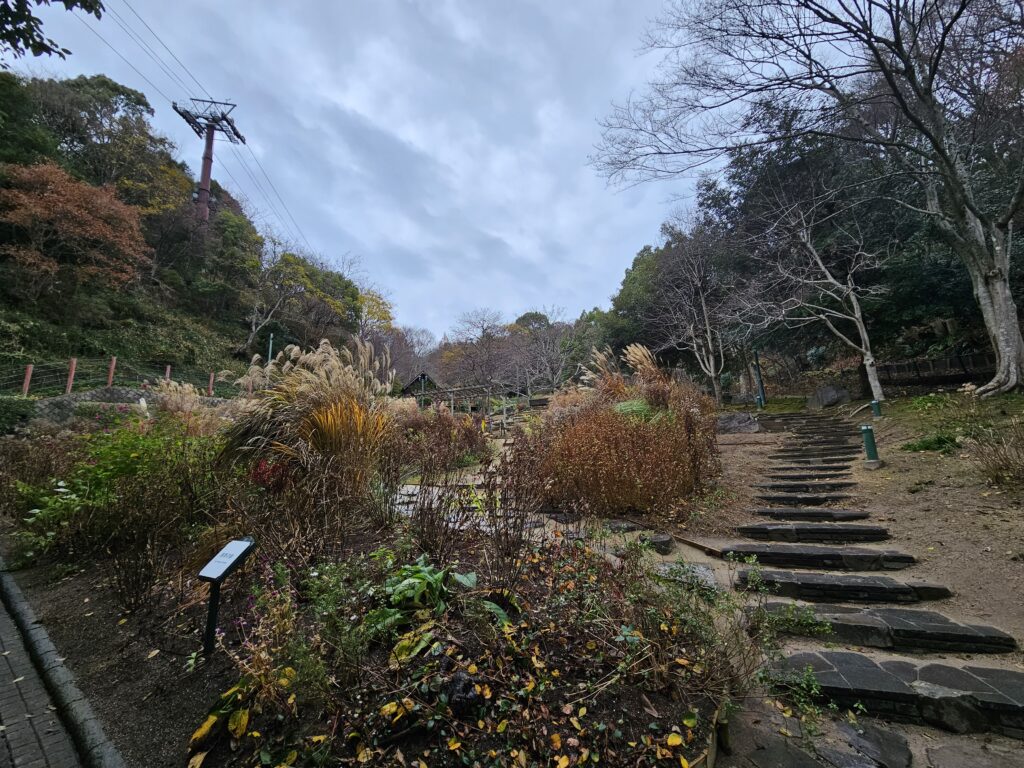
Kobe Nunobiki Herb Garden Glasshouse
This pathway eventually takes you down towards the glasshouse.


The glasshouse is quite large. It’s full of lush plant life within, complete with a little stream running through it. There’s also a cafe / lounge on the second floor, a herbal area where you can create your own household friendly scents, the “statue of love”, and even an herbal footbath located outside on the back of the glasshouse.
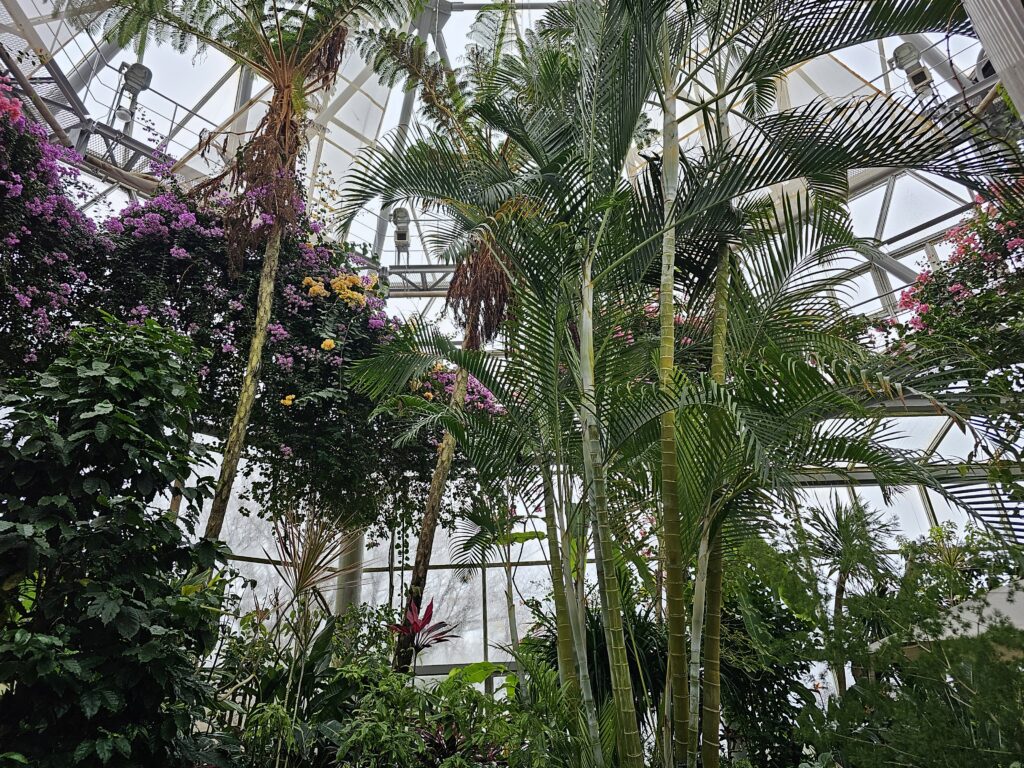


The End Of The Journey
Towards the end of walk back down the mountain there’s a great little recreation area. This wide open lawn area includes a slew of hammocks where you can literally kick your feet up and relax a bit while enjoying a nice view of Kobe while watching ropeway carts zooming up the mountain.
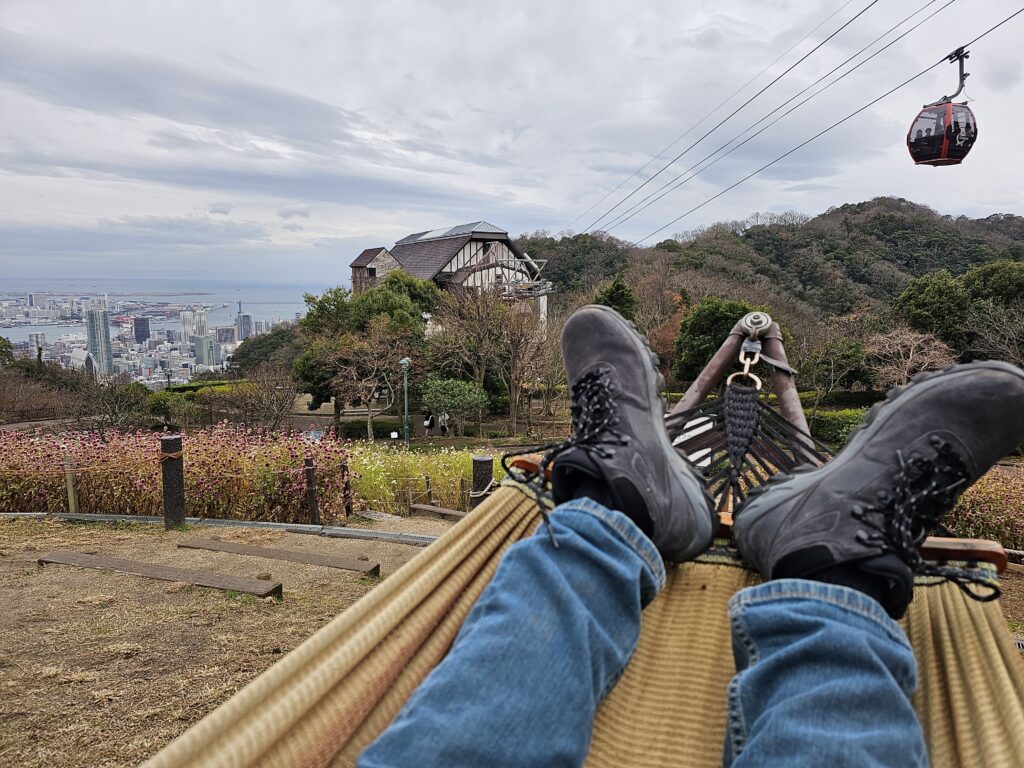
Overall, Kobe Nunobiki Herb Gardens is a really nice, peaceful place to come and visit if you’re in Kobe. The unique architecture of its rest house and the fantastic walk through the gardens is a nice change of pace from other touristy types of attractions. I highly recommend visiting if in Kobe!
-
Exploring One Of Japan’s Largest Chinatown’s (Nankin-machi) in Kobe
The Kobe Chinatown is one of Japan’s three largest Chinatown’s in the country. The other two being located in Yokohama and Nagasaki. It’s one of the major tourist attractions in Kobe and is a must visit for any serious foodie!
Table of Contents
Kobe Chinatown (Nankin-machi)
First developed in 1868 by Chinese merchants when the port of Kobe first opened, the small, compact area became known as “Nankinmachi”, named after China’s former capital city. The entire area is only 270 meters east to west and 110 meters north to south, so this is a very compact area. It’s jam packed with over 100 shops, food stalls, and restaurants.
The two main streets in Nankin-machi converge into an open area called Nankinmachi Square. Here you can find the Azumaya pavilion which is a hexagonal, two-tiered roof, gazebo. The square is a popular location where many people mill around eating food and just hanging out. Definitely good energy here!

The Food
There’s so much food in Nankin-machi, it’s pretty tough to decide where to start initially. But after taking a walk around you start seeing that a lot of the stalls are selling the same kind of foods. I decided to go to places that had the longer lines or seemed to have a different variety of food compared to other stalls.
The first item I got was pork slices bao (300 yen, $1.86). The bao was very soft and fresh, they steam it right in front of you. The pork slices were a little tough, tasty, due to the sweet sauce which was lathered all over it but a little too tough for my liking. This was just decent overall.
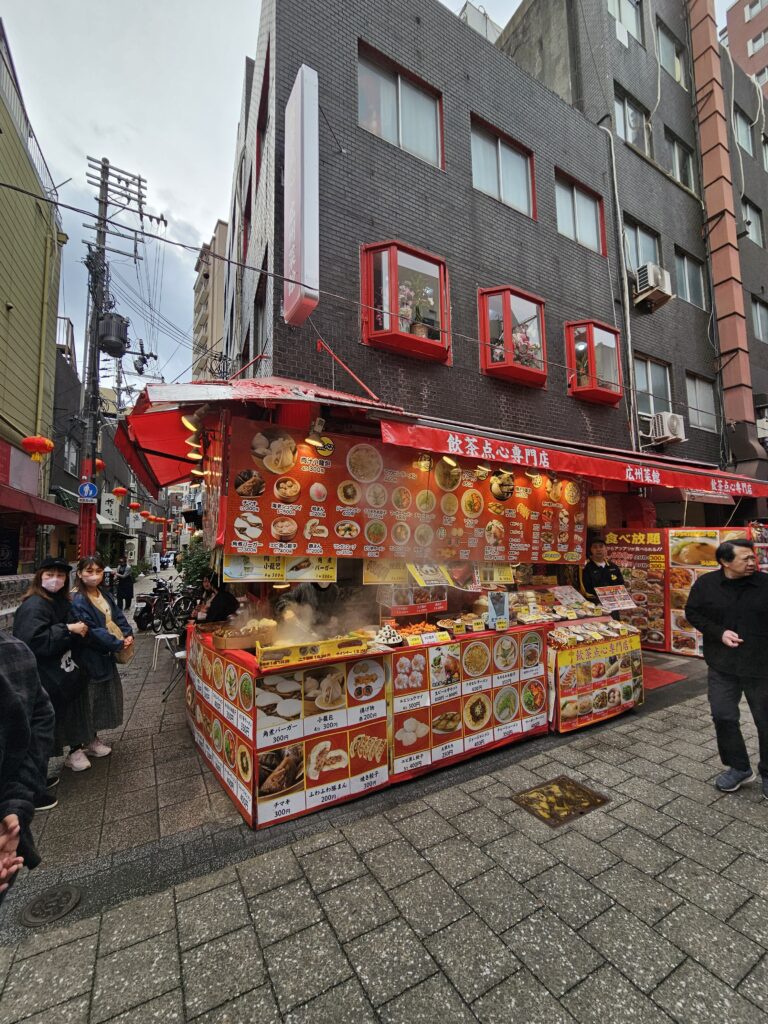
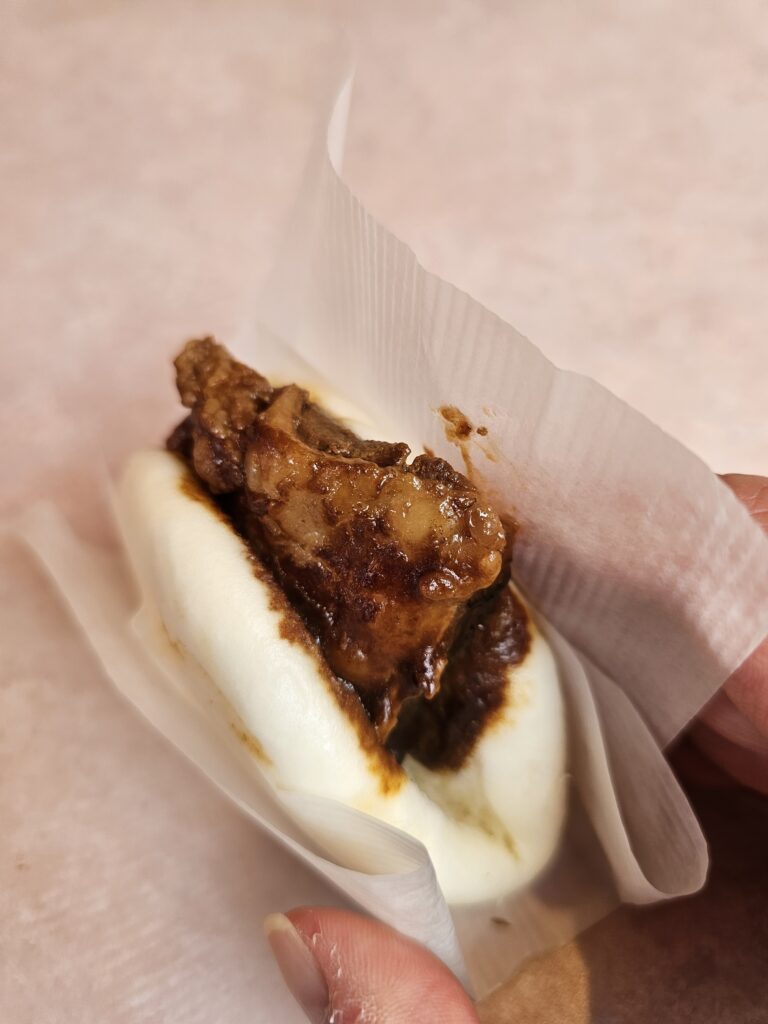
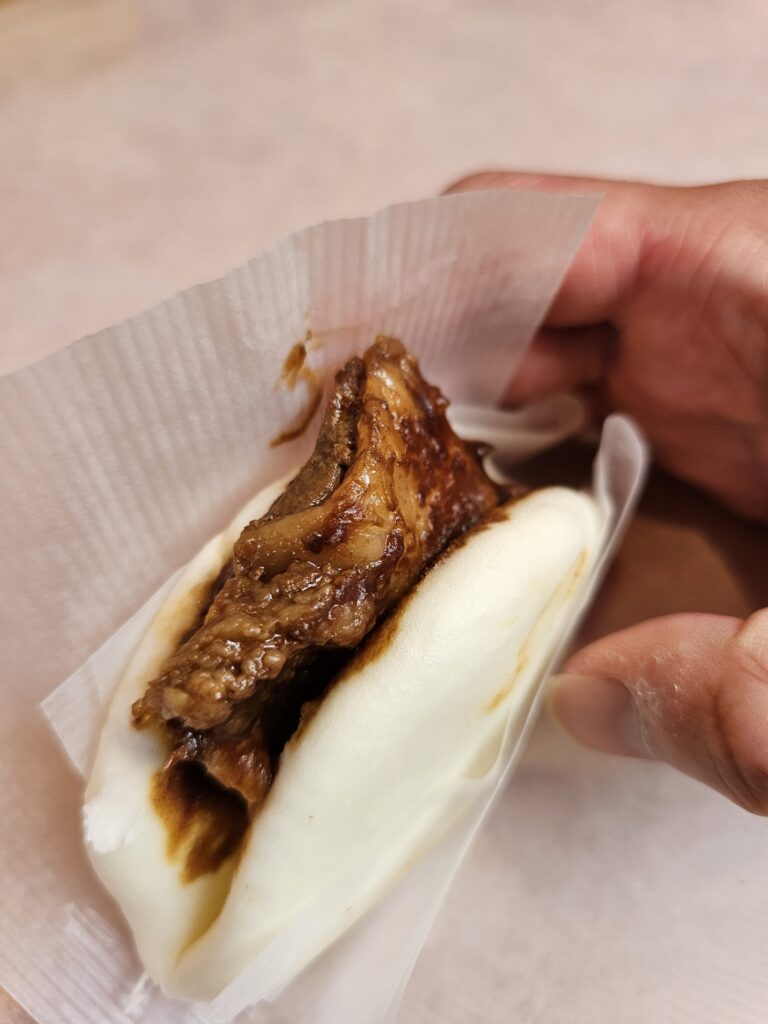

The next street food I got was a duck burrito (400 yen, $2.48 USD). This was wrapped in a thin sort of rice paper. Inside of the rice paper was a nice chunk of duck, thinly sliced cabbage, and a sweet dark sauce.
This was a tasty little “burrito”. The duck was really juicy and tender and the skin nice and crispy. The subtle crunch of the cabbage and the tasty sauce combined well with the duck.
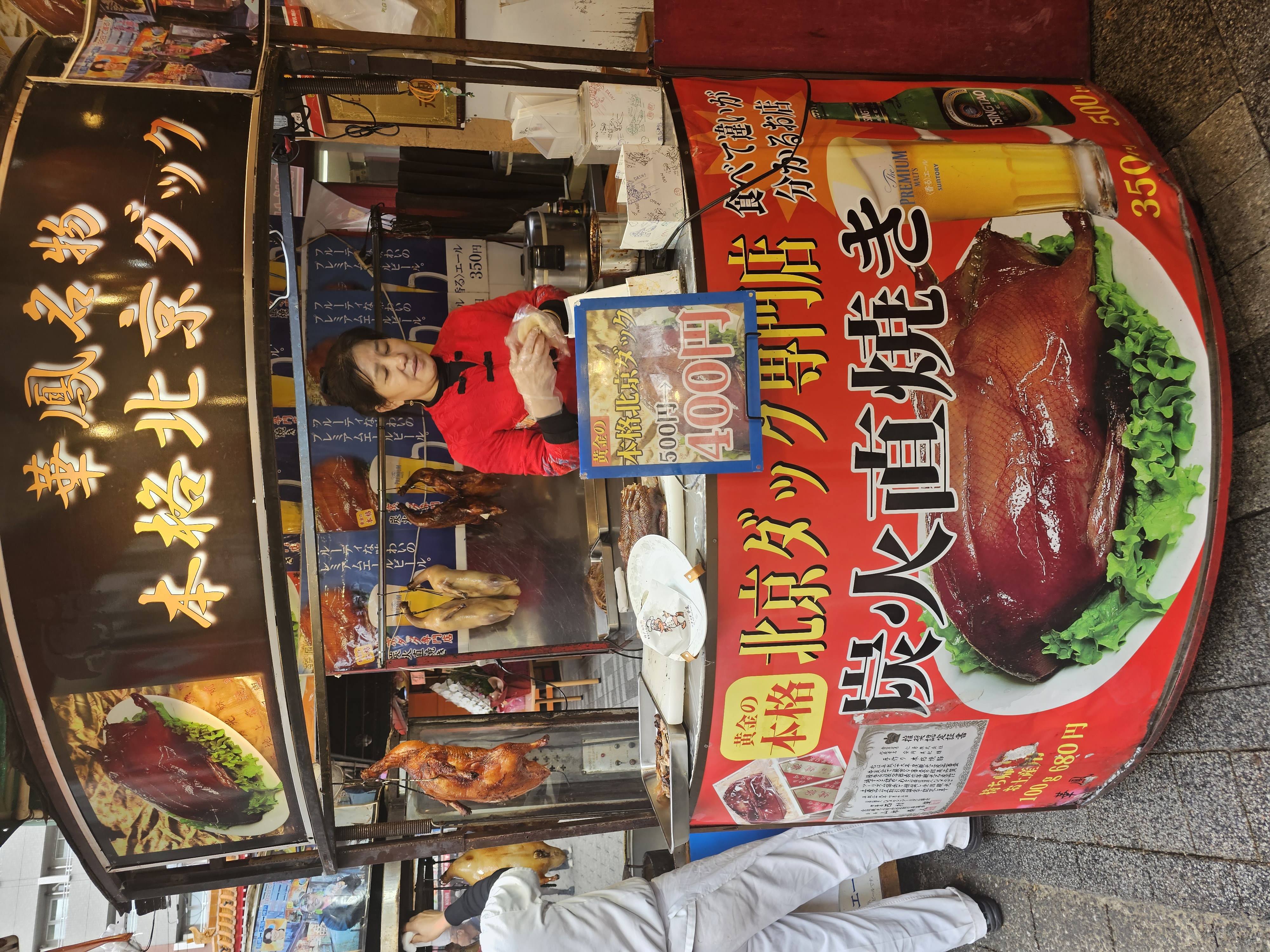
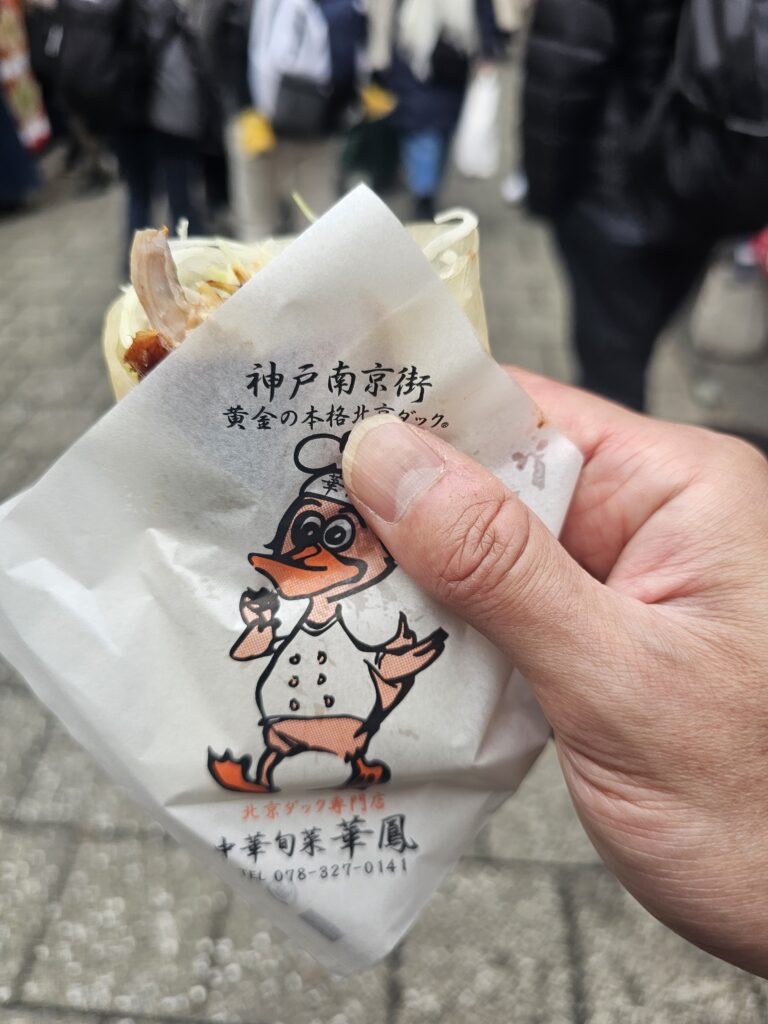

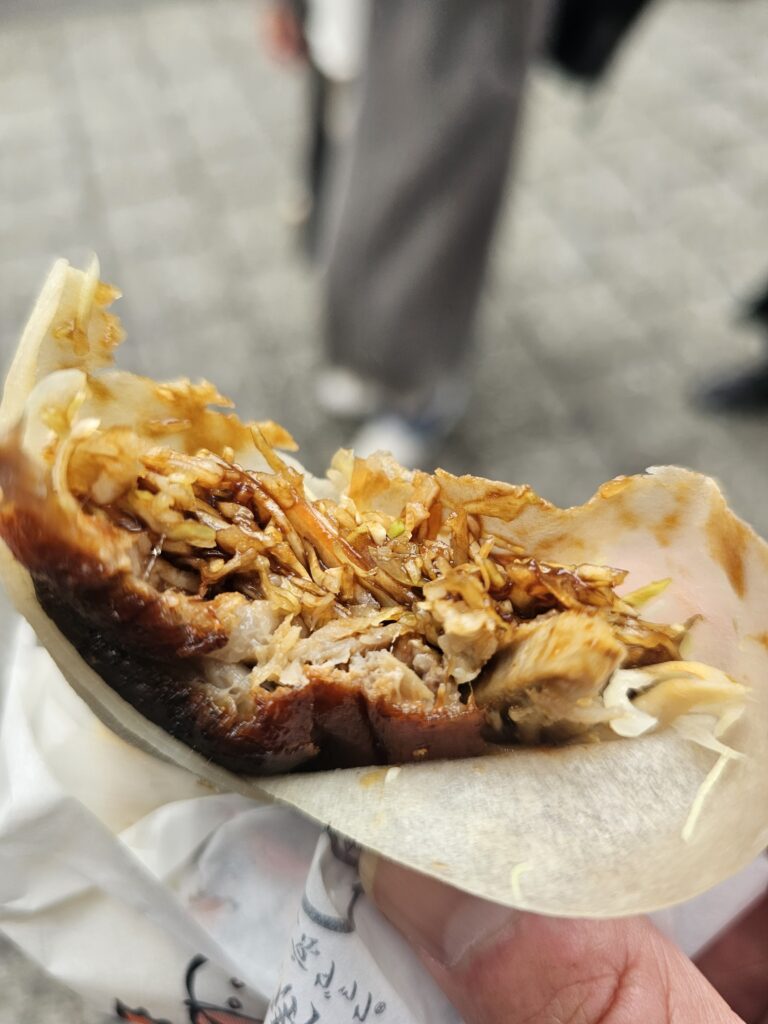
Next up was a steamed pork bun. This was a HUGE dumpling, more like 2 or 3 dumplings in 1 (300 yen, $1.86). This came out piping out but came at a price. This was over steamed with the dough a little mushy. The pork filling was flavorful but the mushiness of the steamed bun took away from the experience.

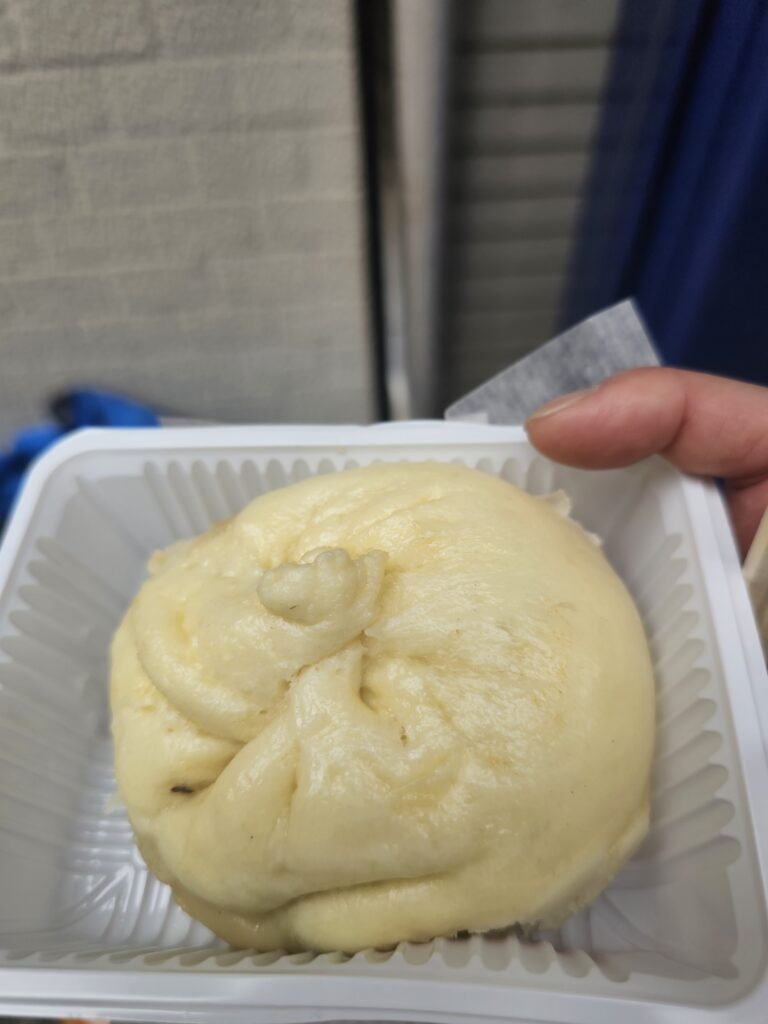

The last street food I got was pork soup dumplings (500 yen, $3.10 USD). Let’s be honest, soup dumplings are a must if they’re available! For $3.10 USD you got 6 dumplings. These were freshly made and came out piping hot. Pretty simple dumplings, with seasoned ground pork and quite a lot of soup in each dumpling. The dumpling skins were just the right thickness and you could tell these were fresh. Overall, pretty simple but quite tasty and enjoyable.
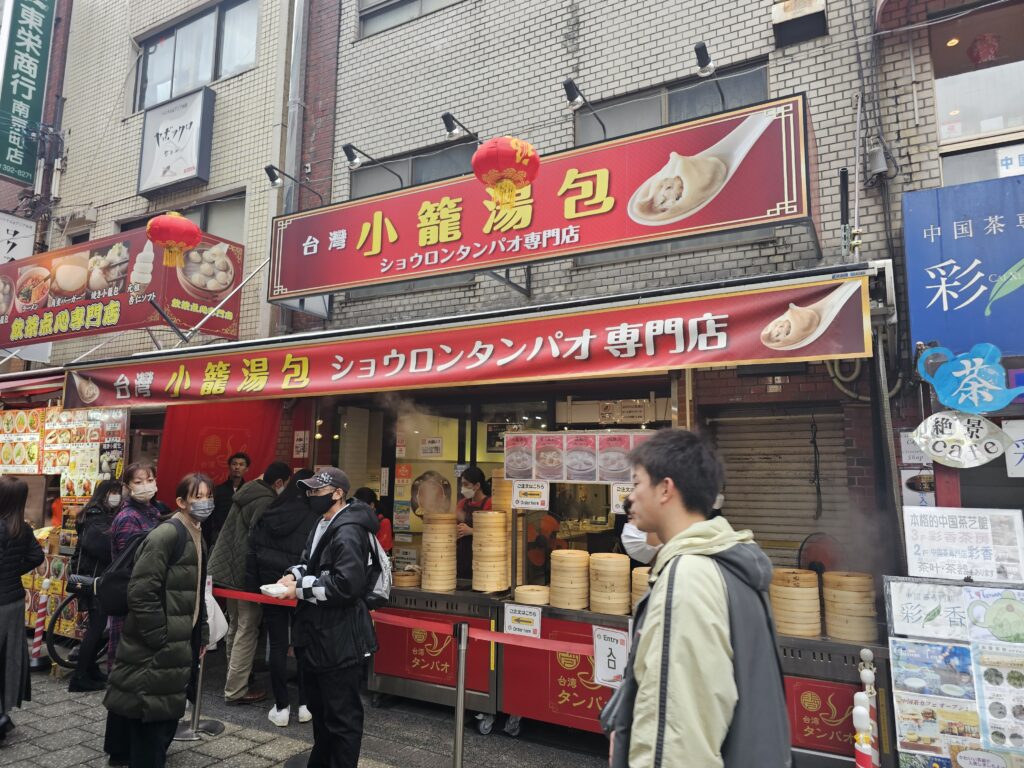

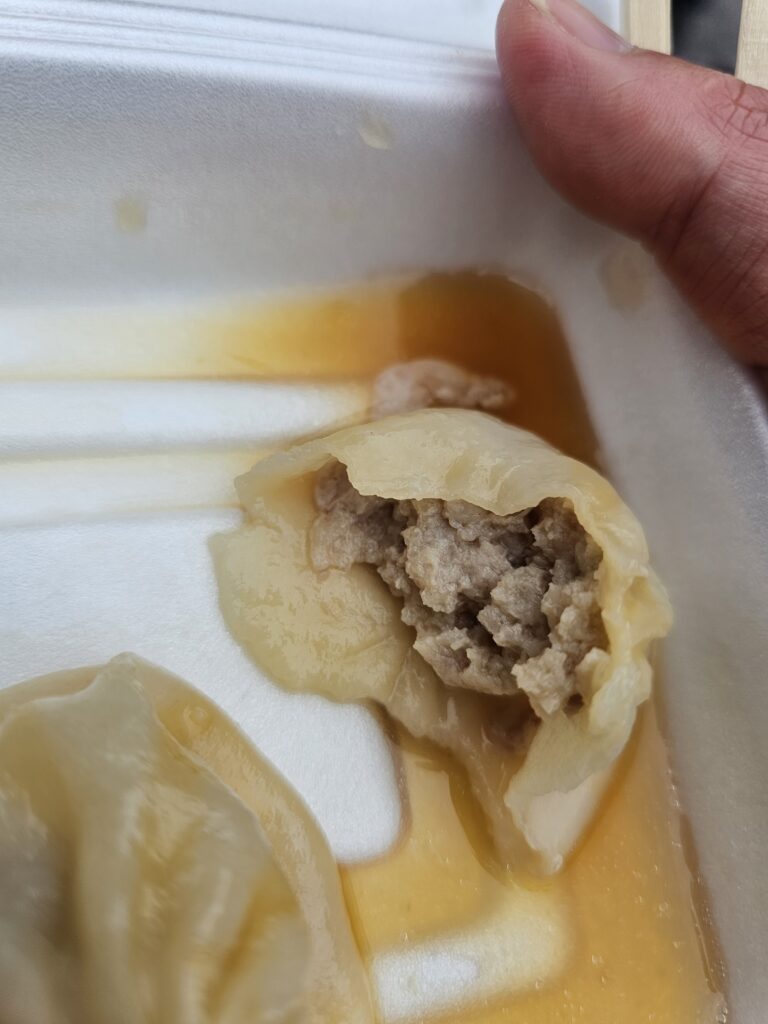
Is Nankin-machi Worth Visiting?
If you’re doing a day trip to Kobe from Osaka or Kyoto, Nankin-machi is worth a visit. There’s a TON of food options here. If you’re craving some Chinese street food, this is the place to go. Not only are there plenty of food options in a small area (you’ll be able to save your feet from a ton of walking) but the food is also relatively cheap. For all the food I ate that afternoon I spent a total of $9.30 USD.
That’s quite a lot of food for less than $10 USD!
If street food isn’t your thing, there’s also some restaurants that are quite popular here. They had VERY long lines, even their to go windows. Not sure what the restuarants were, or what kind of food they had, but they were definitely popular. Since I was only spending the day in Kobe I didn’t want to wait, but was certainly curious. Maybe next time!
-
Discover Ikkakuya: A Good Tonkatsu Ramen Spot in Tokyo
If you find yourself wandering around the Ikebukuro / Toshima City area and have an grumbling stomach, there are, of course, no shortage of options to be had in this busy area. I was craving a nice bowl of tonkatsu ramen though, so I was glad I knew exactly what I was looking for and not wandering around having a difficult time choosing what to eat. It was under these hungry cicumstances that I came across Ikkakuya.
Table of Contents
Ikkakuya
Ikkakuya is a large nationwide ramen chain. Known for their tonkatsu ramen, Ikkakuya also offers a variety of different types of bowls with various toppings you can choose from. The location I went to had the automated ordering machine in the front which you order from. Luckily, there was an English button you could select and easily create your order with. Those machines, common in Japan for ramen shops, can be a little intimidating if there’s a long line and no English options, so when there’s an option for English, it’s always a very welcome sight!
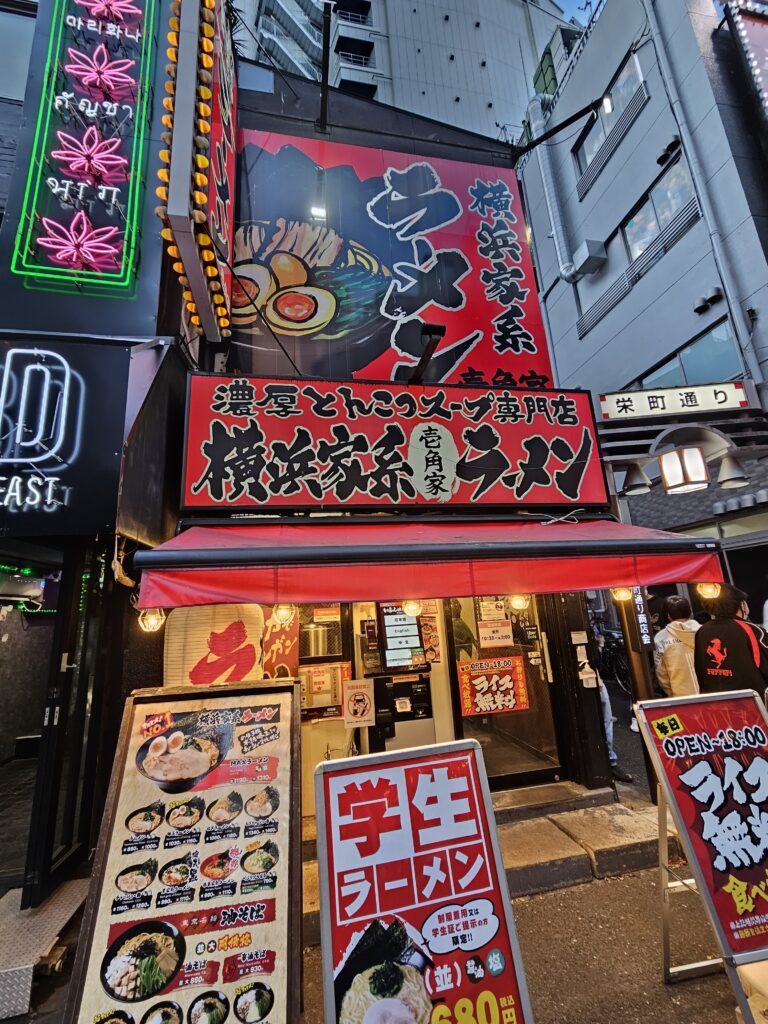
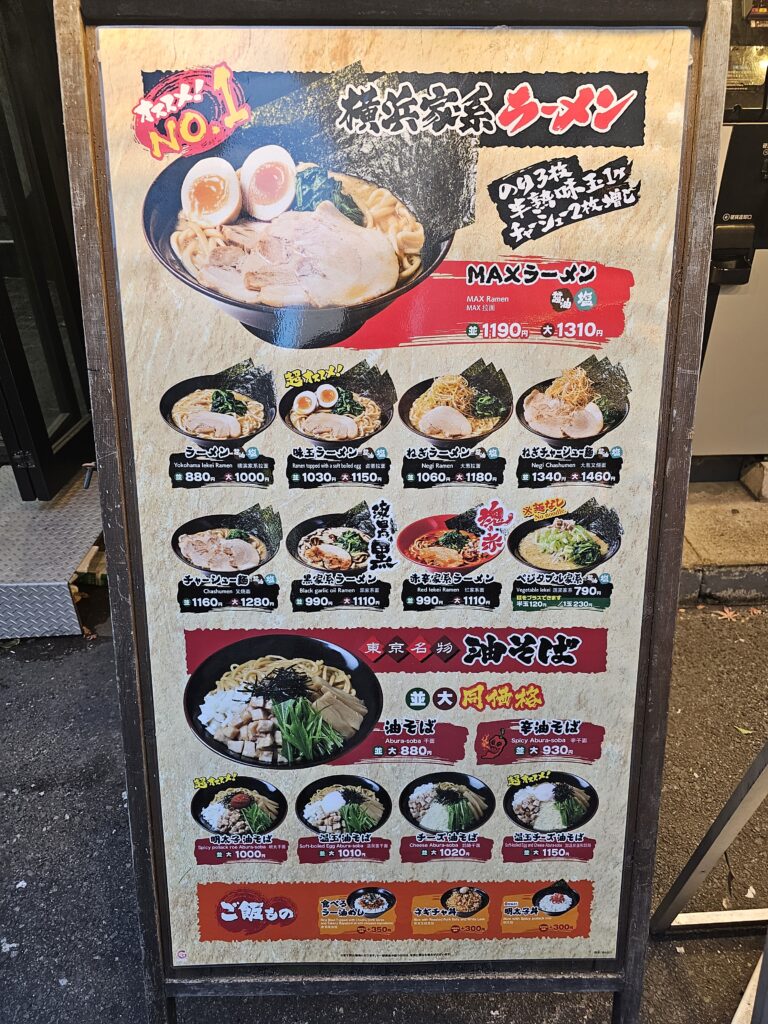
The Ordering Experience
I opted for the Max ( I mean it’s the No.1 option per this billboard!) which was 1310 yen, $8.30 USD. This bowl of tonkatsu ramen included three pieces of chashu, six pieces of seaweed, and a flavored egg. On top of that I also got a ground pork rice bowl for 350 yen ($2.22 USD) as a side dish.
The restaurant is very tiny, like many ramen restaurants. It was just a narrow countertop facing the kitchen with stools. I came at a weird time, a little bit before 5pm so (fortunately) it was not very busy.
I handed a cook my ticket from the ordering machine and boom the bowl of tonkatsu ramen and ground pork bowl came out within 5-10 minutes. It was extremely fast, which I was grateful for since I was starving!
The Food Experience
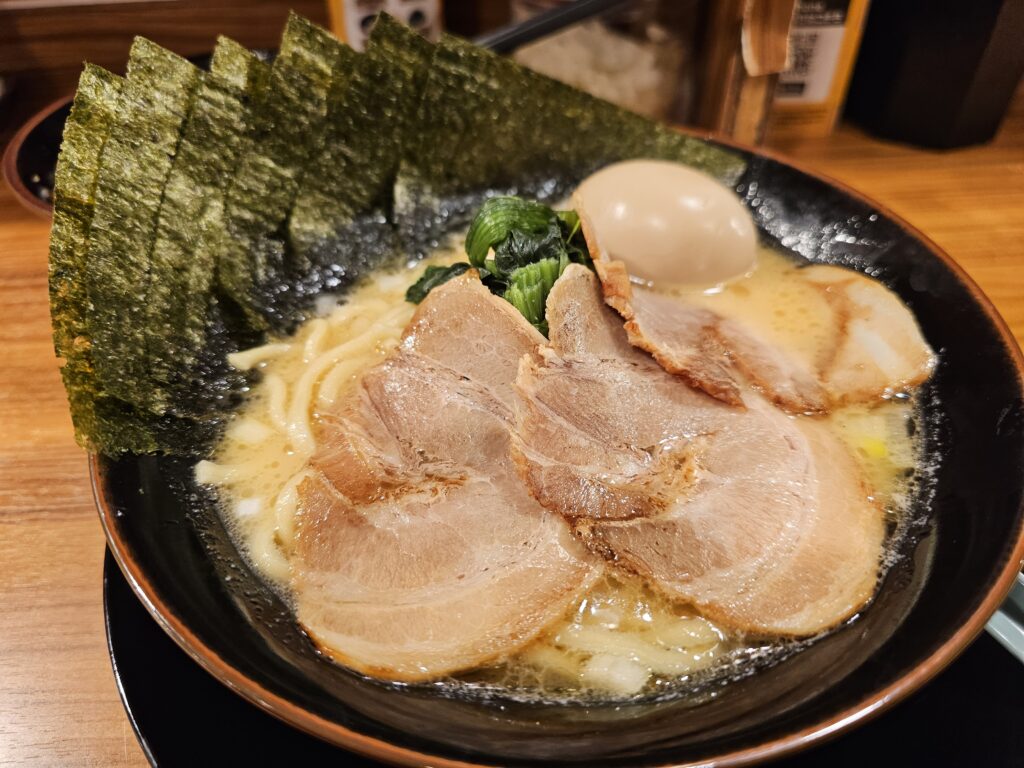
I loved the presentation of the tonkatsu ramen bowl with the pieces of seaweed lining the bowl like shown above. That’s the first thing I noticed. The chashu looked like it had a nice little char on it so I was looking forward to giving it a try. The broth also looked quite oily at first glance and noodles looked fairly thicker for ramen noodles.
The first thing I always do with a fresh bowl of ramen is to give the broth, without any additioinal spices I generally toss in there, a taste.
The broth was very rich and savory. It had a deep, porky flavor to it. Definitley a little oily and salty as well.
This was a very thin chashu, it did have a nice little char to it and was very tender. It was quite salty as well. The chashu wasn’t too bad but it wasn’t the best either. The saltiness of it stood out, which isn’t the best attribute you want to stand out.
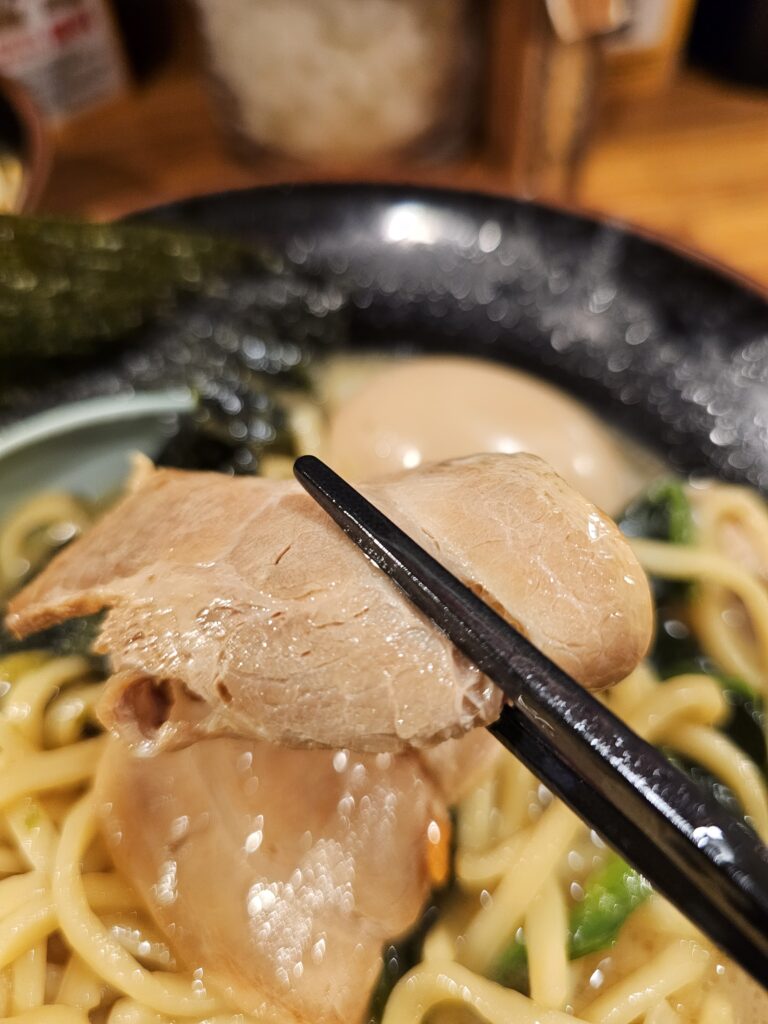
The noodles were definitely a bit thicker that what I’d seen at other ramen spots, not necessarily a bad thing as the noodles were al dente and tasted fresh.
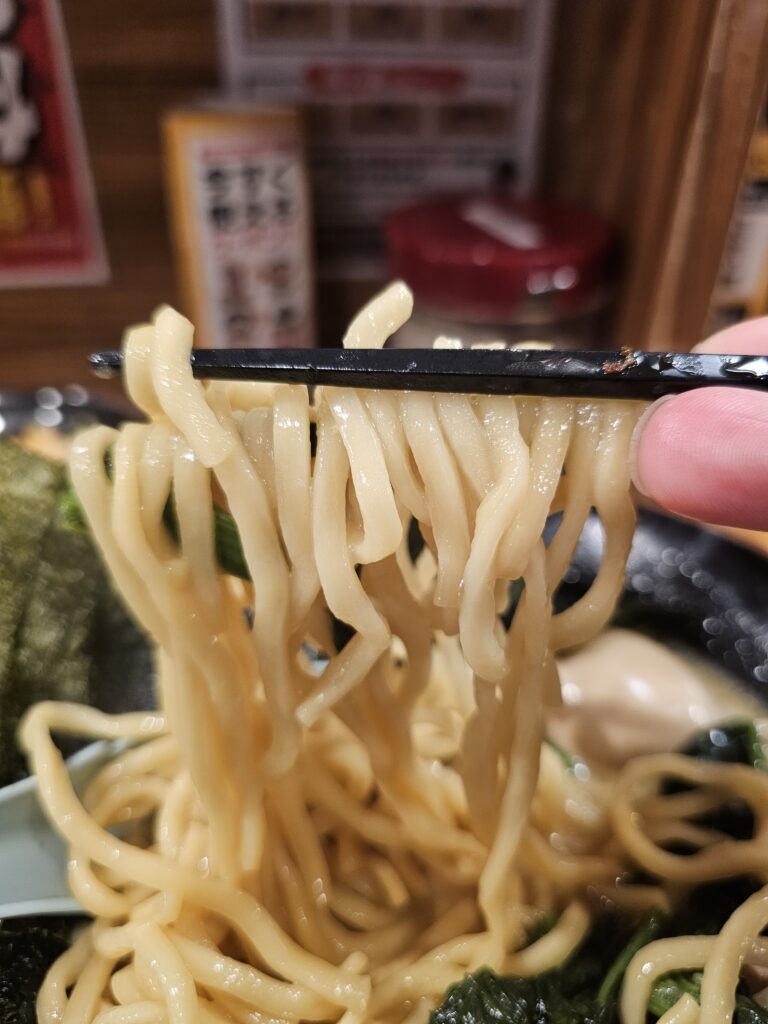
The egg was nice and creamy and as usual at Japanese tonkatsu ramen shops quite tasty.
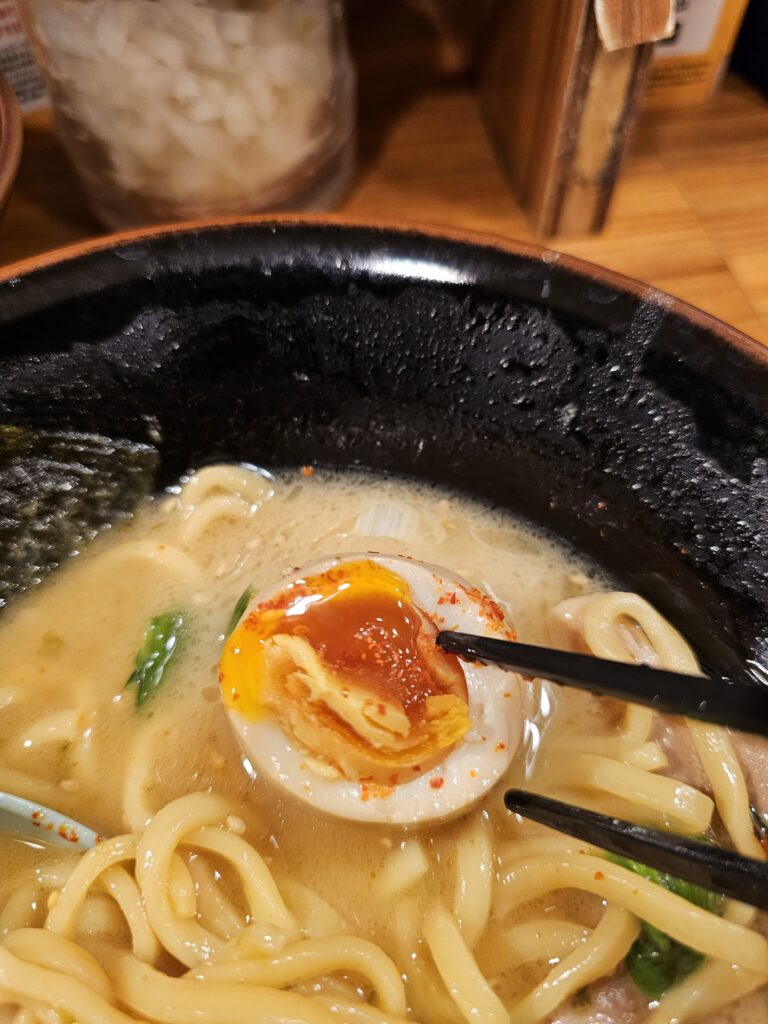
In addition to the tonkatsu ramen, I also got a ground pork bowl as a side. I wasn’t entirely sure what the the pork was mixed in with. It looked like it was some chili oil sauce but there was no spice at all. This was also pretty salty. It was decent, but nothing to write home about.
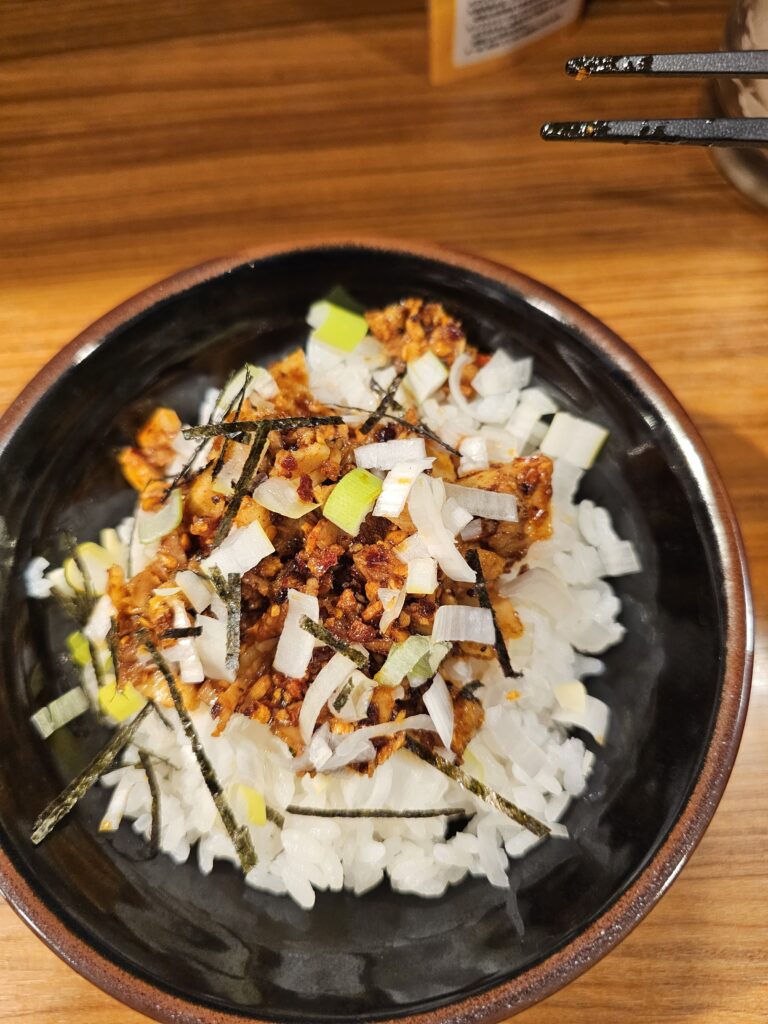
Final Thoughts
If I doled out ratings for food on a 1-10 scale, I’d give Ikkakuya a solid 6. It’s not a place that really stood out for the better or worse. The bowl of tonkatsu ramen was huge, so you definitely get your money worth for the price (1310 yen, $8.30 USD). The noodles were really good but the chashu was a little thin and overly salty for my taste as well as the broth. The pork bowl was, again, solid but didn’t really stand out in any way either. It was a nice complement with the ramen but it was also a little salty. I’d probably just get a regular side of rice to eat with the ramen if I were to swing by Ikkakuya again.
If you’re looking for some fast and efficient tonkatsu ramen, Ikkakuya is a good choice. It’s pretty good but not a place you should go out of your way to try and get!
-
Popular Comfort Food Hamburg Steak Is A Mainstay At This Osaka Resturant
Hamburg steak is a very popular food in Japan. Enjoyed by all generations and especially popular amongst children, hamburg steak is very much a comfort food throughout Japan.
It’s basically a meat pattie consisting of a combination of both ground pork and ground beef, sauteed onions, egg to bind everything together, and bread crumbs. This combination creates the juicy and tender Japanese hamburg steak.
The sauce generally consists of a blend of Worcestershire sauce, ketchup, and Japanese sake creating a flavorful sauce to coat the hamburg steak.
Sides generally include potato salad and /or rice.
Table of Contents
Grill Ron
Hamburg steak was not something that I had eaten in many years. With it being so popular in Japan it was available at many different locations and one night it just sounded really good and I was able to find Grill Ron’s in Osaka.
Located in the basement level of the Osaka Hankyu Sanban-gai, a large mall near Osaka Station, Grill Ron has been in business for nearly half a century. It’s a small restaurant and there was about a 20-minute queue when I went around 6pm. It’s quite convenient that they have stools lining the front of the restuarant so you can sit while you wait, which after a long day of touring is quite nice and very welcome!
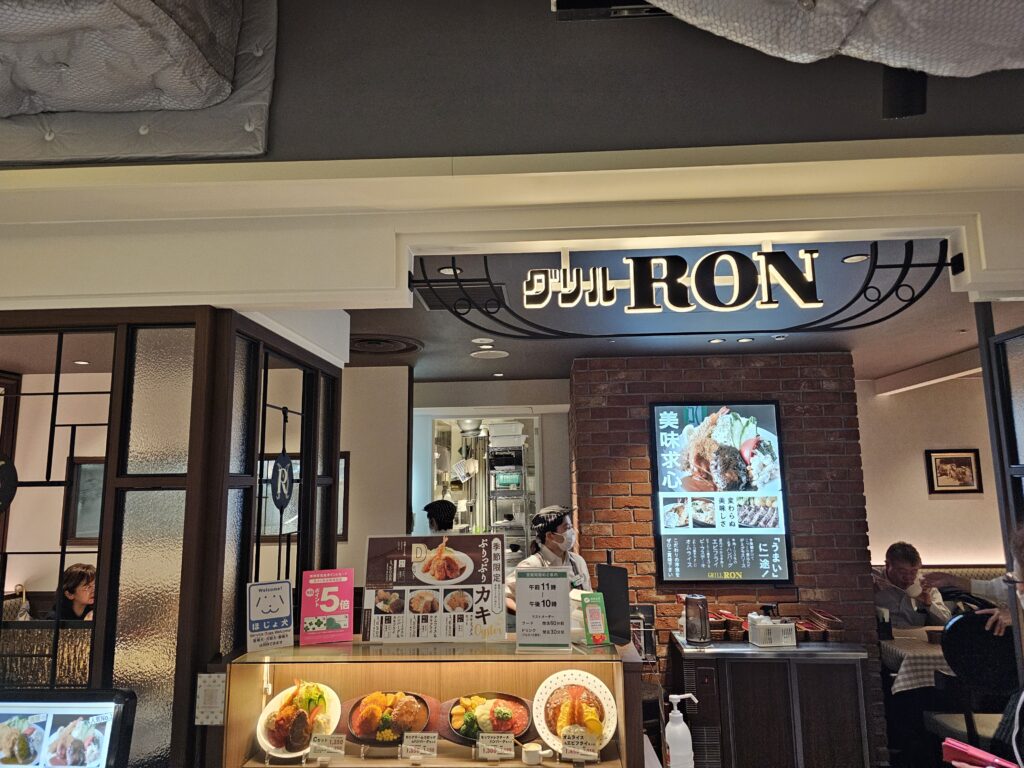
I came here for the hamburg steak and it’s certainly a prominent item on their menu. They have a few different options to choose from three different sets with different sides to choose from. Having an English menu was also a huge plus!
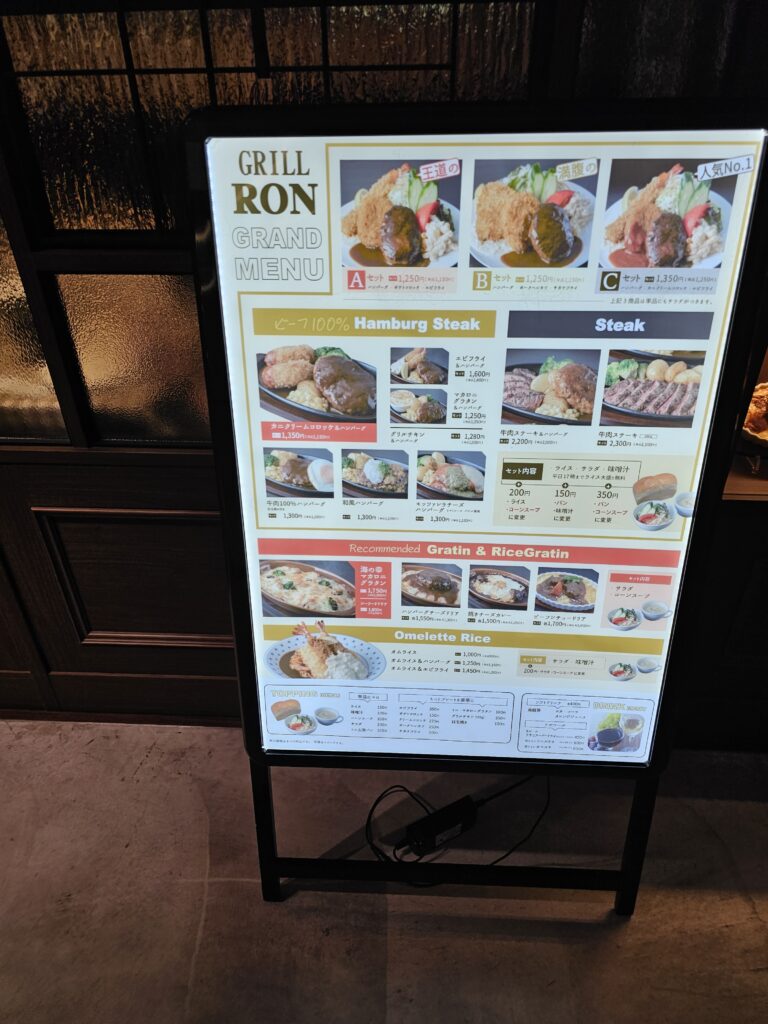
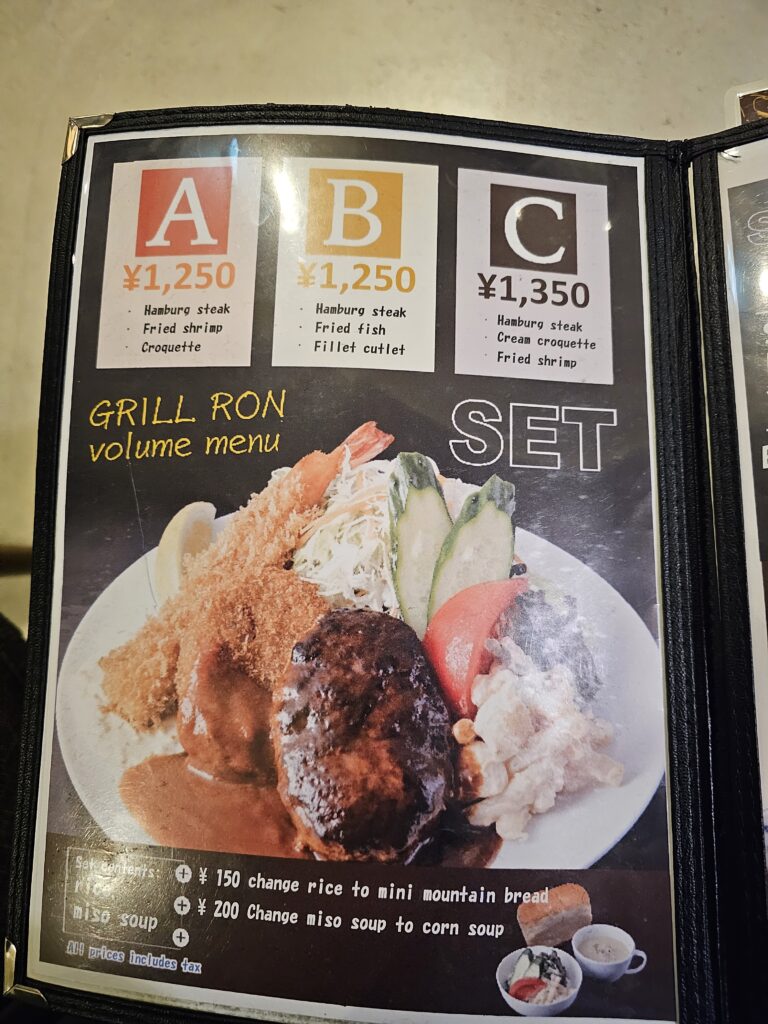
I went with the A Set which included a hamburg steak, fried shrimp, and croquette (1,250 yen, $7.77 USD). This also included a side of rice and miso soup. Quite a deal for $7.77!
The Food
The presentation on the plate is quite nice with the hamburg steak, croquette, and fried shrimp all lined up nicely. By American terms, the hamburg steak is a little small, BUT I mean, we tend to over do things food related, so this hamburg steak is probably sized correctly lol. It did however stand out to me initially.
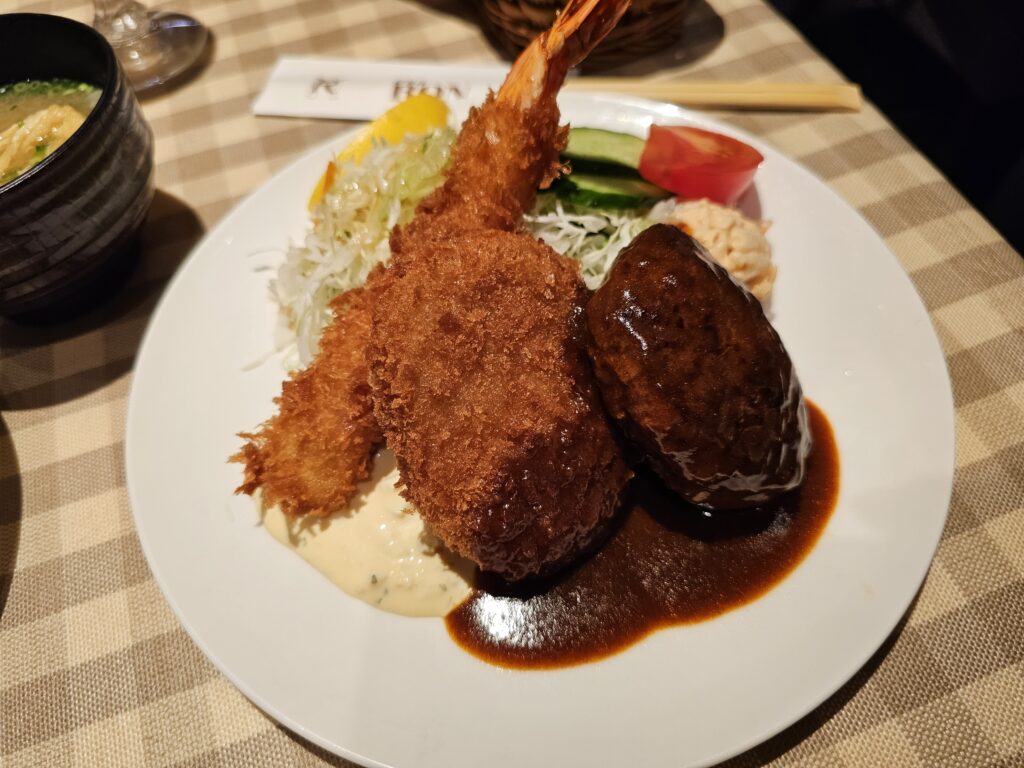
The hamburg steak was really lean and extremely juicy. It paired well with that brown Worcestershire, ketchup, and Japanese sake sauce which was a little a sweet, a little savory. It was quite tasty.
The croquette ended up being potato, with a perfectly crispy exterior and mushy inside. The contrast between both the exterior and interior was fantastic. It was really like a deep fried mashed potato pancake. Dipped in some of that sauce really made it quite tasty as well!
Finally, the shrimp. First off, the shrimp was quite large. Fried to perfection, it was nice and crispy and the shrimp was very swee. Definitely a nice addition to this set. It comes with what is basically tarter sauce for dipping sauce.
Is It Worth A Visit?
Overall, this was a good meal, especially for the price. I liked the different combination of flavors and textures with the fried shrimp, hamburg steak, and potato croquette. Throw in some potato salad, some cabbage, rice, and miso soup, and this was quite a lot of food (yes, even with the “smaller” hamburg steak!)
Grill Ron has been around for a very long time and they know what they’re doing. If you’re in the area and craving a hamburg steak it’s certainly worth stopping by and grabbing a delicious, budget conscious meal.
Grill Ron
Address: 1 Chome-1-3 Shibata, Kita Ward, Osaka, 530-0012, Japan
Hours
Monday 11 AM–10 PM Tuesday 11 AM–10 PM Wednesday 11 AM–10 PM Thursday 11 AM–10 PM Friday 11 AM–10 PM Saturday 11 AM–10 PM Sunday 11 AM–10 PM -
Discover the Best Kobe Beef Bowl Near Himeji Castle
If traveling to Himeji to visit the fantastic Himeji Castle, Kushiyaki Kobe Beef, a tiny restaurant located on Otemae Street, is a place you will defintely want to stop by to grab lunch or dinner to sample their kobe beef bowl!
Table of Contents
Kushiyaki Kobe Beef
This tiny hole in the wall restaurant has an ideal location if you’re visiting Himeji Castle. If you’re coming from Osaka or Kyoto on a day trip you’ll most likely be coming in from the Himeji Station. Once you leave the station, the main street it exits to is Otemae Street which will take you right to Himeji Castle.
Conveniently located on the left hand side right before you cross the street over to the castle grounds is where Kushiyaki is located.
This is a very tiny location, with a counter top and six total seats within it. You can also order something to go from the window in the front of the store, which is what I did since there was no seating available at the time I went. One of the most popular items sold is the kobe beef bowl.
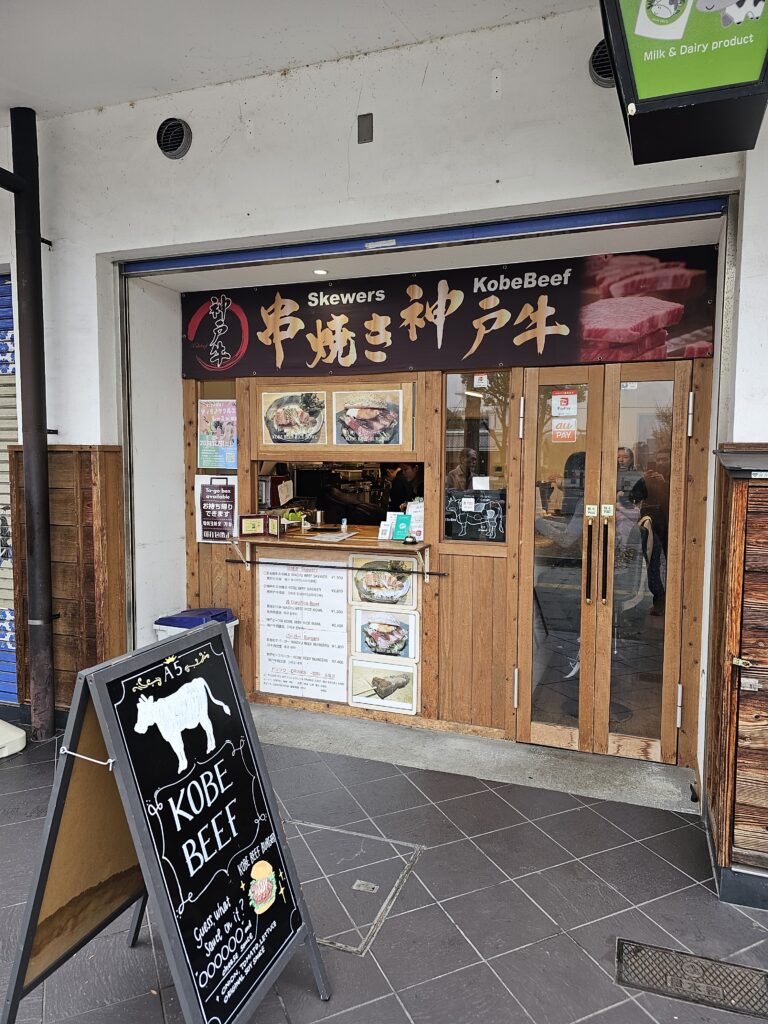
As the name would imply, Kushiyaki Kobe Beef has a menu featuring kobe beef items. They also have wagyu and karubi items as well. The menu here is pretty small with skewers, rice bowls, and hamburgers, but that’s all they really need.
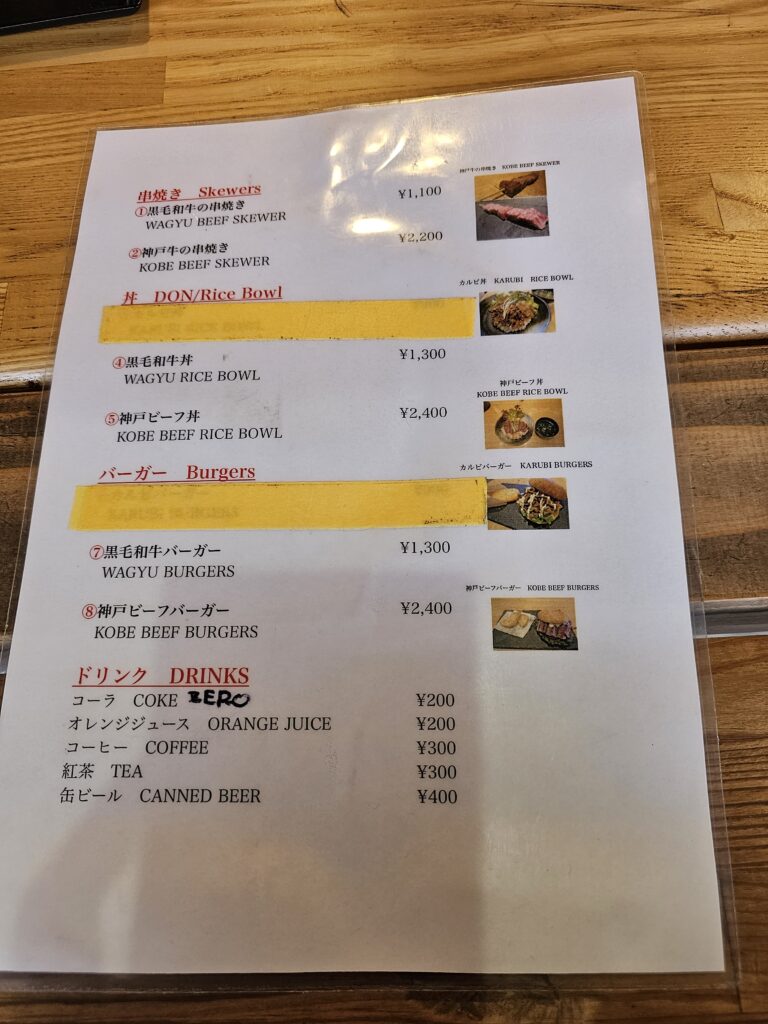
The burgers here were quite tempting. I mean a wagyu and kobe beef burger? Sounds pretty amazing, but I really wanted to enjoy and savor the meat itself, so I went with the kobe beef bowl – 2,400 yen, $14.93.
The Kobe Beef Bowl
The bowl itself is not very large. Since this was kobe beef I wasn’t expecting to be getting a huge portion though. It’s a simple dish: about 8 slices of kobe beef over a bed of rice with teriyaki sauce and some garnish. I was definitely excited to dig into this!
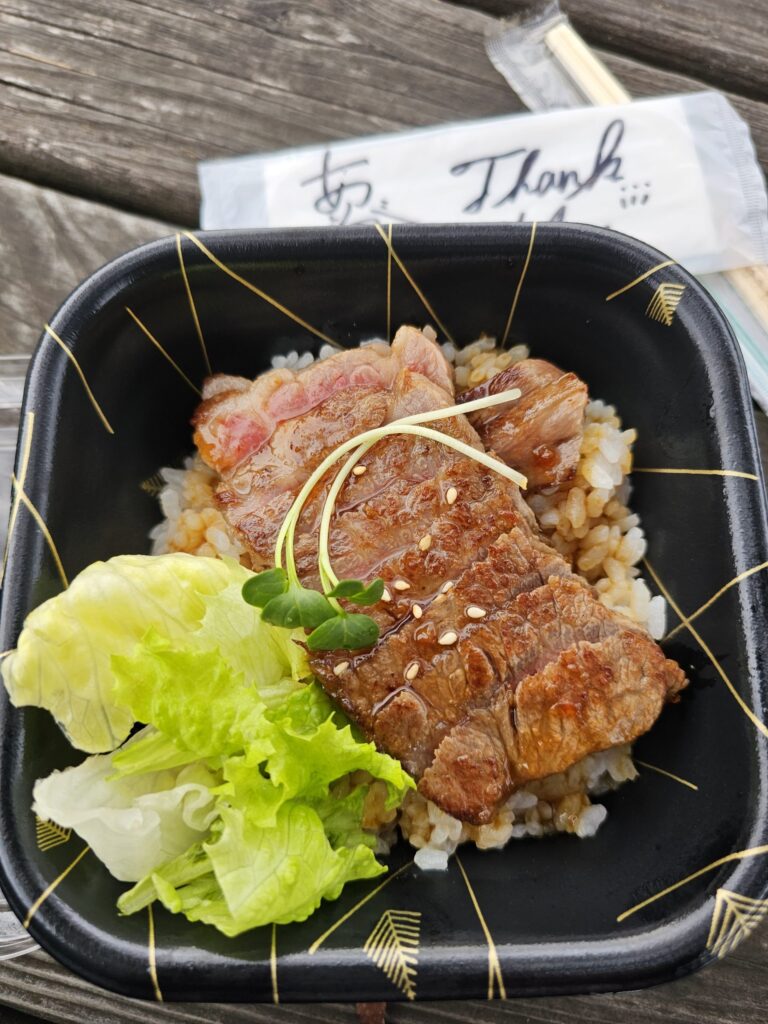
To put it simply the kobe beef was AMAZING. THe meat is grilled medium rare. It’s lightly seasoned, just seemed salted but that’s all it needs. It’s extremely tender, juicy, and literally melts in your mouth. There really isn’t much chewing involved. The meat literally melts in your mouth. I can’t recall having any kind of beef like this before. It was certainly an experience.
The rice of course goes well with this and adds some filler. It’s great that they drizzle some teriyaki sauce over it to add some flavor but keep it separated fromt the kobe beef. You really want to savor the kobe beef itself so it’s nice that the don’t put any teriyaki sauce over it.

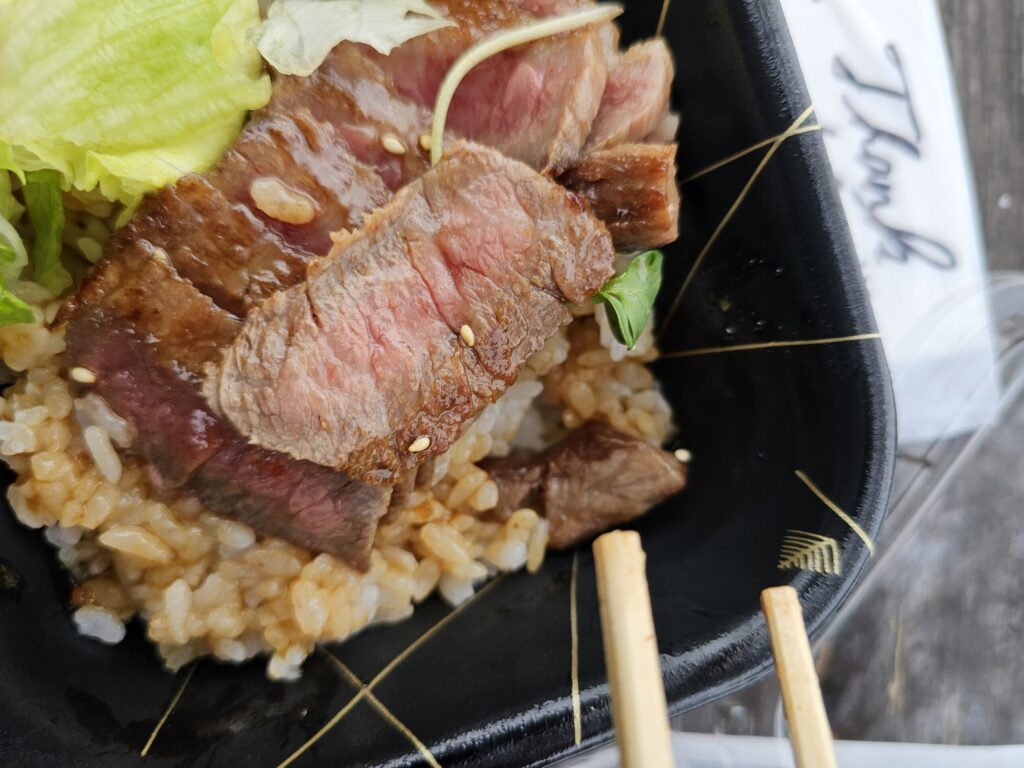
Is Kushiyaki Kobe Beef Worth A Visit?
If you’re going to Himeji Castle, I definitely recommend stopping by and grabbing the kobe beef bowl. This is legit kobe beef and worth every penny. While the servings are fairly small for the price point, the quality of the kobe beef makes it well worth it. I’ve paid more money at a sitdown grill and gotten the cheapest kobe beef option that was double this amount and the kobe beef was far and away better at Kushiyaki Kobe Beef.
If you’re looking for something light than this will be a perfect appetizer on the way to the castle or for a light meal after you’ve toured it. With it being so close to the castle and the shop having to go orders, it makes it very convenient to grab a quick delicious bite to eat!
Kushiyaki Kobe Beef
Address: Japan, 〒670-0012 Hyogo, Himeji, Honmachi, 68 にの屋敷 D 2
Hours:
Monday 11 AM–5:30 PM Tuesday 11 AM–5:30 PM Wednesday 11 AM–5:30 PM Thursday 11 AM–5:30 PM Friday 11 AM–5:30 PM Saturday 11 AM–5:30 PM Sunday 11 AM–5:30 PM
